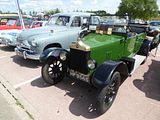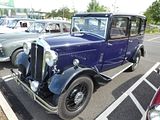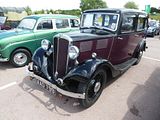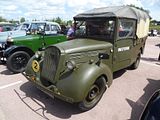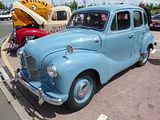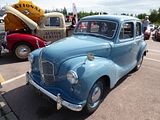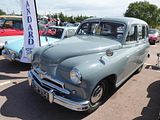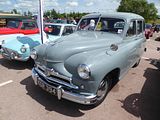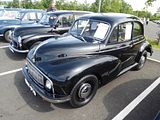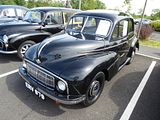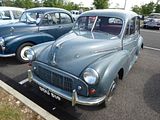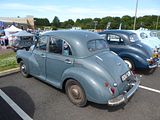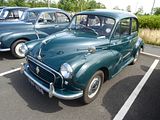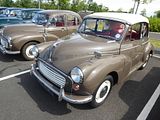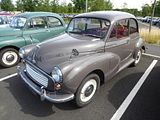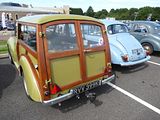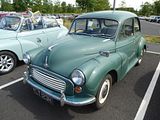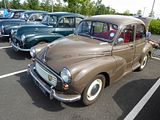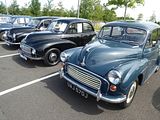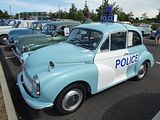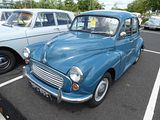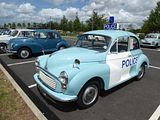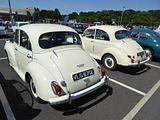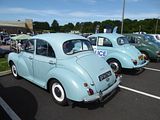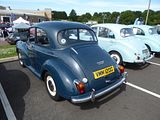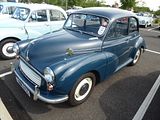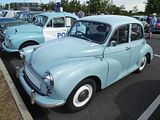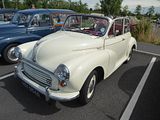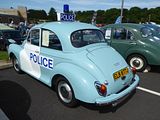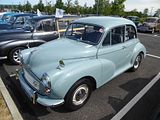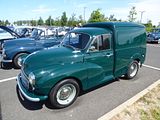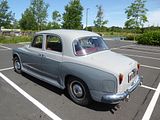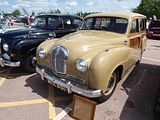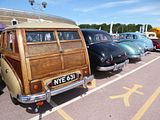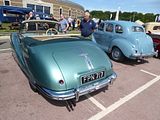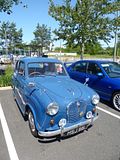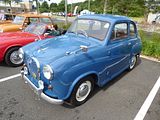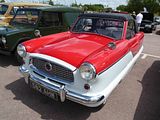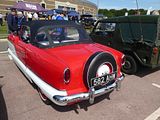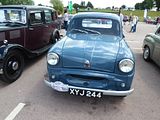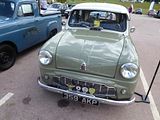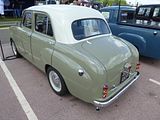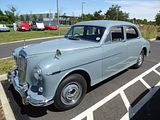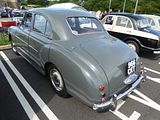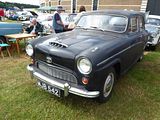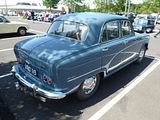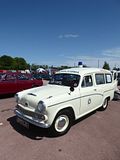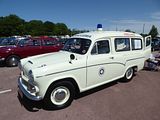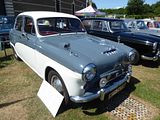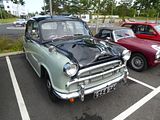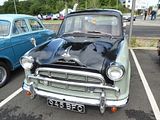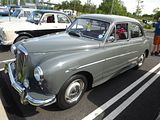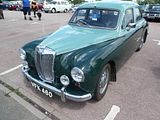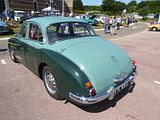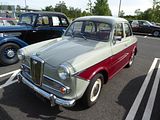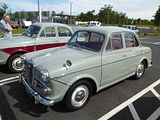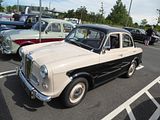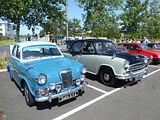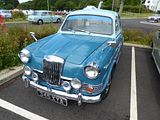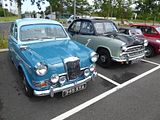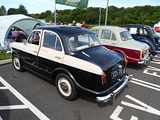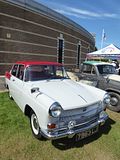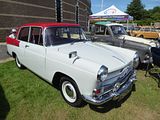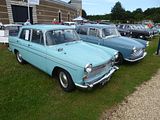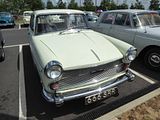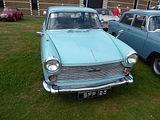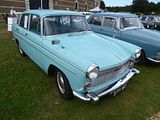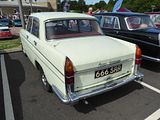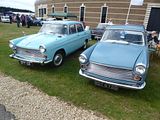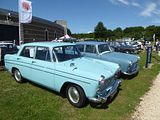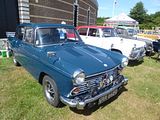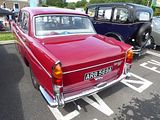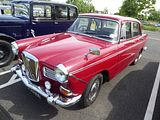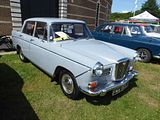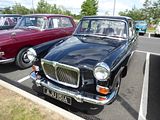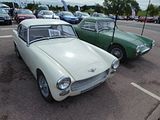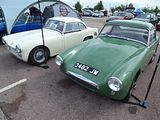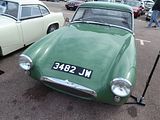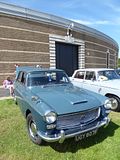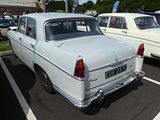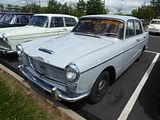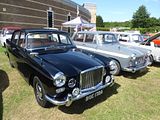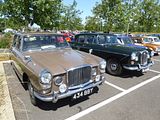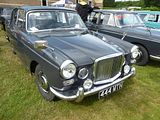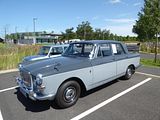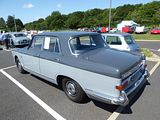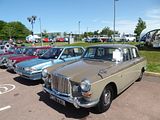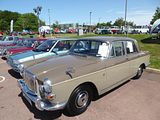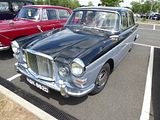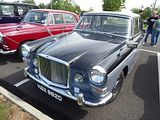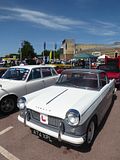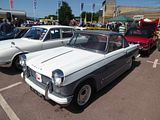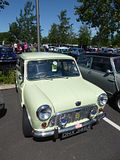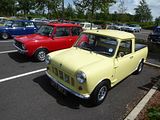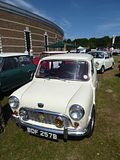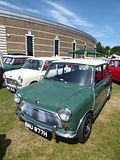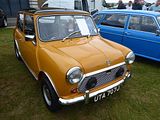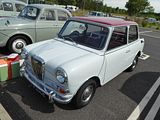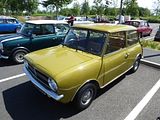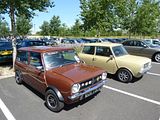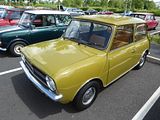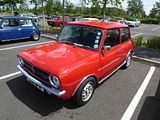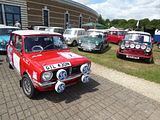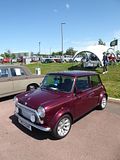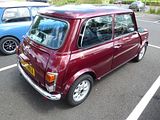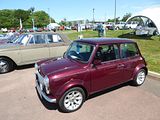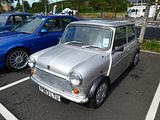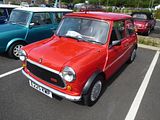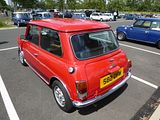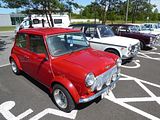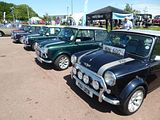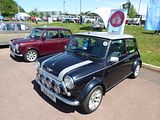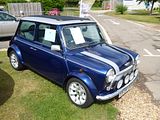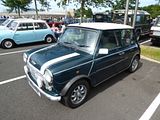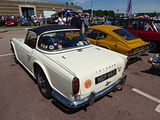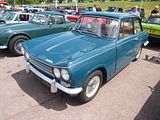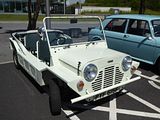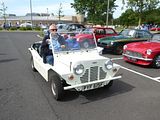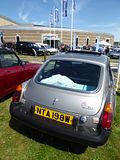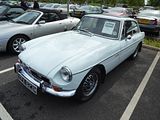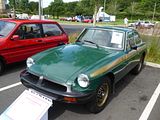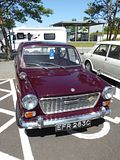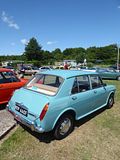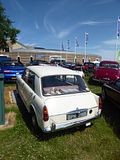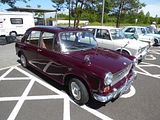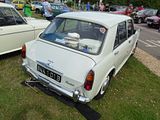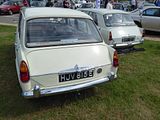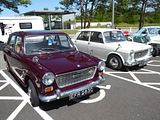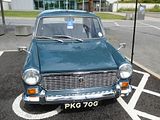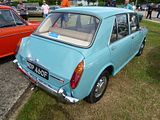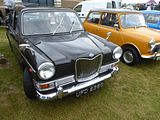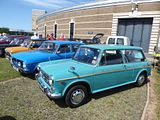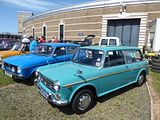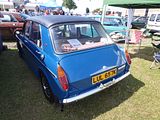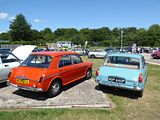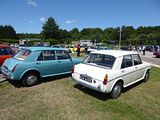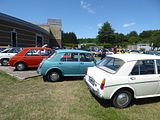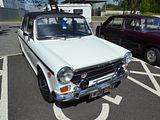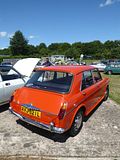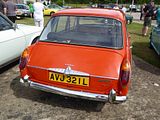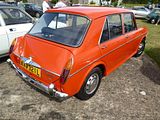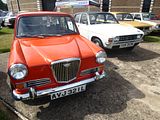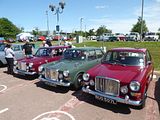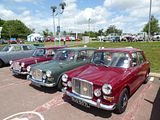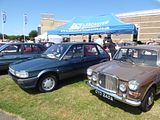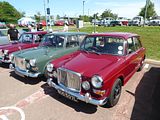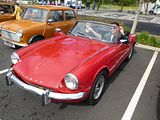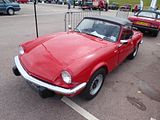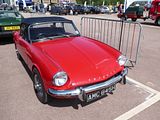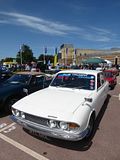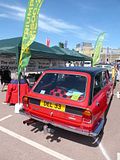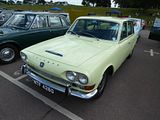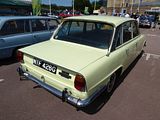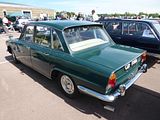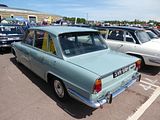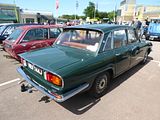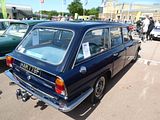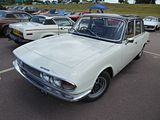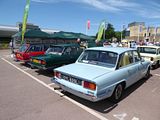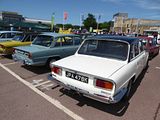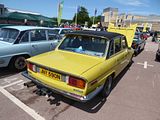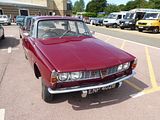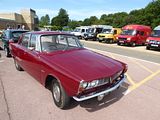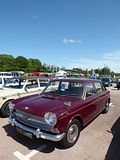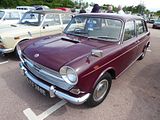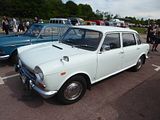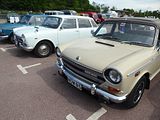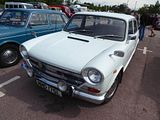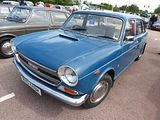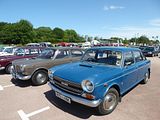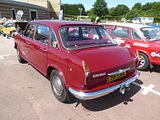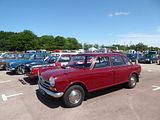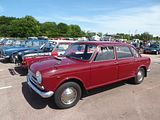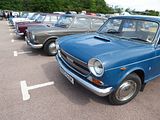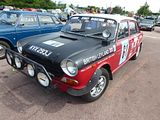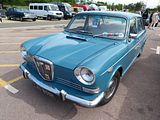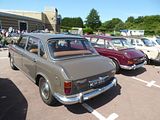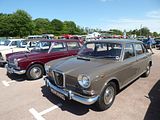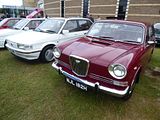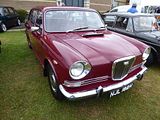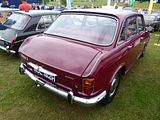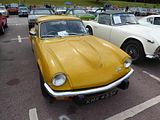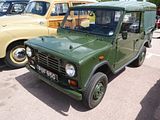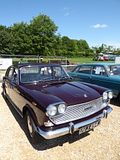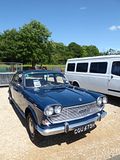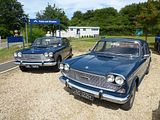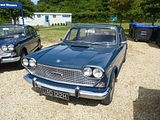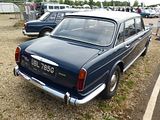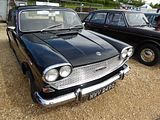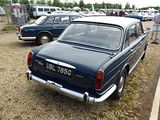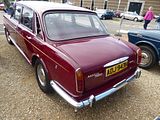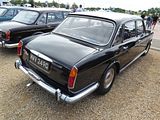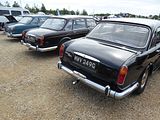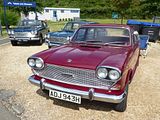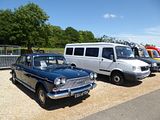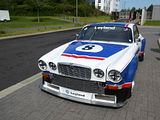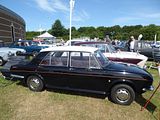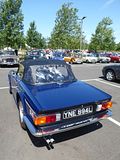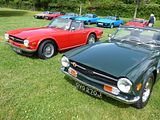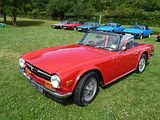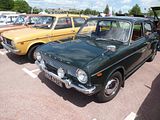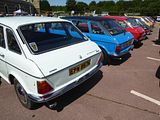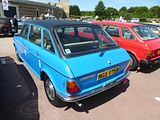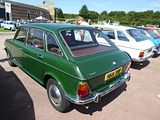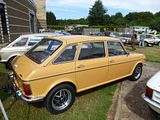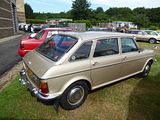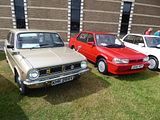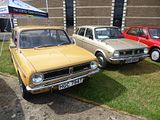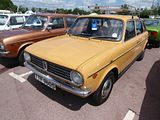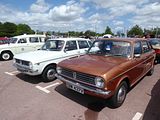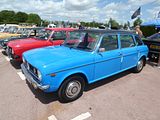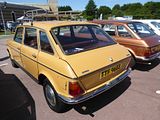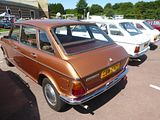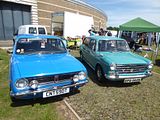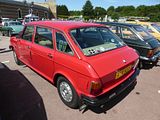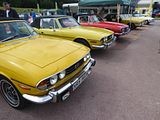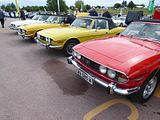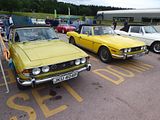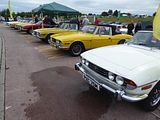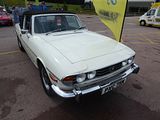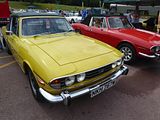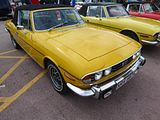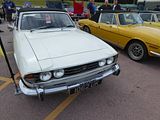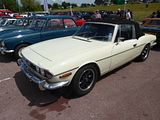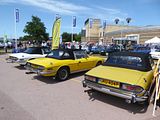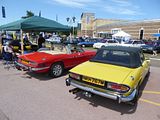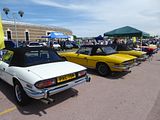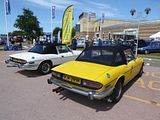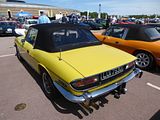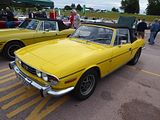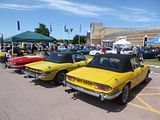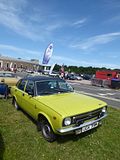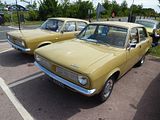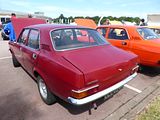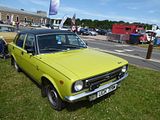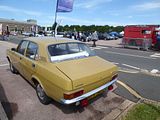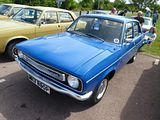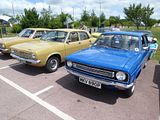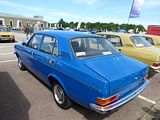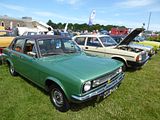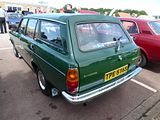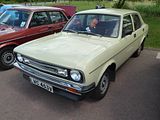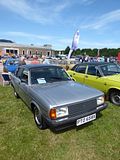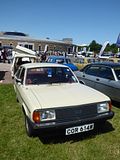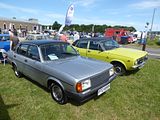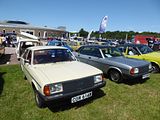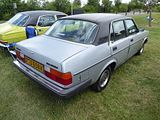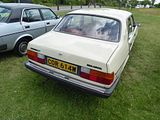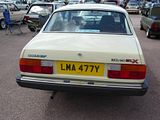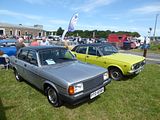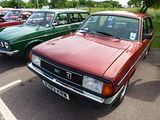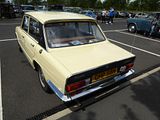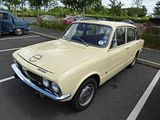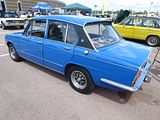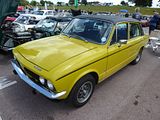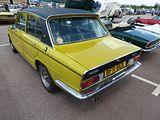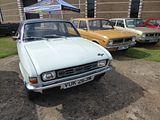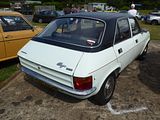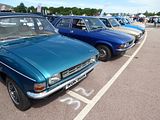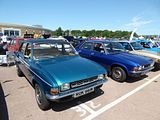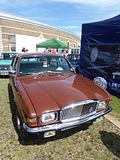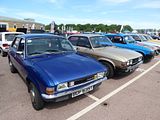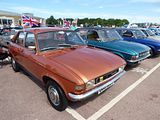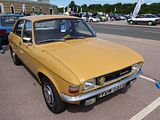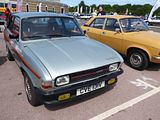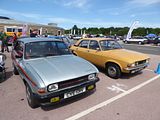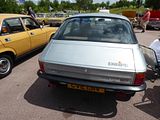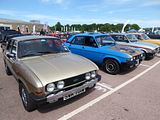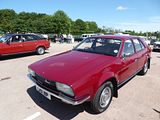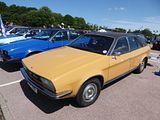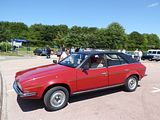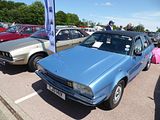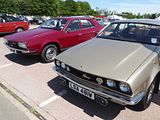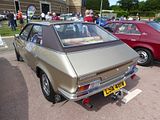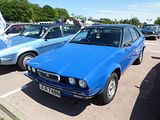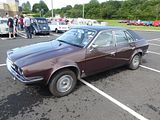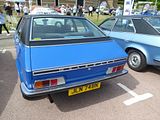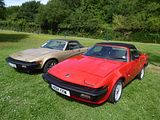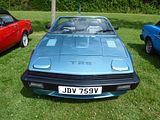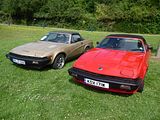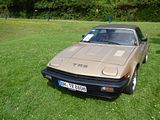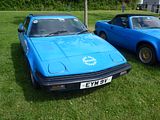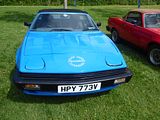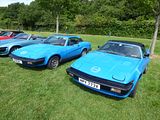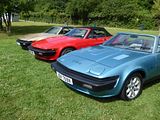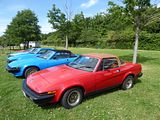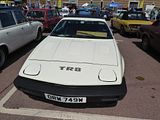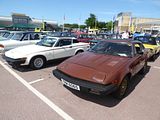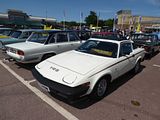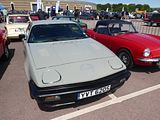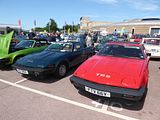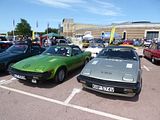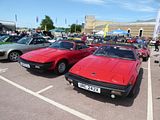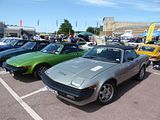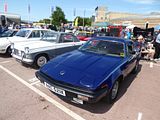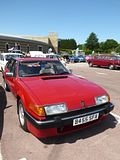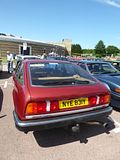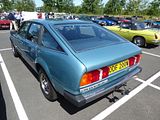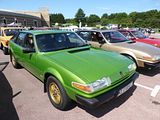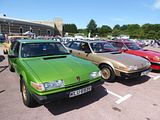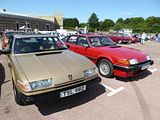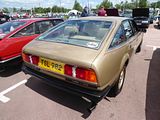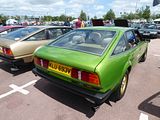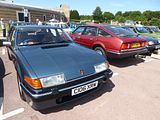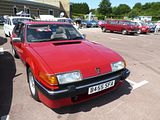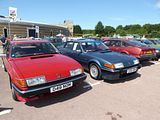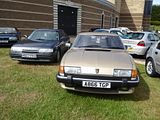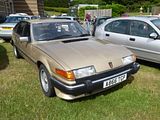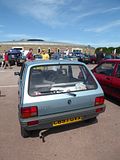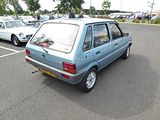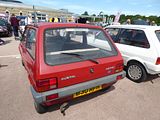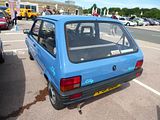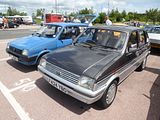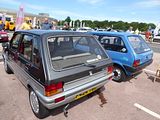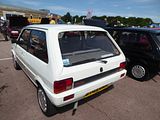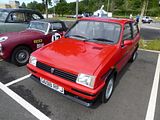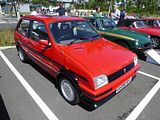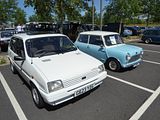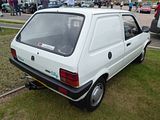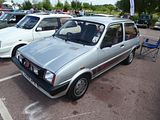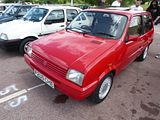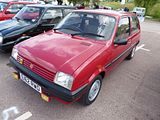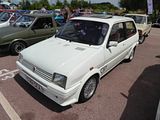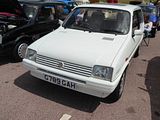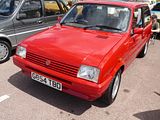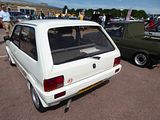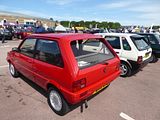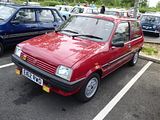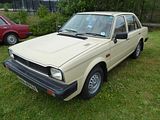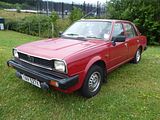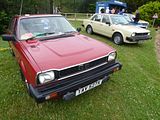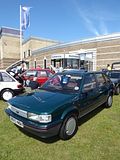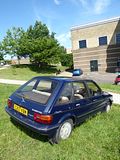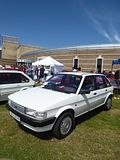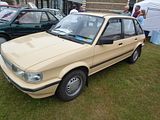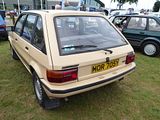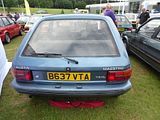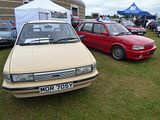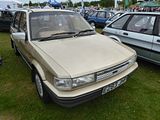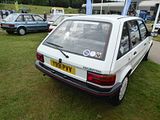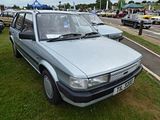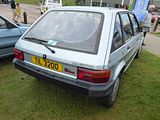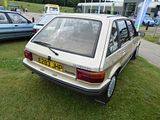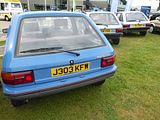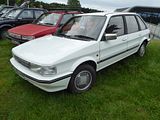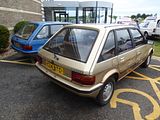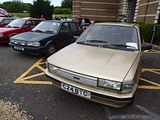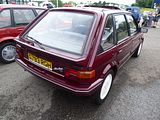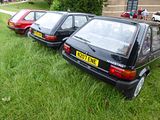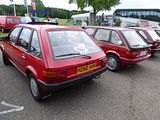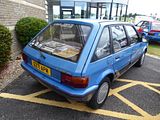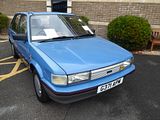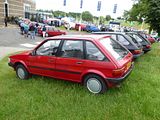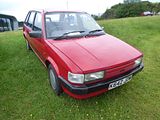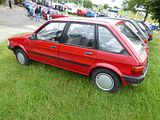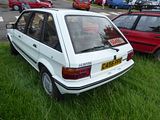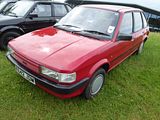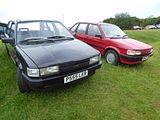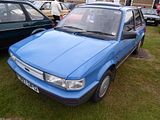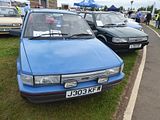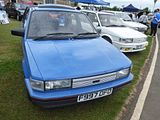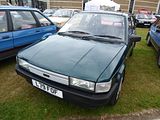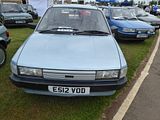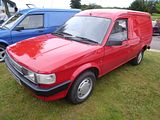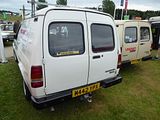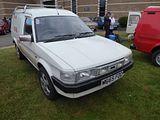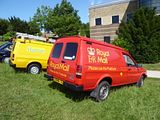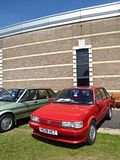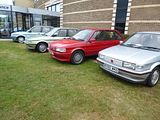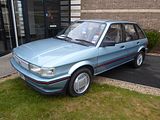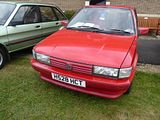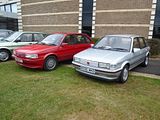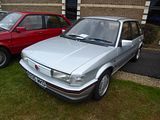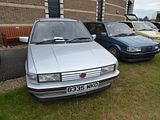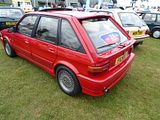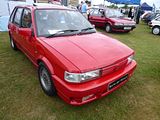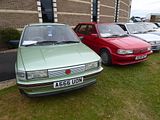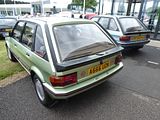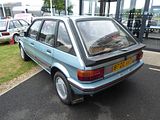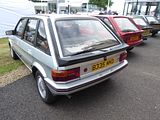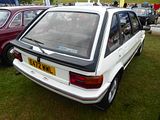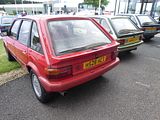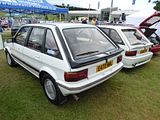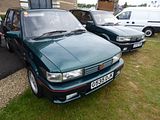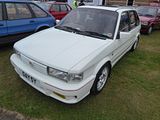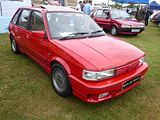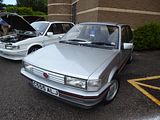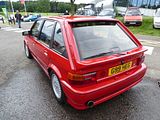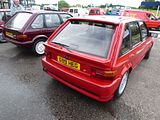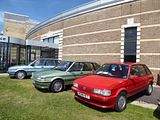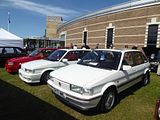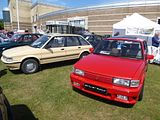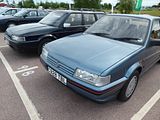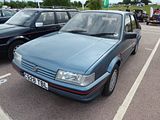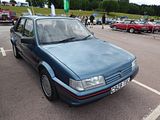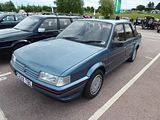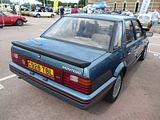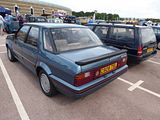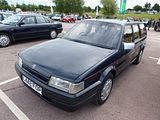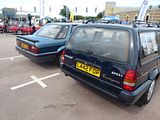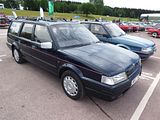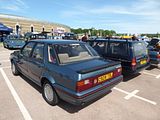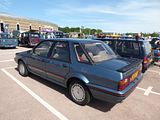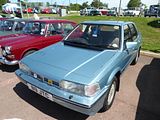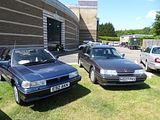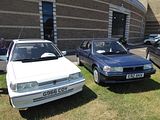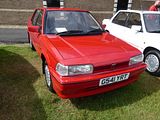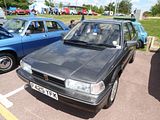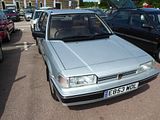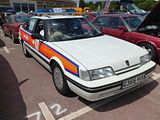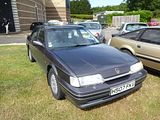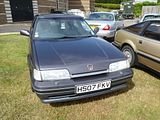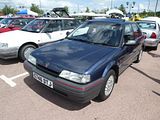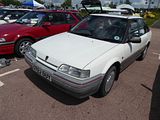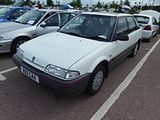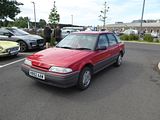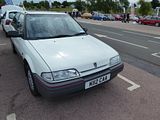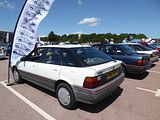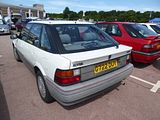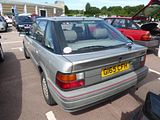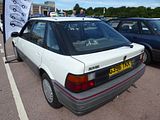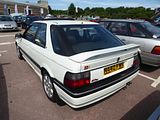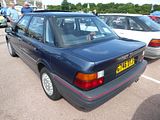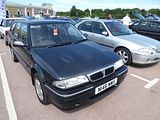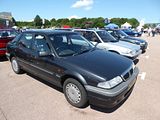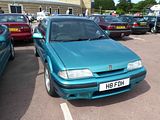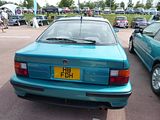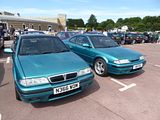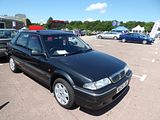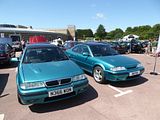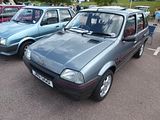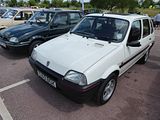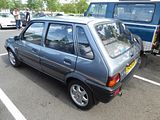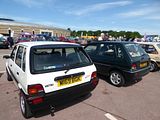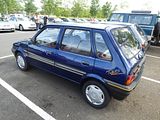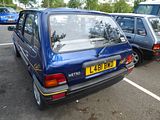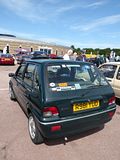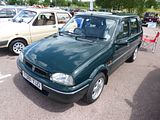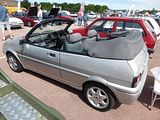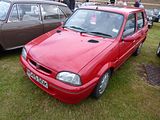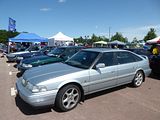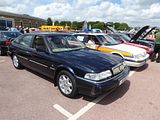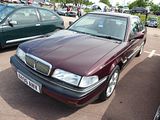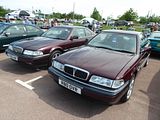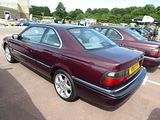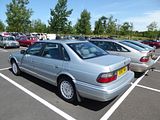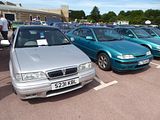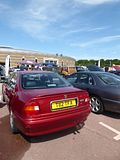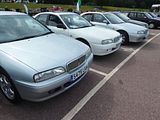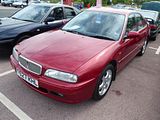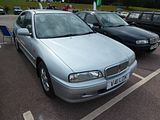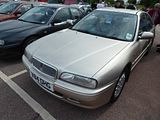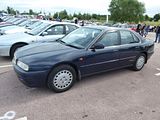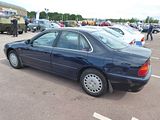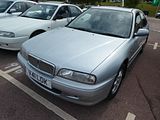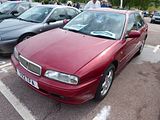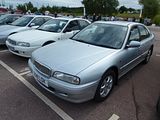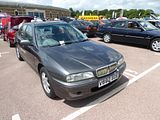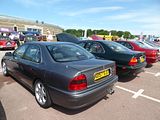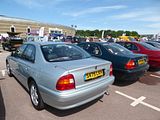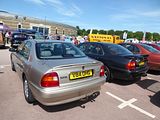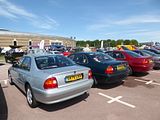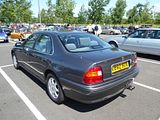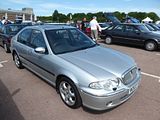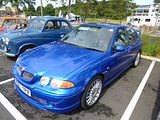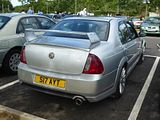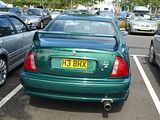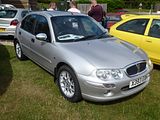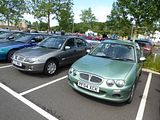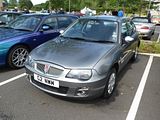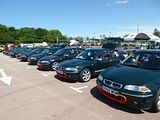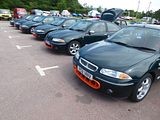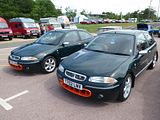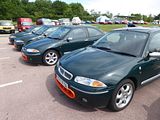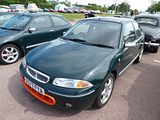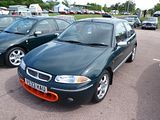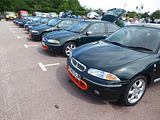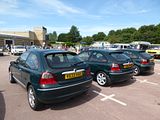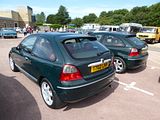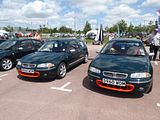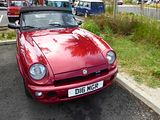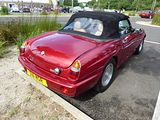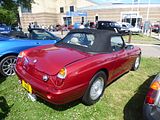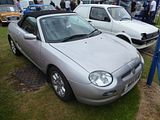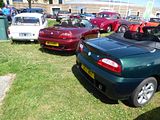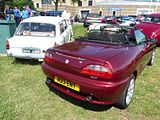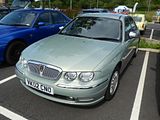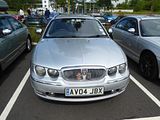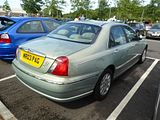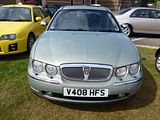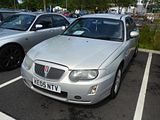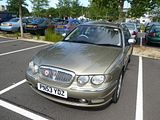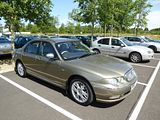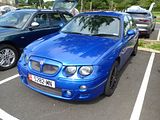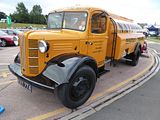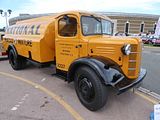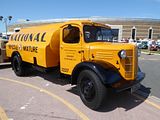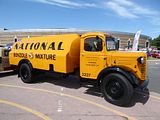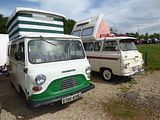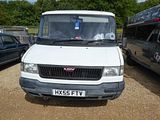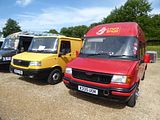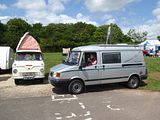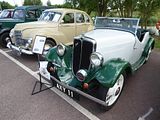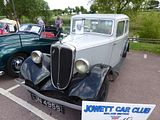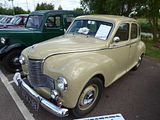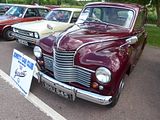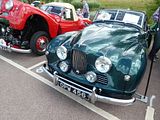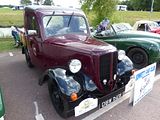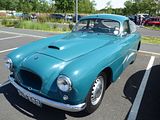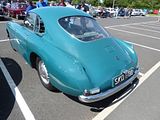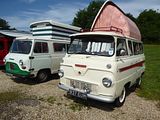It is more than 18 years now since the collapse of MG-Rover, the last company name that incorporated a vast number of once proud British marques that had gradually come together with a series of mergers and acquisitions starting well before the Second World War with the creation of the Nuffield empire comprising Morris, Wolseley and Riley and then in post-war Britain which became a lot larger with the merger with Austin to create the British Motor Corporation, before the heady days of BMC, British Leyland, BL Cars and a number of other group names. For a long time the products of these organisations were the butt of many a joke, and yet the cars sold strongly when new, and the production of them provided employment for an awful of lot of people. Engineering creativity was often challenged by poor production processes and cost constraints which saw a lot of bright ideas and new models axed long before they made it onto our roads, but these days, with more than a hint of nostalgia, there are lots of people who have one or more product from this giant of British motoring history tucked away at home, and a far greater number of people willingly come to events to look at cars that in many cars were part of their personal history. There are owners club galore, of course and these all organise their own program events, and many of them come to the NEC Classic Show in November each year, but there are also a couple of big events that bring together all the cars and Club that made up what became MG-Rover. One of them takes place at Longbridge, on the Saturday closest to that fateful 15th April when the company finally ceased trading, and the other is held at the British Motor Museum at Gaydon. Whilst the museum’s collection has been broadened to include all British or British produced cars these days, the core of the displays are still BMC, BL, Austin-Rover cars, so holding an outdoor event here seem particularly appropriate. I’ve been a few times in the past, as yes, my own car history and that of my family does indeed include some of the cars you can expect to see here, and I am of an age which means I remember an awful lot more of them from the time when they were new. I managed to fit in the 2023 event as it made for a great stop off en route back from a trip to the North East for a very different sort of event. I was particularly keen to attend this one, as among the highlights were to be special tributes to the Maestro and Montego as the former marks its 40th anniversary. Sure enough there were indeed a lot of Maestro cars here, but there was an awful lot else besides, meaning that this was a vast event which kept me entertained all day. Here is what I saw:
STANDARD 15HP
Oldest car in the display was this 1924 Standard Kenilworth. Standard were a highly successful car maker in the 1920s and 1930s, adopting OHV engines whilst most other manufacturers stuck with the older, less powerful side-valve arrangement. About 12,000 of the V series cars (V1, V2 and V3) were made, and later models, such as this V3 Kenilworth, were sold with body styles named after well- known places, such as Piccadilly, Pall Mall and Warwick. The V3 cars had a 4-cylinder 1600cc OHV engine producing about 11.6hp (RAC rating).
WOLSELEY HORNET
The Wolseley Hornet is a six-cylinder twelve fiscal horsepower lightweight automobile which was offered as a saloon car, coupé and open two-seater as well as the usual rolling chassis for bespoke coachwork. Produced by Wolseley Motors Limited from 1930 until 1936, the Hornet was unveiled to the public at the end of April 1930. Wolseley had been bought from the receivers by William Morris in 1927. This car’s tiny six-cylinder engine, Motor Sport magazine described it as a miniature six, reflected the brief vogue for less vibratory 6, 8, 12 and 16 cylinder engines soon superseded by greatly improved flexible engine mountings. Their overhead camshaft engines were so good that cars built on their Hornet Special chassis developed an outstanding reputation on the road and in club competition. The initial offering was something of a quart in a pint pot, tiny but powerful for its size. Furthermore, four passengers might be fitted into the very lightly constructed car. However the market soon required more room and more comfort and the car’s nature changed. This was countered by making and selling the Special with a more highly tuned engine. The last Hornet was replaced, following acquisition of Wolseley by Morris Motors, with Morris’s badge-engineered Wolseley 12/48, announced 24 April 1936. Announced at the end of April 1930 — though ownership was quite separate from Morris Motors — the first Wolseley Hornet was in effect a 2-door 4-seater Morris Minor saloon fitted with an extended engine bay to make room for a small six-cylinder engine in place of the four-cylinder unit that was normal for this size of car. The new Hornet was supplied as an enclosed four-seater two-door saloon with coachbuilt body or, for £10 less, fabric body; as an open two-seater or as a bare “rolling” chassis for the owner’s choice of coachwork. In the autumn of 1930 the lack of body room and difficult access to the interior was recognised by Wolseley and new four-seater two-door coachwork was provided which was considerably longer and wider with wider doors. Sunshine roofs were now made available. Separate front bucket-type seats were adjustable and Wolseley claimed the back seat gave plenty of leg and headroom for two adults. The four windows slid open and had locking devices. Safety glass was fitted throughout. At the 1931 Olympia Motor Show, responding to demand, Wolseley presented a much roomier four-door saloon with wind-up windows. One month before the Motor Show agents from all over the country were called to Birmingham to see the new Hornet four door saloon. A changed design for the engine’s drive to the camshaft allowed a shorter engine which could now be placed further forward in the chassis and the bodywork could be more capacious. A silent third four-speed gearbox was added to the car’s equipment. The Autocar published its road test on announcement day, 25 September 1931. Autocar’s testers were pleased with the result of the engine being moved 8 inches (20 cm) forward, weight distribution was better and the ride more comfortable for all passengers, no tossing them about over appalling surfaces and no pitching at all. Weight and wind resistance were increased but at 64 miles per hour this car was faster than the last Hornet tested. The performance of the new third gear in the new four-speed gearbox was much admired. “Altogether the new Wolseley Hornet is a fascinating small car. It offers a very high degree of comfort and convenience, possesses an excellent performance, yet runs with complete refinement. It gives an extraordinary combination of economy and an ability to do all that the majority of owners can possibly require.” A 21st century reader might better understand the gear-changing difficulties of early motoring compounded by the lack of synchromesh gearboxes by reading this excerpt from that 1931 Autocar Road Test: “To obtain the best out of the car it is desirable to use the gearbox sensibly, and to change down early. . . . This is a matter of small consequence, for the reason that the gear change is extraordinarily easy to accomplish between top and third without paying much attention to the use of the accelerator pedal. All the same the gear change responds just as readily to the more orthodox style of handling, and a little practice with double-clutching and finding the right pauses soon gives a quiet mastery.” During 1932 Wolseley added two and four-seat coupés to the range. The display at Olympia was two four-door six-light saloons with soft leather upholstery and sliding roofs. On 18 April 1932 a Special chassis with engine and other modifications was also made available but only as a chassis, at a cost of £175 and it made for itself an enduring reputation. For 1933, New Hornets were shown at Olympia in the autumn beside the continuing 7 ft 6½ins wheelbase four-door saloon and occasional four coupé which were not fitted with freewheel but did have the quiet-third four-speed gearboxes with new synchromesh on all but first gear. Two new Hornets shown were: a four-door saloon and an occasional four on a new 7 ft 11ins wheelbase. The engines of the new cars had a single camshaft drive in place of the earlier two-stage chain drive. Propeller shaft universal joints were now metal in place of their fabric predecessors. On the freewheel cars the frame was now underslung at the rear. Automatic restarting of the engine was provided. Electric direction indicators were now built into the body pillars. A new form of gearbox was announced in the autumn of 1934, preselective with a finger-operated lever below the steering wheel. By the driver’s left hand was a small additional lever which selected forward neutral or reverse. A standard type of clutch was operated by the first part of the pedal’s travel. The rest of the travel changed the gears as preselected. A freewheel was provided on the indirect ratios though it could be locked out on second gear to provide engine-braking. For 1935, the new more powerful, roomy and pleasing in design Hornet (and Wasp) models with special easy clean wheels were shown to the motor trade at a Birmingham gathering on 29 April 1935. The range was rationalised to a standard saloon and coupé. But six weeks later, in the middle of June, it was announced that W R Morris had sold Wolseley to Morris Motors and the transfer of ownership would take effect on 1 July 1935. So the 1935 Hornet saloon and coupé were replaced just twelve months later by a badge-engineered Morris Twelve labelled Wolseley 12/48. 31,686 were made.
STANDARD TWELVE
This car was introduced for the 1934 model year as a replacement for the Standard Little Twelve and Big Twelve, with a larger 1608cc engine with four main bearings. Available as a standard Saloon, Saloon Deluxe and Radio Saloon Deluxe the cars came with four speed fully synchromesh transmission, with flywheel, and goodies such as automatic advance-retard, a Lucas Startix system, self cancelling trafficators, twin speed wipers and 34built in DWS jack. The radio saloon had a five valve Philco radio.
WOLSELEY 12/48
Dating from 1936, the 12/48 cars were in fact only produced for two years. The Series II 12/48 Saloon was effectively the same as its predecessor the 10/40 apart from the fact that it had a larger engine. Carburation on both models was by SU but it had hydraulic brakes and dampers, 12 volt electrics and grease gun chassis lubrication and believe it or not it was still possible to get bespoke coachwork on your Wards End product.
STANDARD “TILLY”
The Standard Light Utility Truck (better known as Standard Tilly) was based on the pre-war Standard Flying Twelve Car. Early production types which were supplied to the RAF had independent front suspension (with transversal leaf spring) and civilian-type radiator grille. It has a 4-cyl. 44-bhp side valve engine of 1609-cc driving rear wheels via a 4-speed gearbox. Mechanical brakes. A rigid front-axle and leaf-spring suspension. Tyre size was 6.00-16 and the wheelbase was 108 in. Overall dimensions were 166x64x80 inches. Weight is 2600 lb. At this moment about 40 ‘survivors’ (from wreck to excellent) are registered with the Tilly Register.
AUSTIN A40 DEVON/DORSET
The first all new product from Austin after the war was the A40, which was launched in 1947, as the Dorset (a two door) and Devon (four door saloon). Taking some of their componentry from the pre-war Austin Eight, there was much that was all new in these cars, and sales of the Devon were strong, mostly in export markets. A range of light commercial versions were offered as well, the GV2 Panel Van, GQU2 Pickup and GK Countryman Estate car. The very early GV2 vans, introduced soon after the Devon and the Dorset were obviously based on the saloon, but in fact shared only some parts with it. The doors were the same pressings, although had different interior and exterior trim. The front end panelwork was derived from the saloon, although the front wings had larger apertures to accommodate the 17″ van wheels. The wheels were also much sturdier in design when compared to the 16″ rims fitted to the saloon. The rear bodywork was formed in aluminium, and there was a fabric centre panel in the roof. Removable rear spats covered the rear wheels, a feature shared with the pickup and van-based Countryman estate car. The grille was the mazak/chrome item found on the saloon, and the chassis and running gear, with its hydra-mechanical braking arrangement, were also shared (albeit with revised gear ratios). Early vans and cars had 5″ headlamps, but this would soon switch to Lucas 7″ units, and separate sidelights. At first glance, the A40 van seemed to change little throughout its production, a run that continued long after the contemporary Devon and Somerset saloons ceased, but in detail barely a year went by without some change being introduced by BMC, to improve the van and maintain its competitiveness. It was early in 1951 when the first batch of obvious changes were made. Most evident was a switch to a new grille assembly, painted instead of chrome. Early vans had smooth bonnets, although due to issues with cooling, extra vents were soon let in to the leading edge of the bonnet. By now the rear bodywork was in steel, including the roof panel, but still featuring separate aluminium rear wheel spats. The switch from the Devon-style dashboard to a simpler painted dash also occurred at around this time. These vans were known as the GV3 series. Late in 1951 the Devon saloon underwent a number of revisions, including a switch to a column gearchange, and hydraulic braking to all four wheels. The 17″ wheels were modified slightly, to accommodate wider brake drums, meaning that wheels for earlier vans are not interchangeable with later examples. The revised GV4 commercials followed many of the changes introduced to the saloon, in preparation for the introduction of the Somerset-type running gear due in 1952. This would be the year that the A40 Devon saloon was replaced, yet the light commercials remained in production, alongside the Somerset saloon, for many years to come. By 1953 the A40’s rear bodywork would see another update, this time integrating the rear arches into the main body of the vehicle, at the same time improving access for wheel changing. The final GV5 series van, introduced in September 1954, continued in production, alongside the new A40/A50 Cambridges, right up to 1957, meaning that the A40 vans stayed in production for ten years. Over 78,000 vans were produced, as well as 61,800 pickups and 26,500 Countryman estates. As with all light commercials, these 1/2 ton vans usually got a real hammering in the hands of the many different tradesmen that bought the 10cwt Austin van. As a result, survivors are distinctly rare on the ground, so it was nice to see this well presented example of the Van.
STANDARD VANGUARD
An important car not just for Standard, but also for generating significant export revenue, the Vanguard was launched in 1948, the first all new British design produced after the war. It replaced all the pre-war models, production of which had restarted in 1946. The fastback styling of the first models aped American designs of the era leaving little doubt where it was intended to sell the car. As well as the fastback saloon and estate models, a pick-up was offered for the Australian market. The Phase 2 came along at the Geneva Motor Show in March 1953. Not so much a new model as an extensive re-design, keeping the same front end but with a contemporary Ponton, three-box design “notch-back” design, which provided 50% more luggage space and improved rear visibility. Mechanically there were few changes, and the design was produced for a couple of years, including, from 1954 with the option of a diesel engine, the first British car to do so. The third phase Vanguard, launched in 1955 would be very different.
MORRIS MINOR
The Minor was conceived in 1941. Although the Nuffield Organization was heavily involved in war work and there was a governmental ban on civilian car production, Morris Motors’ vice chairman, Miles Thomas, wanted to prepare the ground for new products to be launched as soon as the war was over. Vic Oak, the company’s chief engineer, had already brought to Thomas’ attention a promising junior engineer, Alec Issigonis, who had been employed at Morris since 1935 and specialised in suspension design but he had frequently impressed Oak with his advanced ideas about car design in general. Issigonis had come to Oak’s particular attention with his work on the new Morris Ten, which was in development during 1936/7. This was the first Morris to use unitary construction and was conceived with independent front suspension. Issigonis designed a coil-sprung wishbone system which was later dropped on cost grounds. Although the design would later be used on the MG Y-type and many other post-war MGs the Morris Ten entered production with a front beam axle. Despite his brief being to focus on the Ten’s suspension Issigonis had also drawn up a rack and pinion steering system for the car. Like his suspension design this was not adopted but would resurface in the post-war years on the MG Y-type, but these ideas proved that he was the perfect candidate to lead the design work on a new advanced small car. With virtually all resources required for the war effort, Thomas nonetheless approved the development of a new small family car that would replace the Morris Eight. Although Oak (and Morris’ technical director, Sidney Smith) were in overall charge of the project it was Issigonis who was ultimately responsible for the design, working with only two other draughtsmen. Thomas named the project ‘Mosquito’ and ensured that it remained as secret as possible, both from the Ministry of Supply and from company founder William Morris (now Lord Nuffield), who was still chairman of Morris Motors and, it was widely expected, would not look favourably on Issigonis’ radical ideas. Issigonis’ overall concept was to produce a practical, economical and affordable car for the general public that would equal, if not surpass, the convenience and design quality of a more expensive car. In later years he summed up his approach to the Minor; that he wanted to design an economy car that “the average man would take pleasure in owning, rather than feeling of it as something he’d been sentenced to” and “people who drive small cars are the same size as those who drive large cars and they should not be expected to put up with claustrophobic interiors.” Issigonis wanted the car to be as spacious as possible for its size and comfortable to drive for inexperienced motorists. Just as he would with the Mini ten years later, he designed the Mosquito with excellent roadholding and accurate, quick steering not with any pretence of making a sports car, but to make it safe and easy to drive by all. As work proceeded, there were plenty of battle to overcome, to get Issigonis’ ideas approved, and not all of them were. The production car, called the Minor was launched at the British Motor Show at Earls Court in London on October 27, 1948. At the same show Morris also launched the new Morris Oxford and Morris Six models, plus Wolseley variants of both cars, which were scaled-up versions of the new Minor, incorporating all the same features and designed with Issigonis’ input under Vic Oak’s supervision. Thus Issigonis’ ideas and design principles underpinned the complete post-war Morris and Wolseley car ranges. The original Minor MM series was produced from 1948 until 1953. It included a pair of four-seat saloons, two-door and (from 1950) a four-door, and a convertible four-seat Tourer. The front torsion bar suspension was shared with the larger Morris Oxford MO, as was the almost-unibody construction. Although the Minor was originally designed to accept a flat-4 engine, late in the development stage it was replaced by a 918 cc side-valve inline-four engine, little changed from that fitted in the 1935 Morris 8, and producing 27.5 hp and 39 lbf·ft of torque. This little engine pushed the Minor to just 64 mph but delivered 40 mpg. Brakes were four-wheel drums. Early cars had a painted section in the centre of the bumpers to cover the widening of the production car from the prototypes. This widening of 4 inches is also visible in the creases in the bonnet. Exports to the United States began in 1949 with the headlamps removed from within the grille surround to be mounted higher on the wings to meet local safety requirements. In 1950 a four-door version was released, initially available only for export, and featuring from the start the headlamps faired into the wings rather than set lower down on either side of the grille. The raised headlight position became standard on all Minors in time for 1951. From the start, the Minor had semaphore-type turn indicators, and subsequent Minor versions persisted with these until 1961 An Autocar magazine road test in 1950 reported that these were “not of the usual self-cancelling type, but incorporate[d] a time-basis return mechanism in a switch below the facia, in front of the driver”. It was all too easy for a passenger hurriedly emerging from the front passenger seat to collide with and snap off a tardy indicator “flipper” that was still sticking out of the B-pillar, having not yet been safely returned by the time-basis return mechanism to its folded position. Another innovation towards the end of 1950 was a water pump (replacing a gravity dependent system), which permitted the manufacturer to offer an interior heater “as optional equipment”. When production of the first series ended, just over a quarter of a million had been sold, 30 per cent of them the convertible Tourer model.
In 1952, the Minor line was updated with an Austin-designed 803 cc overhead valve A-series engine, replacing the original side-valve unit. The engine had been designed for the Minor’s main competition, the Austin A30, but became available as Austin and Morris were merged into the British Motor Corporation. The new engine felt stronger, though all measurements were smaller than the old. The 52 second drive to 60 mph was still calm, with 63 mph as the top speed. Fuel consumption also rose to 36 mpg. An estate version was introduced in 1952, known as the Traveller (a Morris naming tradition for estates, also seen on the Mini). The Traveller featured an external structural ash (wood) frame for the rear bodywork, with two side-hinged rear doors. The frame was varnished rather than painted and a highly visible feature of the body style. Commercial models, marketed as the Morris Quarter Ton Van and Pick-up were added in May 1953. Rear bodies of the van versions were all steel. The 4-seat convertible and saloon variants continued as well.
The car was again updated in 1956 when the engine was increased in capacity to 948 cc. The two-piece split windscreen was replaced with a curved one-piece one and the rear window was enlarged. In 1961 the semaphore-style trafficators were replaced by the flashing direction indicators, these were US-style red at the rear (using the same bulb filament as the brake lamp) and white at the front (using a second brighter filament in the parking lamp bulb) which was legal in the UK and many export markets at the time (such as New Zealand). An upmarket car based on the Minor floorpan using the larger BMC B-Series engine was sold as the Riley One-Point-Five/Wolseley 1500 beginning in 1957: versions of this Wolseley/Riley variant were also produced by BMC Australia as the Morris Major and the Austin Lancer. In December 1960 the Morris Minor became the first British car to sell more than 1,000,000 units. To commemorate the achievement, a limited edition of 350 two-door Minor saloons (one for each UK Morris dealership) was produced with distinctive lilac paintwork and a white interior. Also the badge name on the side of the bonnet was modified to read “Minor 1,000,000” instead of the standard “Minor 1000”. The millionth Minor was donated to the National Union of Journalists, who planned to use it as a prize in a competition in aid of the union’s Widow and Orphan Fund. The company, at the same time, presented a celebratory Minor to London’s Great Ormond Street Hospital for Sick Children, but this car was constructed of cake.The final major upgrades to the Minor were made in 1962. Although the name Minor 1000 was retained, the changes were sufficient for the new model to be given its own ADO development number. A larger version of the existing A-Series engine had been developed in conjunction with cylinder head specialist Harry Weslake for the then new ADO16 Austin/Morris 1100 range. This new engine used a taller block than did the 948 cc unit, with increased bore and stroke bringing total capacity up to 1,098 cc. Although fuel consumption suffered moderately at 38 mpg, the Minor’s top speed increased to 77 mph with noticeable improvements in low-end torque, giving an altogether more responsive drive. Other changes included a modified dashboard layout with toggle switches, textured steel instrument binnacle, and larger convex glove box covers. A different heater completed the interior upgrade, whilst the larger combined front side/indicator light units, common to many BMC vehicles of the time, were fitted to the front wings. These now included a separate bulb and amber lens for indicators while larger tail lamp units also included amber rear flashers. During the life of the Minor 1000 model, production declined. The last Convertible/Tourer was manufactured on 18 August 1969, and the saloon models were discontinued the following year. Production of the more practical Traveller and commercial versions ceased in 1972, although examples of all models were still theoretically available from dealers with a surplus of unsold cars for a short time afterwards. 1,619,857 Minors of all variants were ultimately sold.
ROVER P4
The first new car that Rover announced after the war was the P4 model, known as the 75. It was launched at the Earls Court Motor Show in September 1949, to replace all previous models and then continued in production until 1964, though the car underwent lots of change under the skin in those 15 years. Designed by Gordon Bashford, the car went into production in 1949 as the 6-cylinder 2.1-litre Rover 75. It featured unusual modern styling in stark contrast with the outdated Rover P3 model 75 which it replaced. Gone were the traditional radiator, separate headlamps and external running boards. In their place were a chromium grille, recessed headlamps and a streamlined body the whole width of the chassis. The car’s styling was derived from the then controversial 1947 Studebakers. The Rover executives purchased two such vehicles and fitted the body from one of them to a prototype P4 chassis to create a development mule. In James Taylor’s highly regarded book ‘Rover P4 – The Complete Story’ he advised that this vehicle was affectionately known as the ‘Roverbaker’ hybrid. Another, at the time minor, distinctive feature but this one did not catch-on was the centrally mounted light in the grille where most other manufacturers of good quality cars provided a pair, one fog and one driving light often separately mounted behind the bumper. Known, unkindly, as the “Cyclops eye” it was discontinued in the new grille announced 23 October 1952. The earliest cars used a more powerful version of the Rover engine from the 1948 Rover P3 75, a 2103 cc straight-6 engine now with chromium plated cylinder bores, an aluminium cylinder head with built-in induction manifold and a pair of horizontal instead of downdraught carburetters. A four-speed manual transmission was used with a column-mounted gear lever which was replaced by a floor-mounted mechanism in September 1953. At first the gearbox only had synchromesh on third and top but it was added to second gear as well in 1953. A freewheel clutch, a traditional Rover feature, was fitted to cars without overdrive until mid-1959, when it was removed from the specifications, shortly before the London Motor Show in October that year. The cars had a separate chassis with independent suspension by coil springs at the front and a live axle with half-elliptical leaf springs at the rear. The brakes on early cars were operated by a hybrid hydro-mechanical system but became fully hydraulic in 1950. Girling disc brakes replaced drums at the front from October 1959. The complete body shells were made by the Pressed Steel company and featured aluminium/magnesium alloy (Birmabright) doors, boot lid and bonnets until the final 95/110 models, which were all steel to reduce costs. The P4 series was one of the last UK cars to incorporate rear-hinged “suicide” doors. After four years of the one model policy Rover returned to a range of the one car but three different sized engines when in September 1953 they announced a four-cylinder Rover 60 and a 2.6-litre Rover 90. A year later, an enlarged 2230cc engine was installed in the 75, and an updated body was shown with a larger boot and a bigger rear window and the end of the flapping trafficators, with redesigned light clusters. Further detailed changes would follow. Announced 16 October 1956, the 105R and 105S used a high-output, 8.5:1 compression version of the 2.6 litres engine used in the 90. The higher compression was to take advantage of the higher octane fuel that had become widely available. This twin-SU carburettor engine produced 108 hp. Both 105 models also featured the exterior changes of the rest of the range announced a month earlier. The 105S featured separate front seats, a cigar lighter, chromed wheel trim rings and twin Lucas SFT 576 spotlamps. To minimise the cost of the 105R, these additional items were not standard, however they were provided on the (higher priced) 105R De Luxe. The 105R featured a “Roverdrive” automatic transmission. This unit was designed and built by Rover and at the time was the only British-built automatic transmission. Others had bought in units from American manufacturers such as Borg-Warner. This unit was actually a two-speed automatic (Emergency Low which can be selected manually and Drive) with an overdrive unit for a total of three forward gears. The 105S made do with a manual transmission and Laycock de Normanville overdrive incorporating a kick-down control. The 105S could reach a top speed of 101 mph. Production of the 105 line ended in 1958 for the 105R and 1959 for the manual transmission 105S, 10,781 had been produced, two-thirds with the manual transmission option. For 1959 the manual model was described simply as a 105 and the trim and accessory level was reduced to match the other models. In 1959, the engines were upgraded again, with the 80 replacing the 60 and the 100 replacing the 90 and the 105. The four cylinder cars were not particularly popular, though and in September they were replaced by the six cylinder 95. Final model was the 110, which took its place at the top of the range until production ceased, a few months after the very different P6 model 2000 had come along. These cars are popular classics these days.
AUSTIN A70 HEREFORD
The A70 Hereford replaced the Hampshire in 1950 and was wider and slightly longer with an extra 3 inches (76 mm) in the wheelbase. A new addition to the range was the A70 Coupe, a 2-door convertible with coachwork by Carbodies of Coventry. A notable mechanical change was the use of fully hydraulic brakes. The smaller A40 Somerset had similar styling and shared the same doors and rear wings. The car retained the 2199cc 4-cylinder engine first seen officially in 1945 on the Austin 16. Performance was adequate by the standards of the time, but the car was not particularly quiet, and an Autocar magazine road test in 1950 reported a “small vibration at about 40 m.p.h. on the overrun” on its test car. Austin had given a lead after the war in equipping its cars with interior heaters at no extra cost, and the Hereford came fitted with “the latest Smiths fresh-air installation” as standard equipment. The road tester found the heater, like the engine and indeed the windscreen wipers, “rather noisy in operation”, however. Another rare variant was the A70 Pickup/Ute This shared the same platform as the estate, but with fully faired bodywork aft of the driving cab. The interior of this rather plush workhorse was the same as the saloon, but instead of a large split-bench seat the pickup had a full width bench seat. Full instrumentation was mounted in the centre of the dashboard allowing easy viewing whether for left- or right-hand drive versions .All variations had a 4 speed steering column gear change. An A70 tested by the British magazine The Motor in 1951 had a top speed of 80.5 mph and could accelerate from 0-60 mph in 21.4 seconds. A fuel consumption of 21.9 mpg was recorded. The test car cost £911 including taxes. Sales were slow, with 50,421 having been produced when the A90 Westminster replaced it in 1954.
AUSTIN A90 ATLANTIC
Launched initially as a four-seat convertible, the A90 Atlantic made its début at the 1948 Earls Court Motor Show in London, with production models built between spring 1949 and late 1950, the range was later augmented when a two-door coupé, marketed as the A90 Atlantic Sports Saloon, followed a year later. It had been previewed at the 1949 Motor Show and was in production at Longbridge between 1950 and 1952. The Atlantic was one of the first post-war cars engineered from scratch by Austin, and was said to be styled from a thumbnail sketch by Leonard Lord, then Chairman of Austin, though in truth the styling was more likely the work of resident Italian Austin stylist Dick Burzi. The car was almost certainly influenced by a 1946 Pininfarina-bodied Alfa Romeo cabriolet, which just happened to end up at the Longbridge factory in mid-1947, a few months before the light blue 16 hp sports prototype made its first appearance in the experimental department and on nearby roads around the factory. A rare edition was a coachbuilt estate car, regularly seen in the 1950s used by a convent in Leith, Scotland. The car had a lifting rear door, and sported then unusual curved perspex roof panels. With the then Government edict of “Export or die” and steel allocated only to those who generated much needed dollar revenue, the Atlantic was designed specifically to appeal to North American tastes (certain aspects look like a 1949 Mercury and the bonnet brightwork looks similar to the Pontiac Chieftains of this era). The car featured up-to-the-minute detailing, with a wrap around windscreen, composed of a flat glass centre section with, tiny curved end panels. The front wings (fenders) sported twin ‘Flying A’ hood ornaments and swept down to a rounded tail, with spats enclosing the rear wheels. A centrally mounted third, main beam, headlight was built into the letter-box style air intake grille, and the then unheard of luxury of hydraulically powered windows and hood (convertible top), “flashing indicators” rather than trafficators, (for the United States market at least) and the option of EKCO or HMV Autocrat radios. The range-topping Austin was offered in a variety of “jewelescent” colours with names like ‘seafoam green’ and ‘desert gold’ but few of these brave new metallics were sold in the UK market. The convertible, a three window, drophead coupe had a simple fabric top, without rear quarter lights, which butted up to the rear of a rather thick windscreen header rail. The fixed head, five window, Sports Saloon, could be had with its roof painted or covered in fabric. This gave it the popular ‘drophead or cabriolet’ look; all the style with no leaks. Many photographs of this car are wrongly titled, due to observers confusing the fabric covered hardtop for a convertible. As its final party trick, the centre section of the three piece, wrap-around, rear window, could be lowered into the boot, for added ventilation by a remote winder above the front windscreen. Few people in the car’s native Britain would have ever seen anything like the futuristically-styled Atlantic before, and certainly not from a conservative mainstream manufacturer like Austin. The radical Atlantic suffered, however, from the dramatically new Jaguar XK120, also launched at the 1948 Motor Show. Out of a total production run of 7,981, 3,597 were exported, 350 of which were to the US. This low level of sales in the US was despite a huge focus by Austin, including a successful attempt at breaking 63 stock car records at the Indianapolis Motor Speedway in April 1949 by Alan Hess, Charles Goodacre and Dennis Buckley) and a US$1000 price reduction in 1949, the four-cylinder 2.7-litre couldn’t compare in power output to native V8 engines — although, for its time, performance was strong. A few were also used in civilian versions of the Austin Champ. The car did see more success in former British Colonies, Europe, Scandinavia and Australasia.
AUSTIN A30 and A35
The Morris Minor was already well established when rival Austin launched their competitor, the A30 Saloon of 1952. That was also the year that Austin and Morris merged to become the British Motor Corporation, so suddenly the two cars that had been conceived to compete against each other were stablemates. Except BMC did not work like that. Separate dealer chains remained in place, as they would do for a further 30 years, and whilst this may sound inefficient now, it has to be noted that brand loyalty was such that there were plenty of people would only consider an Austin say, and not a Morris, or vice versa. The A30 was smaller than the Minor and at £507, at launch, it was also £60 cheaper. The body structure was designed by T.K. Garrett, who had been an aeronautical engineer before joining Austin. It was of fully stressed monocoque chassis-less construction, which made it lighter and stiffer than most contemporary vehicles, the first Austin to be made in this way. Inside there were individual seats at the front and a bench at the rear covered in PVC with an option of leather facings on the seats. Evidence of economy was seen in only having a single windscreen wiper, central combined stop/tail/numberplate lamp and a sun visor in front of the driver only. A passenger-side wiper and sun visor, and a heater were available as optional extras. Even so, it sold well, and 223,264 examples were built. The A30 was replaced by the Austin A35 in 1956 with the new name reflecting the larger and more powerful 34 hp A-Series engine, which gave the car a slightly higher top speed and better acceleration, though much of this came as a result of different gearbox ratios. The A30 had the first three ratios close together then a big gap to top, whereas in the A35, the ratios were better spaced and gave a higher speed in third gear. That top speed was 72 mph and 0 – 60 acceleration times are just over 30 seconds, so this remains a very slow car by modern standards. The A35 was very similar in appearance to the A30, and is best recognised by its larger rear window aperture and a painted front grille, with chrome horse-shoe surround, instead of the chrome grille featured on the A30. The semaphore trafficators were replaced with present-day front- and rear-mounted flashing light indicators. A slightly easier to operate remote-control gear-change was provided. Like the A30, the A35 was offered as a two- or four-door saloon or two-door “Countryman” estate and also as a van. The latter model continued in production through to 1968. A rare coupe utility (pickup) version was also produced in 1956, with just 477 sold. Drawings were made for a sports tourer, but no prototype was actually built. The A35 passenger cars were replaced by the new body shape A40 Farina models in 1959 but the estate car version continued until 1962 and van until 1968. These days they are popular as an affordable classic. Their simple mechanicals, good availability of some parts (not bodywork, though) and pert looks give them widespread appeal. There was a van model here as well as the regular saloons.
AUSTIN METROPOLITAN
Designed in the U.S. and patterned from a concept car, the NXI (Nash Experimental International), that was built by Detroit-based independent designer William J. Flajole for Nash-Kelvinator, this was designed as the second car in a two car family, for “Mom taking the kids to school or shopping or for Dad to drive to the railroad station to ride to work”. This “commuter/shopping car” bore a resemblance to the big Nash models of the era, but the scale was tiny as the Met’s wheelbase was shorter than a Volkswagen Beetle’s. The NXI design study had incorporated many innovative features, and attempted to make use of interchangeable front and rear components (the symmetrical door skins were the only interchangeable items that made it into production). Although more complex, the new vehicle also incorporated Nash’s advanced single-unit monocoque construction. It had been displayed at a number of “surviews” (survey/previews), commencing on 4 January 1950 at the Waldorf-Astoria Hotel, New York, to gauge the reaction of the American motoring public to a car of this size, the results of which convinced Nash that there was indeed a market for such a car, if it could be built at a competitive price. A series of prototypes followed that incorporated many of the improvements requested, including roll-up glass side windows, a more powerful engine, and a column-mounted gearlever with bench seat (rather than bucket-type seats with floor change of the concept car). The model was named NKI (for Nash-Kelvinator International), and it featured revised styling incorporating a hood blister and rear wheel cutouts. Nash was positioning this new product for the emerging postwar market for “personal use” autos, and also saw it as a means of Nash to overseas markets. However, Mason and Nash management calculated that it would not be viable to build such a car from scratch in the U.S. because the tooling costs would have been prohibitive. The only cost-effective option was to build overseas using existing mechanical components (engine, transmission, rear end, suspension, brakes, electrical), leaving only the tooling cost for body panels and other unique components. Nash Motors negotiated with several European companies, and on October 5, 1952, announced that they had selected the Austin Motor Company (by then part of BMC) and Fisher & Ludlow (which also became part of BMC in September 1953, later operating under the name Pressed Steel Fisher), both based in Birmingham and vicinity. Fisher & Ludlow would produce the bodywork, while the mechanicals would be provided, as well as final assembly undertaken, by the Austin Motor Company. This was the first time an American-designed car, to be exclusively marketed in North America, had been entirely built in Europe. It became a captive import – a foreign-built vehicle sold and serviced by Nash (and later by American Motors) through its dealer distribution system. It is believed that the first pre-production prototype was completed by Austin on December 2, 1952. In all, five pre-production prototypes were built by Austin Motors and tested prior to the start of production. The total tooling cost amounted to US$1,018,475.94, which was a fraction of the tooling cost for a totally U.S.-built vehicle. The styling for all Nash vehicles at that time was an amalgam of designs from Pininfarina of Italy and the in-house Nash design team. The different models from Ambassador down to the Metropolitan utilised very similar design features (fully enclosed front wheels, notched “pillow” style door pressing, bar style grille etc.). Whilst Nash used the fact that styling was by Pininfarina in their advertising for their larger models, Pininfarina refused to allow his name to be associated with the Metropolitan as he felt it would damage his reputation with other Italian car companies to be linked to such a small car. The new Metropolitan was made in two body designs: convertible and hardtop. All came with several standard features that were optional on most cars of the era. Among these factory-installed benefits for customers were a map light, electric wipers, a cigar lighter, and even a “continental-type” rear-mounted spare tyre with cover. To give a “luxury” image to the interior, “Bedford cord” upholstery trimmed with leather was used (similar to larger Nash vehicles). An AM radio, “Weather Eye” heater, and whitewall tyres were offered as optional extras for the U.S. market. (It is unlikely that a Metropolitan could have been purchased without a heater and radio, as all vehicles left the factory with both items fitted.) The cars were small, with an 85 in wheelbase, an overall length of just 149.5 in and a gross weight of only 1,785 lb for the Convertible and 1,825 lb for the Hardtop, thus making the Metropolitan smaller than the Volkswagen Beetle. Power came from an OHV 1,200 cc straight-4 Austin ‘A40′ series engine as used in the Austin A40 Devon/Dorset) driving the rear wheels through a three-speed manual transmission. The new model was initially to be called the “NKI Custom”, but the name was changed to “Metropolitan” just two months before its public release. New chrome nameplates with the “Metropolitan” name were made to fit into the same holes as the “NKI Custom” script on the passenger side front fender. Nash dealers had to rebadge the early cars that came with the “NKI Custom” name, but some factory manuals had already been prepared and distributed to service departments with the NKI name. Initial reviews of the Metropolitan were mixed. However, owners of the cars reported that the “Metropolitan is a good thing in a small package”. Automotive industry veteran and the largest publisher of automotive books at the time, Floyd Clymer, took several Metropolitans through his tests. He “abused” a 1954 Metropolitan convertible and “got the surprise of my life” with its “performance was far better than I expected”, that he “felt very safe in the car”, and that “it may well be that Nash has started a new trend in American motoring. Perhaps the public is now getting ready to accept a small car”. Clymer also took a 1957 Metropolitan hardtop through a gruelling 2,912 mi road test that even took him 14,100 ft up Pikes Peak. He summed up his experience that “I can not praise the Metropolitan too highly. It is a fascinating little car to drive, its performance is far better than one would expect, and the ride is likewise more than expected”. It was not all good, of course, with Motor Trend magazine describing the backseat as “a joke”. Performance, whilst pedestrian by today’s standards, with a 0 to 60 mph time over 19.3 seconds and a top speed in excess of 70 mph was far better that of the rival VW, but at 60 mph, a common American cruising speed at the time, the Metropolitan was revving at 4300 rpm, which shortened engine life, whereas the Volkswagen could travel at the same speed at only 3000 rpm. Road & Track ’s testers also said that the car had “more than its share of roll and wallow on corners” and there was “little seat-of-the-pants security when the rear end takes its time getting back in line.” The lack of any form of opening for the boot also attracted plenty of complaints. Production at Austin’s Longbridge factory started in October 1953. The initial order was for 10,000 units, with an option to increase the order if sales were sufficient. The first examples badged as Nash went on sale on March 19, 1954 in the U.S. and Canada. Autocar said that “at a production rate of less than 400 cars a week … it was hardly going to be a runaway best seller.” In surveys, Americans had affirmed a desire for economy cars, but in practice they bought the Metropolitan in relatively small numbers. Although Nash merged with Hudson in 1954, and marketed the car as a Hudson Metropolitan in 1955, “demand never took off from the original level”, primarily because the Metropolitan was slow by North American standards. In the first month of sales, 862 Metropolitans were sold in U.S. and Canada, while in the first six months a total of 7,042 were sold. A further order was placed with Austin. After the first 10,000 cars were built, the engine was changed to a B-Series, but still of 1,200 cc, as used in the Austin A40 Cambridge. Other modifications that were incorporated at this time were a new gearbox, and hydraulic actuation for the clutch. The change to a new engine and gearbox added 50 lb to the weight. November 1955 saw the start of Metropolitan Series III (NK3) production. A redesign at this time saw the Metropolitan’s B-Series engine increased in capacity to 1,498 cc, as used in the Austin A50 Cambridge. Polished stainless steel sweep-spears on the body sides allowed a new two-tone finish to be incorporated, which had the cosmetic effect of lowering, slimming and lengthening the car. The grille was also redesigned, and the bonnet had its non-functional hood scoop removed. American Motors changed the designation to “Metropolitan 1500” to differentiate it from the earlier 1,200 cc models. The interior was also changed to incorporate a “houndstooth” check material for the seats trimmed with white vinyl. The dashboard was also now painted black, rather than the body color as was the case for Series I and II Metropolitans. In September 1957, AMC announced that it was dropping the Nash and Hudson brand names. The Metropolitan was subsequently marketed under the “Metropolitan” name only, and sold through Rambler dealers. January 1959 saw the start of Metropolitan Series IV (NK4) production. This major redesign saw the addition of an external bootlid, at last. By this time, the engine had been upgraded by increasing the compression ratio from 7.2:1 to 8.3:1 giving an output of 55 bhp, as used in the Austin A55 Cambridge). The additional features added 15 lb (6.8 kg) to the weight. Sales rose to 22,209 units in 1959, the Metropolitan’s best-selling year, promoting it to second place behind Volkswagen in sales of cars imported to the U.S. American Motors’ advertising made much of this ranking, while omitting mention that the Volkswagen outsold the Metropolitan by 5½ to 1. Production ceased in April 1961, though sales of the existing inventory continued until March 1962. Approximately 95,000 Metropolitans were sold in the United States and Canada, making it one of the top-selling cars to be imported into those countries at the time, and its sales in 1959 helped to spur the introduction of the Big Three’s (General Motors, Ford, and Chrysler) new compact models. In October 1956, Austin obtained permission from American Motors to sell the Metropolitans in overseas countries where AMC did not have a presence. The early brochures for the Austin Metropolitans used a reversed photograph to show an apparently right hand drive (RHD) car parked in an English country town because only left hand drive vehicles were available at the time the photos were taken. From December 1956, production of Austin Metropolitans began, and from April 2, 1957, approximately 9,400 additional units were sold in overseas markets that included the United Kingdom. List prices for the UK Series III models were £713 17s 0d for the Hardtop and £725 2s 0d for the Convertible. An estimated 1,200 Metropolitans were sold in the UK in four years, though some have claimed far more than this were sold here. Markedly American, the styling was considered outlandish compared with the more sober British-styled models in the British Motor Corporation lineup. Only Series III and Series IV Metropolitans were produced for sale in the UK. UK Series III sales ran from April 1957 to February 1959. Series IV models, were sold from September 1960 to February 1961. The Metropolitan was not available for UK sales between February 1959 and September 1960, since all production during that time was for US & Canadian dealers. When sales in the UK resumed they were sold through Austin dealers at listed prices of £707 6s 8d for the Hardtop and £732 2s 6d for the Convertible. Austin was dropped from the name, which now became simply “Metropolitan”, and the cars carried no Austin badges although they had Austin Company chassis plates. Despite this the car remained known, by trade and public alike, as the Austin Metropolitan. In May 1960, Car Mart Ltd. (a large Austin dealership in London) presented Princess Margaret with a specially prepared Metropolitan finished in black with gold trim and gold leather interior as a wedding present. It was stolen in London in February 1961.
STANDARD EIGHT/TEN
Introduced initially as the Eight, it was launched in 1953 as a replacement for the Triumph Mayflower. Deliberately designed to be cheaper in every way, the first cars were extremely basic, though they were the cheapest four door car on sale at the time, listing for £481 at launch. They were too basic, as it turned out, and gradually, some of the features which the market considered important, such as an external boot lid and a passenger sun visor were added, and a more powerful engine appeared making the Ten, which arrived in 1954. A posher model, called the Pennant was added to the range in 1957, sporting traces of the then fashionable tail fins in an attempt to modernise the styling appeal, along with two tone paintwork. A very practical Estate model was also offered, called the Companion. In the 1950s, estate cars were regarded as largely being the preserve of the commercial traveller for whom luxury certainly did not seem to matter. Standard adapted their small car to produce the Companion, which was unusual among its competitors for having four passenger doors. The model was replaced by the Triumph Herald in 1959.
WOLSELEY 6/90
Announced on the first day of the October 1954 Motor Show, the 6/90 replaced the 6/80 as the company’s flagship model. It was badged with Six-Ninety on the bonnet and with 6/90 on the bootlid. Whereas the postwar austerity 6/80 had shared all but its radiator shell and interior finish with the Morris Six, the 6/90 design used the Italian-style body panels of the previous year’s Riley Pathfinder, although (because big Wolseleys were all six-cylinder cars) not Riley’s traditional sporting “big four” engine or its suspension. These Morris, Riley and Wolseley cars had all been designed by the Nuffield Organisation before it merged with Austin to become BMC. All three marques would soon be heavily involved in BMC’s badge engineering. For Wolseley enthusiasts, the 6/90, being visually distinct from contemporary (and cheaper) Austin A90 and Morris Isis offerings, in retrospect seemed like the last true Wolseley. The Pathfinder and 6/90 were Nuffield designs. The Wolseley received the new BMC C-Series straight-6, an engine that produced 95 bhp coupled to a four-speed manual transmission. The 6/90 was not given the Pathfinder’s sophisticated rear suspension but some versions had Riley refinements like a right-hand gear lever on the floor. It rocked Wolseley traditionalists with a grey striped formica instrument panel and central large chrome mesh “cheese-cutter” speaker grille. The hand brake control was under the dash to the side of the steering column and the gearchange was column mounted opposite the dip switch. The leather trimmed front seats were mounted closely together and the rear bench had a fold down centre arm rest. 5776 were made.
AUSTIN A40/50/55 CAMBRIDGE
In September 1954, Austin dusted off the Cambridge name that they had used on some of their Ten models in the late 1930s, and applied it to a new pairing of A40 and A50 models which replaced the Somerset. The A40 and A50 Cambridge models were entirely new, with modern unibody construction and new styling with integrated wings and a full width grille which was initially quite rounded, though a facelift in 1957, creating the first A55 changed that somewhat, before the more significant new look came in 1959 with the Farina styled cars. Initially the Austin Cambridge was only offered with a 4-passenger, 4-door saloon body, although a few pre-production 2-door models were also made. A van derivative introduced in November 1956 and a pick up that followed in May 1957 remained available until 1974. The A40 had a 1.2 litre straight-4 pushrod engine B-Series engine based on the one used in the previous Austin Somerset, although sharing no parts. A maximum power output of 42 bhp was claimed, transmitted to the wheels by means of a four-speed gear box controlled with a column-mounted lever. Only 30,666 A40 Cambridge models were produced, as it was the A50 version of the Cambridge, introduced at the same time, but with a new 1489 cc B-Series four-cylinder engine with single Zenith carburettor which was good for 50 hp which would prove far more popular . It sold better and remained in production through to 1957 with 114,867 A50s being produced The de luxe version had a heater, leather seat facings, carpets replacing the standard rubber matting, armrests on the doors, twin-tone horns, a passenger sun visor, and some extra chrome including overriders. Technical advances in the A50 Cambridge included an optional Borg-Warner overdrive unit for the top three (of four) gears. A semi-automatic transmission (branded “manumatic” and providing pedal-free clutch operation) was also offered, but it was unpopular with buyers. A number of modifications were introduced in October 1956 including smaller 13 in wheels and increased compression ratio (8.3:1). A de luxe version tested by The Motor magazine in 1955 had a top speed of 73.6 mph and could accelerate from 0–60 mph in 28.8 seconds. A fuel consumption of 28.0 mpg was recorded. The test car cost £720 including taxes. Austin updated the model in 1957 with new styling front and rear and a more powerful engine, creating the A55 Cambridge.
Half-ton commercial models based on the A55 were introduced in 1957. The van was released in February and was followed in May by pick-up, chassis and cab and chassis and scuttle models. Contemporary sales literature used the term “Austin ½ ton van and pick-up”. In October 1962, new models were introduced with a restyled front end and bumper, chrome side mouldings, 14″ wheels, and various interior refinements. Morris-badged van and pick-up models also were now offered. From September 1963, the commercial models were fitted with the 1,622 cc engine from the Austin A60 saloon, with the Austins still marketed under the “Austin ½ ton” name. They remained in production until 1973.
AUSTIN A90/A95/A105 WESTMINSTER
In May 1956, for a brief period only, a derivative of the A90 Six Westminster was announced which was a short boot version of the A105 and had the twin SU carburettor/102 hp version of the 2.6-litre C series engine with overdrive as standard. In October 1956 the A105 received the longer wheelbase with overdrive as standard and automatic transmission as an option. Twin fog lights, heater and wheel trims were standard although a radio was still an option. Two tone paint and white wall tyres were introduced for visual effect. Very few short boot versions of the A105 were produced and they are now quite rare. The A90 was updated for autumn 1956 as the A95. Along with more power, the A95 was longer and now offered an estate model. Overdrive and an automatic transmission were new as well, something of a novelty in British cars of the time. Both the A95 and A105 were produced together until 1959. 28,065 A95s and 6,770 A105s were built. The Westminster name was dropped from the sales literature for the A95 and the A105 although, oddly, the drivers’ handbooks still used the name Westminster to title the illustration of the saloon. The estate version was named Countryman. Nevertheless, most enthusiasts still refer to them as Westminsters. The A105 was the first mass-produced Austin family car to be specially upgraded by coachbuilder Vanden Plas, following the success of the large A135 Austin Princess limousine. This was done after a personal request from Leonard Lord in 1957. Changes included significant new interior fittings, and a grey stripe bearing the “Princess” crown on the side of the body; most bodies were in sombre colours such as black or maroon.
MORRIS OXFORD
Morris Oxford is a series of motor car models produced by Morris Motors of the United Kingdom, from the 1913 bullnose Oxford to the Farina Oxfords V and VI. The manufacture of Morris’s Oxford cars, named by W R Morris after the university town in which he grew up, would turn Oxford into an industrial city. From 1913 to mid-1935 Oxford cars grew in size and quantity. In 1923 they with the Cowley cars were 28.1 per cent of British private car production. In 1925 Morris sold near double the number and they represented 41 per cent of British production. The model name was recycled in 1948 and lasted almost another 23 years through to 1971 but in this time the market sector and engine-size remained nearly constant between 1476 cc and 1622 cc. Aside from the Oxford Sixes and the Oxford Empire models all Oxfords since 1918 have been 12 or 14 HP cars of about 1500 to 1800 cc. The Oxford was updated for 1957 with a new fluted bonnet and small rear fins and an optional two-tone paint scheme all announced on 18 October 1956. Inside the bench seats trimmed in leather remained but the instrument cluster was revised and a new dished steering wheel fitted. The engine now produced 55 bhp following an increase in compression ratio though the top speed and acceleration remained the same. A semi-automatic, two pedal, “Manumatic” transmission with centrifugal clutch with vacuum operation coupled to gear changes was optional. Independent front-suspension with forward torsion bars continued to promise “above average comfort” for the car’s occupants. The ‘woody’ Series III Traveller was replaced by the Series IV in 1957, though the saloon remained in production until 1959, when the Series V styled by Carrozzeria Pinin Farina (later Pininfarina) was introduced. 58,117 Series III and Series IV Oxfords were built. Motor magazine tested a Series III manumatic equipped saloon in 1957 recording a top speed of 74.4 mph (119.7 km/h), virtually unchanged from the Series II and acceleration from 0–60 mph in 30.5 seconds, adversely affected by the Manumatic option. Fuel consumption of 27.0 mpg imperial (10.5 L/100 km; 22.5 mpg‑US) was found. The test car cost £898 including taxes of £300
WOLSELEY 4/44 and 15/50
The Wolseley 15/50 was an updated version of the Wolseley 4/44. The main change was the engine; the 4/44 used a pre BMC Morris XPA unit and after the MG TF stopped production it was the only car still fitted with it. To rationalise production the 15/50 was launched with the BMC B-series engine fitted. Much of the design was shared with the MG Magnette, although some of the panels of the MG Magnette ZA/ZB (e.g. the boot and rear wings) are not interchangeable with those of the Wolseley 15/50, as stated in Practical Classics. Unlike the MG, the 15/50 engine had only a single SU carburettor so the power output was slightly less at 55 bhp at 4400 rpm. Unlike the 4/44, the 15/50 had a floor gear change. From 1956 a “Manumatic” two pedal (centrifugal clutch) transmission was an option. This was controlled by a micro switch hidden in the gear lever operating a vacuum servo. Having no synchromesh on bottom gear could make changes into the lowest ratio, which would normally require double declutching, difficult. The construction was monocoque with independent suspension at the front by coil springs and a live rear axle with semi elliptic leaf springs. The steering was rack and pinion and Lockheed brakes were fitted with 9 in drums all round In keeping with the up-market positioning of the Wolseley brand the car had upmarket trim with polished walnut dashboard and door cappings and leather seats and a traditional Wolseley radiator grille with illuminated badge. The individual front seats were placed very closely together to allow the car to be used as a six-seater albeit marginal but it was usually sold as a four seater. The handbrake lever was under the dash. A heater was fitted as standard. An example with Manumatic transmission tested by The Motor magazine in 1957 had a top speed of 77.9 mph and could accelerate from 0-60 mph in 26.7 seconds. A fuel consumption of 28.7 mpg was recorded. The test car cost £1011 including taxes of £338. 12.352 were built and it was replaced in 1958 by the Farina styled Wolseley 15/60.
MG MAGNETTE ZA and ZB
Successor to the Y Series was the Magnette ZA, announced on 15 October 1953 and debuted at the 1953 London Motor Show. Deliveries started in March 1954. Production continued until 1956, when 18,076 had been built. It was the first monocoque car to bear the MG badge. The Magnette was designed by Gerald Palmer, designer of the Jowett Javelin. It was the first appearance of the new four cylinder 1489 cc B-Series engine with twin 1¼ inch SU carburettors delivering 60 bhp driving the rear wheels through BMC’s new four speed manual gearbox with synchromesh on the top three ratios. Suspension was independent at the front using coil springs and had a live axle with half elliptic leaf springs at the rear. The steering was by rack and pinion. Hydraulically operated Lockheed 10 in (254 mm) drum brakes were fitted to front and rear wheels. When leaving the factory the Magnette ZA originally fitted the recently developed belted textile-braced, radial-ply Pirelli Cinturato 165HR14 tyres (CA67). The car had leather trimmed individual front seats and rear bench seat. The dashboard and door cappings were in polished wood. Although the heater was standard, the radio was still an optional extra. Standard body colours were black, maroon, green, and grey. The ZA was replaced by the Magnette ZB that was on announced 12 October 1956. Power was increased to 64 hp by fitting 1½ inch carburettors, increasing the compression ratio from 7.5 to 8.3, and modifying the manifold. The extra power increased the top speed to 86 mph and reduced the 0-60 mph time to 18.5 seconds. A semi-automatic transmission, marketed as Manumatic was fitted as an option on 496 1957 Magnettes. A Varitone model featured larger rear window and optional two tone paintwork, using a standard Pressed Steel body shell, the rear window opening enlarged in the Morris Motors body shop, Cowley, before painting 18,524 ZBs were built.
RILEY 1.5 and WOLSELEY 1500
The Riley One-Point-Five and similar Wolseley 1500 were produced from 1957 to 1965. They utilised the Morris Minor floorpan, suspension and steering but were fitted with the larger 1,489 cc B-Series engine and MG Magnette gearbox. The two models were differentiated by nearly 20 bhp, the Riley having twin SU carburettors giving it the more power at 68 bhp. The Wolseley was released in April 1957 and the Riley was launched in November, directly after the 1957 London Motor Show. The Series II was released in May 1960. The most notable external difference was the hidden boot and bonnet hinges. Interior storage was improved with the fitting of a full width parcel shelf directly beneath the fascia. The Series III was introduced in October 1961, featuring revisions to the grille and rear lights. In October 1962 the cars received the more robust crank, bearing and other details of the larger 1,622 cc unit now being fitted in the Austin Cambridge and its “Farina” styled clones. Unlike the Farina models, however, the Wolseley 1500 and Riley One-Point-Five retained the 1,489cc engine size with which they had been launched back in 1957. Production ended in 1965 with 39,568 Rileys and 103,394 Wolseleys made.
FARINA
Follow on to the A55 Cambridge was another car called A55 Cambridge, but whereas the first had been unique to Austin in its design, the A55 Cambridge Series 2 was one of the range of cars produced by BMC which came to be known as the “Farina” saloons. The concept goes back to the mid 1950s, by which time the BMC organisation was well established, and it dominated the UK market with a 39% share. Plans were made for a complete new range of cars that would encompass all the marques: Austin, Morris, MG, Riley and Wolseley. Italian stylist Pininfarina was commissioned to design them. The first model to appear was the A40, launched early in 1958. Whilst that car was only ever sold with Austin badges, the next of Pininfarina’s designs to appear would go on to be sold with each of the 5 marque’s badges attached. These upper-medium sized family cars were released over a period of months, starting in late 1958 with the Wolseley 15/60. This was followed by the A55 Cambridge Mark II, the Morris Oxford Series V, the MG Magnette Series III and the Riley 4/68. The same basic body style was applied to all, with just trim differences, and in the case of the MG and Riley, more powerful engines thanks to a twin carburettor set up under the bonnet, introducing the world to the concept of “badge engineering”. Whilst the styling was something of an amalgam of Italian glamour and a touch of Americana, with prominent tail fins, under the skin the cars were very conventional. Whilst some may have been disappointed that BMC had not been more adventurous, this was an era when home car maintenance was an established part of the suburban landscape, so simplicity was not completely unwelcome. The familiar 1.5-litre B-Series engine, four-speed manual and straightforward rear-wheel drive gave it solid appeal to many middle-class buyers, especially those horrified by the black magic of the newly launched front-drive Mini. All 5 cars were four-door saloons, with estate versions of the Austin and Morris being added to the range a few months later. A facelift was applied to them all in late 1961, when the tail fins were toned down and an enlarged 1622cc B Series engine found its way under the bonnet, with more power, new names came in for the Wolseley which became the 16/60 and the Austin which adopted the A60 Cambridge name.
AUSTIN-HEALEY SPRITE
The Mark II to Mark IV cars were all very similar and represented the evolution of the model throughout the 1960s, The Mark II was announced at the end of May 1961. It used the same 948 cc engine with larger twin 1 1⁄4 inch SU carburettors, increasing power to 46.5 bhp. A close-ratio gearbox was fitted. The bodywork was completely revamped, with the headlights migrating to a more conventional position in the wings, either side of a full-width grille. At the rear, styling borrowed from the soon-to-be-announced MGB gave a similarly more modern look, with the added advantages of an opening boot lid and conventional rear bumper bar. The result was a much less eccentric-looking sports car, though at the expense of some 100 lbs extra weight. It followed the MG version of the car which was introduced a couple of weeks earlier as ‘the new Midget,’ reviving a model name which had been a great success for the MG Car Company in the 1930s. The Midget was to prove more popular with the public than the Sprite and by 1972 had completely supplanted it within the BMC range. In October 1962, both Sprites and Midgets were given a long-stroke 1098 cc engine. A strengthened gearbox with Porsche (baulk-ring) synchromesh was introduced to cope with the extra power – 56 bhp. Front disc brakes were also introduced at the same time and wire wheels became an option. 31,665 Mark II Sprites were made. The Mark III Sprite was also marketed as the Mark II MG Midget – differences between the two were again restricted to minor trim detailing. Although still 1098 cc, the engine had a stronger block casting, and the size of the crankshaft main bearings was increased to two inches. A new (slightly) curved-glass windscreen was introduced with hinged quarterlights and wind-up side windows. Exterior door handles were provided for the first time, with separate door locks. Though the car could now be secured, with a soft-top roof the added protection was limited. The rear suspension was modified from quarter-elliptic to semi-elliptic leaf springs, which gave a more comfortable ride for a near-negligible weight penalty as well as providing additional axle location, the upper links fitted to the quarter-elliptic models being deleted. Though scarcely sybaritic, these changes helped the Sprite and Midget compete with the recently released Triumph Spitfire. 25,905 Mark III Sprites were made. The next upgrade was presented at the London Motor Show in October 1966. Besides receiving the larger 1275 cc engine (which disappointed enthusiasts by being in a lower state of tune than that of the Mini-Cooper ‘S’), the Mark IV and its cousin the Mark III MG Midget had several changes which were more than cosmetic. Most notable is the change from a removable convertible top, which had to be stowed in the boot, to a permanently affixed, folding top of greatly improved design, which was much easier to use. Separate brake and clutch master cylinders were fitted, as car manufacturers’ thoughts began to turn to making their products safer. For the 1970 model year cast-alloy wheels were fitted and the grille was changed to resemble that fitted to the MG Midget. 22,790 Mark IV Sprites were made. The Healey connection was discontinued in 1971, so the final 1,022 Sprites built were simply Austin Sprites.
AUSTIN A110 WESTMINSTER
The A99 Westminster appeared in 1959 with new Pinin Farina-designed bodywork. Pininfarina had also re-styled Austin’s compact A40 and mid-sized A55 Cambridge ranges the year before. Under the bonnet was the 2.9 L (2912 cc) C-Series straight-6 engine with twin SU carburettors from the Austin-Healey 3000. This engine produced 103 hp in Westminster tune. A three-speed all-synchromesh manual gearbox with a Borg-Warner overdrive unit was fitted as standard, or a Borg-Warner automatic transmission as an option. Power-assisted Lockheed brakes with 10.75 in (273 mm) discs on the front wheels were also new. An A99 saloon with automatic transmission was tested by the British magazine The Motor in 1960 and they recorded a top speed of 98.1 mph, acceleration from 0–60 mph in 17.9 seconds and a fuel consumption of 23.0 mpg imperial (12.3 L/100 km; 19.2 mpg‑US). The test car cost £1219 including taxes. The manual car cost £1148. A specially trimmed A99 was sold as the Princess 3-Litre, (note, not an “Austin” Princess – Austin was removed from Princess badging in August 1957 on the larger Princess IV) and later under the Vanden Plas marque as the Vanden Plas Princess. A Wolseley version, the 6/99, was also produced. Production ended in 1961 with the introduction of the larger A110. 15,162 A99s were built. The final major update arrived in 1961 with the A110 Westminster. This version had an extended (by 2 in/51 mm) wheelbase, which allowed more space in the rear compartment as well as improving the roadholding, a floor-mounted gear lever. 13 in wheels were substituted in 1964’s Mark II models. Wolseley produced a 6/110 version, and there was a Vanden Plas Princess Mark II with the C-Series engine, now uprated to 120 bhp. The same basic body was also used for a Rolls-Royce-engined Vanden Plas Princess, and the body even formed part of a prototype Bentley. The Westminster range was finally replaced by the Austin 3-Litre in 1968. 26,105 A110s were built.
WOLSELEY 6/99 and 6/110
The Wolseley 6/ 99 and 6/ 110 were the final large Wolseley cars. Styled by Pininfarina with additions by BMC staff stylists, the basic vehicle was also sold under two of BMC’s other marques as the Austin A99 Westminster and Vanden Plas Princess 3-Litre. Production began in 1959 and the cars were updated and renamed for 1961. The Wolseley remained in production as the Wolseley 6/ 110 through to 1968.
VANDEN PLAS PRINCESS 3 LITRE and R
The Princess is a version of the Austin A99 Westminster produced by BMC from 1959 to 1968, latterly under the Vanden Plas marque. The model was launched in October 1959 under the name Princess 3-litre. From July 1960, these vehicles bore the name Vanden Plas Princess 3-litre, Vanden Plas having become a badge-engineered brand in its own right instead of being known as a coachbuilder for cars of other manufacturers. The 3-litre was superseded by the Vanden Plas Princess 4-litre R in 1964. The Princess was a great deal smaller and less than 44 per cent of the price of the older Princess IV Saloon, which was also to continue until 1968. The 3-litre was largely identical to the Pininfarina-designed Austin A99 Westminster and Wolseley 6/99 which used the same chassis and body. The Princess was given its own identity with a special Vanden Plas grille (fairly square, with a thick surround and vertical slats), round headlamps, and horn grilles on the front. The interior was lavish in typical Vanden Plas style, featuring burr walnut wood trim, leather seats and panels, and high-quality carpeting. A division between the driver and the rear compartment was an optional extra. Initially, it was powered by BMC’s 3-litre C-Series engine, developing 108 bhp. A Vanden Plas Princess 3-litre with automatic transmission was tested by the British magazine The Motor in 1961 and had a top speed of 99.3 mph. It could accelerate from 0-60 mph in 16.1 seconds while fuel consumption of 21.1 mpg imperial (13.4 L/100 km; 17.6 mpg‑US) was recorded. The test car cost £1,467 including taxes. This model was replaced in 1961 by the Vanden Plas Princess 3-litre Mark II. Styling was similar but the wheelbase was two inches (5 cm) longer and anti-roll bars were added to the suspension at both ends of the car. The engine was uprated to 120 hp. Better brakes were fitted, and interior improvements included built-in drop-down “picnic tables” for the rear seat passengers. Options now included “Smith’s air-conditioning”.
The Vanden Plas Princess R with its Rolls-Royce all-aluminium 175 bhp engine was announced in August 1964. With an unusually high power to weight ratio the car gave easy cruising at 90+ mph and was capable of 112 mph. While there were some significant exterior alterations, the big change was under the bonnet where there was a result of more than two years technical collaboration between BMC and Rolls-Royce. The aluminium Rolls-Royce FB60 engine was a short-stroke version of the B series engine: 4, 6 and 8 cylinder units of which more than 30,000 had already been produced. The 6-cylinder engine weighed only 450 lb (204 kg). Its cubic capacity was 3909cc and its output was 175 bhp @4,800 rpm. Twin SU carburettors were fitted. Both block and head were aluminium, tappets were hydraulic self-adjusting operating on overhead inlet and side exhaust valves. The counterbalanced crankshaft ran in seven bearings. The 4-litre R was replete with polished walnut fascia padded top and bottom, hide upholstered seats with fully reclinable backs and polished picnic tables for the rear passengers. A new automatic transmission was provided, Borg-Warner model 8, its first use in a British car and Hydrosteer variable ratio power steering accompanied wider tyres. Externally the fog lamps were moved up by the grille, the hindquarters tidied extended and adjusted to look more substantial and the tailfins replaced by small corner-ridges. The new car was priced on a par with the curvaceous Jaguar Mark X (albeit only the manual transmission model of the Jaguar and 50 per cent more than its apparent predecessor the 3-litre car. It was a major change of market positioning aimed at the growing prestige and executive market in Europe and the United States, but its close appearance to its predecessor, its pricing near to that of the Jaguar, which was both bigger, with a far more advanced chassis design, more prestigious though itself without a useful market in the United States, doomed it to failure. Joint production capacity of 12,000 cars a year was provided, (although actual production was never more than a fraction of this) and final assembly and hand finishing was at the Vanden Plas works in Kingsbury London. The Vanden Plas Princess 4-litre R remained in production until 1968, just ahead of BMC’s merge into British Leyland. 6,687 vehicles were produced at Kingsbury and an additional 312 C.K.D. kits were exported to South Africa bringing total production to 6,999 units. It was the only mass-produced civilian vehicle from another manufacturer ever to use a Rolls-Royce engine.
TRIUMPH HERALD
Towards the end of the 1950s Standard-Triumph offered a range of two-seater Triumph sports cars alongside its Standard saloons, the Standard 8 and 10, powered by a small (803 cc or 948 cc) 4-cylinder engine, which by the late 1950s were due for an update. Standard-Triumph therefore started work on the Herald. The choice of the Herald name suggests that the car was originally intended to be marketed as a Standard, as it fits the model-naming scheme of the time (Ensign, Pennant and Standard itself). But by 1959 it was felt that the Triumph name had more brand equity, and the Standard name was phased out in Britain after 1963. Giovanni Michelotti was commissioned to style the car by the Standard-Triumph board, encouraged by chief engineer Harry Webster, and quickly produced designs for a two-door saloon with a large glass area that gave 93 per cent all-round visibility in the saloon variant and the “razor-edge” looks to which many makers were turning. As Fisher & Ludlow, Standard-Triumph’s body suppliers became part of an uncooperative BMC, it was decided that the car should have a separate chassis rather than adopting the newer monocoque construction. The main body tub was bolted to the chassis and the whole front end hinged forward to allow access to the engine. Every panel – including the sills and roof – could be unbolted from the car so that different body styles could be easily built on the same chassis. As an addition to the original coupé and saloon models, a convertible was introduced in 1960. The Standard Pennant’s 4-cylinder 948 cc OHV engine and 4 speed manual gearbox was used with synchromesh on the top three gears and remote gear shift and driving the rear wheels. Most of the engine parts were previously used in the Standard 8/10. The rack and pinion steering afforded the Herald a tight 25-foot turning circle. Coil and double-wishbone front suspension was fitted, while the rear suspension, a new departure for Triumph, offered “limited” independent springing via a single transverse leaf-spring bolted to the top of the final drive unit and swing axles. Instruments were confined to a single large speedometer with fuel gauge in the saloon (a temperature gauge was available as an option) on a dashboard of grey pressed fibreboard. The coupé dashboard was equipped with speedometer, fuel and temperature gauges, together with a lockable glovebox. The car had loop-pile carpeting and heater as standard. A number of extras were available including twin SU carburettors, leather seats, a wood-vaneered dashboard, Telaflo shock absorbers and paint options. In late 1958, prototype cars embarked on a test run from Cape Town to Tangiers. An account of the journey was embellished by PR at the time. However only minor changes were deemed necessary between the prototype and production cars. The new car was launched at the Royal Albert Hall in London on 22 April 1959 but was not an immediate sales success, partly owing to its relatively high cost, approaching £700 (including 45 per cent Purchase Tax). In standard single-carburettor form the 34.5 bhp car was no better than average in terms of performance. A saloon tested by The Motor magazine in 1959 was found to have a top speed of 70.9 mph and could accelerate from 0–60 mph in 31.1 seconds. A fuel consumption of 34.5 mpg was recorded. The rear suspension was criticised as yielding poor handling at the extremes of performance though the model was considered easy to drive with its good vision, light steering (smallest turning circle of any production car) and controls, and ease of repair. A Herald S variant was introduced in 1961 with a lower equipment level and less chromium than the Herald, offered in saloon form only. The 948cc Herald Coupe and Convertible models were discontinued in 1961, the 948cc Herald Saloon in 1962 and the Herald S in 1964. Standard-Triumph experienced financial difficulties at the beginning of the 1960s and was taken over by Leyland Motors Ltd in 1961. This released new resources to develop the Herald and the car was re-launched in April 1961 with an 1147 cc engine as the Herald 1200. The new model featured rubber-covered bumpers, a wooden laminate dashboard and improved seating. Quality control was also tightened up. Twin carburettors were no longer fitted to any of the range as standard although they remained an option, the standard being a single down-draught Solex carburettor. Claimed maximum power of the Herald 1200 was 39 bhp, as against the 34.5 bhp claimed for the 948 cc model. One month after the release of the Herald 1200, a 2-door estate was added to the range. Disc brakes became an option from 1962. Sales picked up despite growing competition from the BMC Mini and the Ford Anglia, with the car proving particularly popular to women drivers. The coupé was dropped from the range in late 1964 as it was by then in direct competition with the Triumph Spitfire. The Triumph Courier van, a Herald estate with side panels in place of rear side windows, was produced from 1962 until 1966, but was dropped following poor sales. Production in England ceased in mid-1964. CKD assembly by MCA in Malta continued till late 1965, at least. The Courier was powered by the 1147 cc engine. An upmarket version, the Herald 12/50, was offered from 1963 to 1967. It featured a tuned engine with a claimed output of 51 bhp in place of the previous 39, along with a sliding (Webasto) vinyl-fabric sunroof and front disc brakes as standard. The 12/50, which was offered only as a 2-door saloon, was fitted with a fine-barred aluminium grille. The power output of the 1200, which remained in production alongside the 12/50, was subsequently boosted to 48 bhp. In October 1967 the range was updated with the introduction at the London Motor Show of the Herald 13/60, which was offered in saloon, convertible and estate-bodied versions. The sun-roof remained available for the saloon as an optional extra rather than a standard feature. The front end was restyled using a bonnet similar to the Triumph Vitesse’s and the interior substantially revised though still featuring the wooden dashboard. Interior space was improved by recessing a rear armrest in each side panel. The engine was enlarged to 1296 cc, essentially the unit employed since 1965 in the Triumph 1300, fitted with a Stromberg CD150 carburettor, offering 61 bhp and much improved performance. In this form (though the 1200 saloon was sold alongside it until the end of 1970) the Herald Saloon lasted until December 1970 and the Convertible and Estate until May 1971, by which time, severely outdated in style if not performance, it had already outlived the introduction of the Triumph 1300 Saloon, the car designed to replace it and was still selling reasonably well but, because of its labour-intensive method of construction, selling at a loss.
MINI
The Morris Mini Traveller and Austin Mini Countryman were two-door estate cars with double “barn-style” rear doors. Both were built on a slightly longer chassis of 84 inches (2.1 m) compared to 80.25 inches (2.038 m) for the saloon. The early Morris Mini Traveller and Austin Mini Countryman cars had an internal fuel tank located on the left hand side of the rear load area. This is identifiable by the fuel filler cap being on the left hand side of the car just below the rear window. In October 1961 the fuel tank was relocated to the underneath of the car and the filler cap was moved to low down on the right hand side of the car – the same configuration that was already in use on the Mini Van. From the start of production both models had a decorative, non-structural, ash wood trim on the rear body, in the style of a pre-war shooting-brake. This gave the car a similar appearance to the larger Morris Minor Traveller and gave rise to these cars simply being called a woodie. It is a popular misconception that the difference between the Traveller and the Countryman is the wood trim, or that only wood-fitted models in the Austin and Morris ranges were respectively called Countryman and Traveller, with the plain versions simply being Estates, but neither of these is the case.An all steel version of both the Traveller and the Countryman without the wood trim was launched for export markets in April 1961 and for the home market in October 1962 at a lower cost than the versions with the wood trim. Estate versions of the Mini were then produced in both Austin Countryman and Morris Traveller variants, both available with or without the wooden framing. Some of these models also had front and rear folding seats that folded out flat in order to make a sleeping platform. In October 1967 the Mk2 version was launched with the same changes as the saloon. Approximately 108,000 Austin Mini Countrymans and 99,000 Morris Mini Travellers were built.
Without doubt, the rarest version of the classic Issigonis-designed Mini is the Pickup, as seen here. Introduced in 1961, at the same time as the Van, whose longer platform this version shared, there was an open-top rear cargo area and a drop down tailgate. The factory specified the weight of the Pick-up as less than 1,500 lb (680 kg) with a full 6 gallon tank of fuel. As with the Van, the Pick-up had stamped metal slots for airflow into the engine compartment. The Pickup was basic, although the factory brochure described a “fully equipped Mini Pick-up is also available which includes a recirculatory heater.” Passenger-side sun visor, seat belts, laminated windscreen, tilt tubes and cover were also available at extra cost. Equipment levels improved gradually over time. Like the van, the Pick-up was renamed as the Mini 95 in 1978. Production ceased in 1983 by which time 58,179 Mini Pick-up models had been built, barely 10% of the number of Vans made.
Issigonis’ friend John Cooper, owner of the Cooper Car Company and designer and builder of Formula One cars, saw the potential of the Mini for competition. Issigonis was initially reluctant to see the Mini in the role of a performance car, but after John Cooper appealed to BMC management, the two men collaborated to create the Mini Cooper. The Austin Mini Cooper and Morris Mini Cooper debuted in September 1961. The 848 cc engine from the Morris Mini-Minor was given a longer stroke to increase capacity to 997 cc increasing power from 34 to 55 bhp. The car featured a race-tuned engine, twin SU carburettors, a closer-ratio gearbox and front disc brakes, uncommon at the time in a small car. One thousand units of this version were commissioned by management, intended for and designed to meet the homologation rules of Group 2 rally racing. The 997 cc engine was replaced by a shorter stroke 998 cc unit in 1964. In 1962, Rhodesian John Love became the first non-British racing driver to win the British Saloon Car Championship driving a Mini Cooper. A more powerful Mini Cooper, dubbed the “S”, was developed in tandem and released in 1963. Featuring a 1071 cc engine with a 70.61 mm bore and nitrided steel crankshaft and strengthened bottom end to allow further tuning; and larger servo-assisted disc brakes, 4,030 Cooper S cars were produced and sold until the model was updated in August 1964. Cooper also produced two S models specifically for circuit racing in the under 1,000 cc and under 1,300 cc classes respectively, rated at 970 cc and a 1,275 cc both had a 70.61 mm bore and both were also offered to the public. The smaller-engine model was not well received, and only 963 had been built when the model was discontinued in 1965. The 1,275 cc Cooper S models continued in production until 1971. Sales of the Mini Cooper were: 64,000 Mark I Coopers with 997 cc or 998 cc engines; 19,000 Mark I Cooper S with 970 cc, 1,071 cc or 1,275 cc engines; 16,000 Mark II Coopers with 998 cc engines; 6,300 Mark II Cooper S with 1,275 cc engines. There were no Mark III Coopers and 1,570 Mark III Cooper S.
The Elf was one of a pair of Mini based models which BMC launched in 1961, the other being the Wolseley Hornet. Both had longer, slightly finned rear wings and larger boots that gave the cars a more traditional three-box design. Wheelbase of the Elf and Hornet remained at 2.036 m (6.68 ft), whereas the overall length was increased to 3.27 m (10.7 ft). This resulted in a dry weight of 638 kg for the Elf and 618 kg for the Hornet. Front-end treatment, which incorporated each marque’s traditional upright grille design (the Hornet’s grille with a lit “Wolseley” badge), also contributed to a less utilitarian appearance. The cars had larger-diameter chrome hubcaps than the Austin and Morris Minis, and additional chrome accents, bumper overriders and wood-veneer dashboards. The Riley was the more expensive of the two cars. The name “Wolseley Hornet” was first used on 1930s saloon, coupé, sports and racing cars, while the name “Elf” recalled the Riley Sprite and Imp sports cars, also of the 1930s (Riley’s first choice of name “Imp” could not be used as Hillman had registered it). The full-width dashboard was a differentiator between the Elf and Hornet. This dashboard was the idea of Christopher Milner the Sales Manager for Riley. Both the Riley Elf’s and Wolseley Hornet’s bodies were built at Fisher & Ludlow under their “Fisholow” brandname. Plates in the engine compartment on the right side fitch plate bear evidence of this speciality. Very early Mark I versions of both cars had no overriders on the bumpers and a single piece front wing (A-panel and wing in one piece, no outside seam below scuttle panel) that was soon given up again, allegedly due to cost. The Elf’s and Hornet’s special bumper overriders first appeared in 1962. Early production Mark I’s also had a combination of leather and cloth seats whereas all later models had full leather seats. Mark I models were equipped with single leading shoe brakes on the front. Both the Elf and the Hornet went through three engine versions. Initially, they used the 848 cc 34 bhp engine with a single HS2 carburettor, changing to a single HS2 carburettor 38 bhp version of the Cooper’s 998 cc power unit in the Mark II in 1963. This increased the car’s top speed from 71 to 77 mph . Therefore, Mark II cars also came with increased braking power in the form of front drum brakes with twin leading shoes to cope with the increased power output. Both Mark I and Mark II featured four-speed gearboxes (three synchromesh gears) with rod gear change, a.k.a. “magic wand” type. Automatic gearboxes became available on the Mark II in 1965 as an option. The Mark III facelift of 1966 brought wind-up windows and fresh-air fascia vents. Concealed door hinges were introduced two years before these were seen on the mainstream Mini. The gear selecting mechanism was updated to the rod type, as seen on all later Mini type cars. Automatic gearboxes were available to the Mark III in 1967 again. Full-four synchromesh gearing was eventually introduced during 1968. 30,912 Riley Elfs and 28,455 Wolseley Hornets were built. Production of both models ceased in late 1969.
In 1969, now under the ownership of British Leyland, the Mini was given a facelift by stylist Roy Haynes, who had previously worked for Ford. The restyled version was called the Mini Clubman, and had a squarer frontal look, using the same indicator/sidelight assembly as the Austin Maxi. The Mini Clubman was intended to replace the upmarket Riley and Wolseley versions, and a new model, dubbed the 1275 GT, was slated as the replacement for the 998 cc Mini Cooper, the 1,275 cc Mini Cooper S continuing alongside the 1275 GT until 1971. The Clubman Estate replaced the Countryman and Traveller. The original “round-front” design remained in production alongside the Clubman and 1275 GT. Production of the Clubman and 1275 GT got off to a slow start because the cars incorporated “lots of production changes” including the relocation of tooling from Cowley to the Longbridge plant: so very few cars were handed over to customers before the early months of 1970. Early domestic market Clubmans were still delivered on cross-ply tyres despite the fact that by 1970 radials had become the norm for the car’s mainstream competitors. By 1973 new Minis were, by default, being shipped with radial tyres, though cross-plies could be specified by special order, giving British buyers a price saving of £8. The most significant update after this came in 1976, when the engine was upgraded to the 110cc A Series unit, cloth seat trim was made standard and the wiper functions were moved to a column stalk. The stick on “wood” trim was replaced by painted coachlines at this time. The Clubman models were deleted in 1980, effectively replaced by the Metro, and they are relatively rare these days. The 1275 GT is often incorrectly described as the “Mini Clubman 1275 GT”. The official name was always just the “Mini 1275 GT”, and it was a separate, distinct model from the Clubman (although it shared the same frontal treatment as the Mini Clubman, and was launched at the same time). It had the 1275cc A Series unit and a 4 speed gearbox, as well as larger wheels. It was also deleted in the autumn of 1980. Although moderately popular when new, it is now seen as something of a poor substitute for the Cooper models, and the survival rate is pretty low, so you don’t see them that often.
This elegant looking Mini was built in 1989 to mark the 30th anniversary of the model. Based on the Mini Mayfair, it had the standard 998 cc and was mechanically identical to the normal production cars. It could be distinguished by its chrome bumpers and grille, coachlines and 1959-1989 crests, whilst inside there was half leather/lightning cloth upholstery with red piping. Additional equipment included Minilite-style wheels, a security coded stereo and a leather-bound copy of Rob Golding’s book (“Mini”). Of the 3,000 produced for the UK, 2,000 were in Cherry Red and 1,000 were Black; 2,800 were manual and 200 had an automatic gearbox. 600 were made with an optional sun roof.
Although it was originally intended that the Metro would replace the Mini, the two ran alongside each other during the 1980s initially with just a couple of regular models on offer, the City and HL, but gradually, the car started to gain more of a cult status and a bewildering array of limited edition models started to appear. The regular models did not change much during this time, and you don’t see then that often these days.
The Mini was the model that refused to die, with sales continuing after the launch of the Metro in 1980, and gathering momentum again in the 1990s, thanks in no small part to interest from Japan and because Rover Group decided to produce some more Cooper models. The first series of Cooper cars had been discontinued in 1971, replaced by the cheaper to build 1275GT, but when a limited edition model was produced in 1990, complete with full endorsement from John Cooper, the model was a sell out almost overnight, which prompted the decision to make it a permanent addition to the range. A number of refinements were made during the 90s, with fuel injection adding more power, a front mounted radiator and more sound deadening making the car quieter and new seats adding more comfort and a new dash making the car look less spartan inside.
MG MIDGET
Sitting alongside the MGB in the MG range was the smaller Midget, and there was an early model here. The 1961 Midget resurrected the name that was used by MG for their smallest car, the M Type, in the late 20s, was the Midget announced in 1961, and was essentially a slightly more expensive badge-engineered version of the MkII Austin-Healey Sprite. The original ‘Frogeye’ Sprite had been introduced specifically to fill the gap in the market left by the end of production of the MG T-type Midget as its replacement, the MGA had been a significantly larger and more expensive car with greater performance. Many existing MG enthusiast and buyers turned to the Sprite to provide a modern low-cost sports car and so a badge-engineered MG version reusing the Midget name made sense. The new Midget differed from the Sprite only in its grille design, badging, colour options and having both leather seats and more external chrome trim as standard to justify its higher purchase price. Mechanically the car was identical to its Austin-Healey counterpart, retaining the rear suspension using quarter-elliptic leaf springs and trailing arms from the ‘Frogeye’. The engine was initially a 948 cc A-Series with twin SU carburettors producing 46 hp at 5500 rpm and 53 lb/ft at 3000 rpm. Brakes were 7″ drums all round. A hard top, heater, radio and luggage rack were available as factory-fitted extras. In October 1962 the engine was increased to 1098 cc, raising the output to 56 hp at 5500 rpm and 62 lb/ft at 3250 rpm, and disc brakes replaced the drums at the front. Wire spoked wheels became available. The doors had no external handles or locks and the windows were sliding Perspex side-screens. A heater was still an optional extra. The car sold well, with 16,080 of the small-engined version and 9601 of the 1098 being made before the arrival in 1964 of the Mark II. Externally the main changes were to the doors, which gained wind-up windows, swivelling quarter lights, external handles and separate locks. The windscreen also gained a slight curvature and was retained in a more substantial frame. The hood, though modified, continued to have a removable frame that had to be erected before the cover was put on. The rear springs were replaced by more conventional semi-elliptic types which gave a better ride. The engine block was strengthened and larger main bearings were fitted, increasing the power to 59 hp at 5750 rpm and torque to 65 lbf·ft at 3500 rpm. A total of 26,601 were made. 1967 saw the arrival of the Mark III. The engine now grew to 1275 cc using the development seen on the Mini-Cooper ‘S’. Enthusiasts were disappointed that this was a detuned version of the 76-bhp Cooper ‘S’ engine, giving only 65 hp at 6000 rpm and 72 lbf·ft at 3000 rpm. A reduced compression ratio of 8.8:1 was used instead of the 9.75:1 employed on the Cooper S engine. The Midget used the 12G940 cylinder head casting that was common to other BMC 1300 cars, whereas the Cooper ‘S’ had a special head with not only larger inlet, but also larger exhaust valves; however, these exhaust valves caused many ‘S’ heads to fail through cracking between the valve seats. The detuned engine was used for reasons of model range placement – with the Cooper ‘S’ spec engine, the Midget would have been faster than the more expensive MGB. The hydraulic system gained a separate master cylinder for the clutch. The hood was now permanently attached to the car, with an improved mechanism making it much easier to use. Minor facelift changes were made to the body trim in late 1969 with the sills painted black, a revised recessed black grille, and squared off taillights as on the MGB. The 13″ “Rostyle” wheels were standardised, but wire-spoked ones remained an option. The square-shaped rear wheel arches became rounded in January 1972 and later that year a Triumph steering rack was fitted, giving a gearing that was somewhat lower than earlier Midgets. A second exhaust silencer was also added in 1972. Alternators were fitted instead of dynamos from 1973 onwards. Many consider the round-arch Midgets with chrome bumpers produced for model years 1972 and 1974 to be the most desirable. These round-arch cars started leaving the Abingdon factory in late 1971. Between 1966 and the 1969 face lift, 22,415 were made, and a further 77,831 up to 1974.
TRIUMPH TR4
Successor to the TR3a, and code named “Zest” during development, the TR4 was based on the chassis and drivetrain of the previous TR sports cars, but with a modern Michelotti styled body. The TR 4 engine was carried over from the earlier TR2/3 models, but the displacement was increased from 1991cc to 2138 cc by increasing the bore size. Gradual improvements in the manifolds and cylinder head allowed for some improvements culminating in the TR4A model. The 1991 cc engine became a no-cost option for those cars destined to race in the under-two-litre classes of the day. Some cars were fitted with vane-type superchargers, as the three main bearing engine was liable to crankshaft failure if revved beyond 6,500 rpm; superchargers allowed a TR4 to produce much more horse-power and torque at relatively modest revolutions. The standard engine produced 105 bhp but, supercharged and otherwise performance-tuned, a 2.2-litre I4 version could produce in excess of 200 bhp at the flywheel. The TR4, in common with its predecessors, was fitted with a wet-sleeve engine, so that for competition use the engine’s cubic capacity could be changed by swapping the cylinder liners and pistons, allowing a competitor to race under different capacity rules (i.e. below or above 2 litres for example). Other key improvements over the TR3 included a wider track front and rear, slightly larger standard engine displacement, full synchromesh on all forward gears, and rack and pinion steering. In addition, the optional Laycock de Normanville electrically operated overdrive Laycock Overdrive could now be selected for 2nd and 3rd gear as well as 4th, effectively providing the TR4 with a seven-speed manual close ratio gearbox. The TR4 was originally fitted with 15×4.5″ disc wheels. Optional 48-lace wire wheels could be ordered painted the same colour as the car’s bodywork (rare), stove-enamelled (matte silver with chrome spinners, most common) or in matte or polished chrome finishes (originally rare, but now more commonly fitted). The most typical tyre originally fitted was 590-15 bias ply or optional radial tires. In the US at one point, American Racing alloy (magnesium and aluminium) wheels were offered as an option, in 15×5.5″ or 15×6″ size. Tyres were a problem for original owners who opted for 60-spoke wire wheels, as the correct size radial-ply tyre for the factory rims was 155-15, an odd-sized tyre at the time only available from Michelin at considerable expense. Some original TR4 sales literature says the original radial size was 165-15. The much more common 185-15 radials were too wide to be fitted safely. As a result, many owners had new and wider rims fitted and their wheels re-laced. The new TR4 body style did away with the classical cutaway door design of the previous TRs to allow for wind-down windows (in place of less convenient side-curtains), and the angular rear allowed a boot with considerable capacity for a sports car. Advanced features included the use of adjustable fascia ventilation, and the option of a unique hard top that consisted of a fixed glass rear window (called a backlight) with an integral rollbar and a detachable, steel centre panel (aluminium for the first 500 units). This was the first such roof system on a production car and preceded by 5 years the Porsche 911/912 Targa, which has since become a generic name for this style of top. On the TR4 the rigid roof panel was replaceable with an easily folded and stowed vinyl insert and supporting frame called a Surrey Top. The entire hard top assembly is often mistakenly referred to as a Surrey Top. In original factory parts catalogues the rigid top and backlight assembly is listed as the Hard Top kit. The vinyl insert and frame are offered separately as a Surrey Top. Features such as wind-down windows were seen as a necessary step forward to meet competition and achieve good sales in the important US market, where the vast majority of TR4s were eventually sold. Dealers had concerns that buyers might not fully appreciate the new amenities, therefore a special short run of TR3As (commonly called TR3Bs) was produced in 1961 and ’62. The TR4 proved very successful and continued the rugged, “hairy-chested” image that the previous TRs had enjoyed. 40,253 cars were built during production years. Most were sold new to the US, but plenty have returned, and it is estimated that there are not far short of 900 examples of the model in the UK at present.
TRIUMPH VITESSE
The Triumph Vitesse was introduced on 25 May 1962, reusing a name previously used by the pre-Second World War Triumph Motor Company from 1936–38, and was an in-line 6-cylinder performance version of the Triumph Herald small saloon. The Herald had been introduced on 22 April 1959 and was a 2-door car styled by the Italian designer Giovanni Michelotti. Within two years, Triumph began to give thought to a sports saloon based on the Herald and using their 6-cylinder engine. Michelotti was again approached for styling, and he came up with a car that used almost all body panels from the Herald, combined with a new front end with a slanted 4-headlamp design. Standard-Triumph fitted a 1596 cc version of their traditional straight-6 derived from the engine used in the Standard Vanguard Six, but with a smaller bore diameter of 66.75 mm, compared with the 74.7 mm bore on the Vanguard, equipped with twin Solex B32PIH semi-downdraught carburettors. These were soon replaced by B321H carburettors, as the accelerator pumps proved a problem. The curious observer will notice a “seam” on the cylinder block between the third & fourth cylinders revealing the design beginnings from the 803 cc Standard SC engine block, first used in the Standard Eight of 1953. The gearbox was strengthened and upgraded to closer (more sporting) gear ratios, and also offered with optional Laycock De Normanville ‘D-type’ overdrive with a 20% higher ratio for the top gear (the equivalent change from 3rd to 4th in a standard transmission), giving more relaxed and economical cruising at the expense of slight oil drag from the pump in the overdrive unit. Models fitted with overdrive had a chrome badge with “Overdrive” in italic text on the left side of the boot opposite the Vitesse 6 chrome script badge on the right. Synchromesh was present on 2nd, 3rd and 4th gears. The rear axle was changed to a slightly uprated differential, but retaining the same 4.11:1 ratio and flange sizes as the Herald. Front disc brakes were standard as were larger rear brake drums, and the Herald fuel tank was enlarged, retaining the reserve feature (essentially a curved pickup pipe that could be rotated to dip into the last few centimetres of fuel) of the smaller Herald tank. The front suspension featured uprated springs to cope with the extra weight of the new engine, but the rear suspension was almost the same as on the Herald—a swing-axle transverse-leaf system which quickly proved inadequate for the relatively powerful Vitesse. The chassis looked outwardly similar to the early Heralds but in fact was substantially re-designed and strengthened, especially around the differential mountings, improvements which were immediately passed through to Herald production. The dash and instrument panel of the earliest Vitesse was the same as the Herald, with a single speedo dial featuring fuel and temperature gauge insets. The Vitesse was available in convertible and saloon forms; a coupé never got beyond the prototype stage. The separate chassis construction of the car meant that no additional strengthening to chassis or body was considered necessary for the convertible model, the only concession being additional door catches to prevent the doors opening during hard cornering. The gearboxes of all the Vitesse and GT6 models were a weak point being derived from the earlier Heralds. The increased power caused accelerated wear on the bearing and forward end of the main shaft which would eventually wear through the hardened surface, leading to large amounts of play between the input and main shafts. This was characterised by growling gear noise on acceleration and deceleration in 1st, 2nd and 3rd getting high in each gear as the torque transmission from the lay shaft moved further from the rear of the box where the bearing support was intact. Repair involved either a new mainshaft or metal spraying/stellite repair. Some engineers suggested repairs were more long lived than a new shaft as the technology 10-20 and more years after manufacture meant that the repaired mainshaft had better specifications that new old stock. The remote lever construction suffered from the same regular bushing wear as the herald spitfire etc where sloppy gearchange and rattling can be cured (easy diy job) with a kit of new parts. A handful of Vitesse estates also were assembled to special order at Standard-Triumph’s Service Depot at Park Royal in West London. The interior was much improved over the Herald; wooden door cappings were added to match the wooden dashboard and the car featured slightly better seats and door trims. Optional extras included a vinyl/fabric, (Britax Weathershield), sunroof on saloon models. Exterior trim was also improved with an elongated stainless steel trim piece which extended further down the body than the Herald, including a Vitesse specific piece of trim rearward of the petrol filler cap and satin-silver anodised alloy bumper cappings replacing the white rubber Herald items. In September 1963 the Vitesse received its first facelift, when the dashboard was revised with a full range of Smith instruments instead of the large single dial from the Herald (large speedometer and cable driven tachometer flanked by smaller 2 inch fuel and temperature gauges). From September 1965, at commission number HB27986, the twin Solex carburettors were replaced by twin Stromberg CD 150 carburettors. Power output increased from the original 70 bhp at 5,000 rpm and torque of 92.5 lb/ft (125 Nm), enough to provide a useful performance boost and making the car a more flexible performer. There was a claimed, although somewhat optimistic increase of 13–14 bhp, and the motoring magazine tested top speed rose to 91 mph (146 km/h), with the 0–80 mph (0–129 km/h) time decreasing from 46.6 seconds to just 33.6 seconds. The Vitesse 6 sold extremely well for Triumph, and was by some way the most popular Vitesse sold during the model’s lifetime. The car was well liked for its performance and reasonable fuel economy, and the well-appointed interior. The exceptionally small turning circle was also liked by users. With its ability to perform as well as many sports cars, but with room for a family, the Vitesse had few rivals for the price. The convertible in particular was virtually unique in the marketplace; another genuine four-seater sporting convertible would not reappear from a British manufacturer until the Triumph Stag several years later. In September 1966 Triumph upgraded the engine to 1998 cc, in line with the new Triumph GT6 coupé, and relaunched the Vitesse as the Vitesse 2-Litre. Power was increased to 95 bhp, endowing the new car with a claimed 0–60 mph time of just under 12 seconds, and lifting top speed to 104 mph (167 km/h). (The 2-Litre was advertised by Triumph as “The Two Seater Beater”). The performance increase was welcome, but it highlighted the deficiencies of the rear suspension. Other detail modifications for the 2-litre, included a stronger clutch, all synchromesh gearbox, larger front brakes (still without a servo), and a stronger differential with a slightly higher 3.89:1 ratio. Wider & stronger 4.5-inch wheel rims were fitted, but radial-ply tyres were still optional, at extra cost. There was a satin silver anodised aluminium-alloy cowling above the new reversing light, and badges on the side of the bonnet and in the centre of the grille read 2 litre. The Vitesse boot badge was retained as italic script but lost the 6 of the earlier model – replacing that with the rectangular 2 litre badge and with a chrome strip underlining the Vitesse badge. Cars with overdrive had a separate badge on the cowling above the number plate/reversing light. Inside the car, the seats were greatly improved, with softer (more plush) covering and a better back-rest shape which slightly improved rear-seat knee-room. A new leather-covered three-spoke steering wheel was also added. The Vitesse Mk I was sold until 1968. The Vitesse Mark 2 was launched in October 1968 as the final update to the Vitesse range. Essentially intended to be Triumph’s answer to growing criticism of the rear suspension, the Mark 2 was fitted with a redesigned layout using new lower wishbones and Rotoflex half-shaft couplings. This system, also shared with the new GT6 MKII (GT6+ in the US market), and the first GT6 MkIIIs, tamed the wayward handling and endowed the Vitesse with more firm, progressive roadholding. The solid swing axles of the Herald and earlier Vitesses had camber changes of some 15 degrees from the limits of travel. By adding the lower wishbone and the divided drive shaft whilst retaining the transverse leaf spring as the top link, this camber change was reduced to about 5 degrees. While this was a considerable improvement, it was still a system that struggled to keep up with a really good link-located live axle (such as Triumph would introduce on the Toledo, 1500TC and later Dolomite saloons). There were other improvements: the engine was tweaked once more to provide 104 bhp, cutting the 0–60 mph time to just over 11 seconds and providing a top speed of over 100 mph (160 km/h). The main changes were to the valve timing, to give earlier opening and later closing of the inlet valves compared with the earlier 2-litre engine. (38/78 btdc/atdc for the Mk2 vs 30/60 for the 2 litre). Design changes to the cylinder head allowed for increased inlet valve diameters and better porting. Another major difference in the cylinder head removed the “step” in earlier 1600 and 2 litre incarnations. This meant that in the earlier cars the head studs on the right (manifold) side were short and ended under the manifolds, necessitating unbolting the (hot) manifolds and dropping them back to retorque the studs after a head gasket replacement. The MKII head was full width so all the studs were accessible. The inlet manifolds of the mkII were shorter than the 2 litre to keep inlet tract length the same. The Stromberg carburetors were also changed from 150 CD to 150 CDS, the S referring to the use of a spring between the dashpot cover and piston. The exterior featured a new grille with 3 sets of horizontal elements that were also used (in longer form) in the herald 13/60, Rostyle wheel trims and silver painted steel rear panel, (described by Triumph as “ceramic”), and the interior was upgraded once more in order to share parts with the new Herald 13/60, although there were significant differences between the two models; the inclusion of a tachometer being an obvious one, the provision of a larger ash tray in the Vitesse not quite so obvious. A new colour range was offered for the Mark 2 models. The aluminium cowling above the reversing light gained an oblong chromed VITESSE badge, and the separate chromed Mazak TRIUMPH letters on the bonnet and the boot lid were also deleted. The badges on the bonnet sides were changed to read Mk2 instead of 2 litre. Cars with overdrive had a small badge that fitted below the new rectangular Triumph boot badge. This was the ultimate Vitesse, a saloon or convertible with performance superior to the MGB and the Sunbeam Alpine sports car (in both acceleration and top speed) but with four seats and a large boot. Contemporary testing in the UK press listed the Vitesse’s 0-70 mph[clarification needed] time as 15.0 seconds against 17.9 for both the MGBGT and the Sunbeam Alpine Series IV, and standing-quarter-mile times were 18.1, 19.5, and 19.0 respectively. The Vitesse sold well until its withdrawal in July 1971, seven months before the new Triumph Dolomite saloon entered the performance luxury sector for Triumph. Although the Vitesse was an older model, it proved to be more reliable than its replacement, due to its simpler and more proven engine design.
MINI MOKE
Designed by Sir Alec Issigonis and John Sheppard, the Mini Moke is noted for its simple, straightforward, doorless design, and its adaptability. Originally prototyped as a lightweight military vehicle using the engine, transmission and suspension parts from the Mini van, the design’s small wheels and low ground clearance made it unsuitable as an off road military vehicle. The design was subsequently offered in civilian form as a low-cost, easily maintained vehicle, achieving global popularity as a lightweight, recreational and utility vehicle. The first Mokes were manufactured at BMC’s Longbridge, Birmingham plant, with 14,518 produced in the UK between 1964 and 1968. 26,000 were manufactured in Australia between 1966 and 1981, and 10,000 in Portugal between 1980 and 1993 when production ended.
MGB
Launched in October 1962, this car was produced for the next 18 years and it went on to become Britain’s best selling sports car. When first announced, the MGB was an innovative, modern design, with a monocoque structure instead of the traditional body-on-frame construction used on both the MGA and MG T-types and the MGB’s rival, the Triumph TR series, though components such as the brakes and suspension were developments of the earlier 1955 MGA and the B-Series engine had its origins back in 1947. The lightweight design reduced manufacturing costs while adding to overall vehicle strength, and with a 95hp 3-bearing 1798cc engine under the bonnet, performance was quite respectable with a 0–60 mph time of just over 11 seconds. The car was rather more civilised than its predecessor, with wind-up windows now fitted as standard, and a comfortable driver’s compartment offered plenty of legroom. The roadster was the first of the MGB range to be produced. The body was a pure two-seater but a small rear seat was a rare option at one point. By making better use of space the MGB was able to offer more passenger and luggage accommodation than the earlier MGA while being 3 inches shorter overall. The suspension was also softer, giving a smoother ride, and the larger engine gave a slightly higher top speed. The four-speed gearbox was an uprated version of the one used in the MGA with an optional (electrically activated) overdrive transmission. A five-bearing engine was introduced in 1964 and a number of other modifications crept into the specification. In late 1967, sufficient changes were introduced for the factory to define a Mark II model. Alterations included synchromesh on all 4 gears with revised ratios, an optional Borg-Warner automatic gearbox, a new rear axle, and an alternator in place of the dynamo with a change to a negative earth system. To accommodate the new gearboxes there were significant changes to the sheet metal in the floorpan, and a new flat-topped transmission tunnel. US market cars got a new safety padded dashboard, but the steel item continued for the rest of the world. Rostyle wheels were introduced to replace the previous pressed steel versions in 1969 and reclining seats were standardised. 1970 also saw a new front grille, recessed, in black aluminium. The more traditional-looking polished grille returned in 1973 with a black “honeycomb” insert. Further changes in 1972 were to the interior with a new fascia. To meet impact regulations, in late 1974, the chrome bumpers were replaced with new, steel-reinforced black rubber bumpers, the one at the front incorporating the grille area as well, giving a major restyling to the B’s nose, and a matching rear bumper completed the change. New US headlight height regulations also meant that the headlamps were now too low. Rather than redesign the front of the car, British Leyland raised the car’s suspension by 1-inch. This, in combination with the new, far heavier bumpers resulted in significantly poorer handling. For the 1975 model year only, the front anti-roll bar was deleted as a cost-saving measure (though still available as an option). The damage done by the British Leyland response to US legislation was partially alleviated by revisions to the suspension geometry in 1977, when a rear anti-roll bar was made standard equipment on all models. US emissions regulations also reduced horsepower. In March 1979 British Leyland started the production of black painted limited edition MGB roadsters for the US market, meant for a total of 500 examples. Due to a high demand of the limited edition model, production ended with 6682 examples. The United Kingdom received bronze painted roadsters and a silver GT model limited editions. The production run of home market limited edition MGBs was split between 421 roadsters and 579 GTs. Meanwhile, the fixed-roof MGB GT had been introduced in October 1965, and production continued until 1980, although export to the US ceased in 1974. The MGB GT sported a ground-breaking greenhouse designed by Pininfarina and launched the sporty “hatchback” style. By combining the sloping rear window with the rear deck lid, the B GT offered the utility of a station wagon while retaining the style and shape of a coupe. This new configuration was a 2+2 design with a right-angled rear bench seat and far more luggage space than in the roadster. Relatively few components differed, although the MGB GT did receive different suspension springs and anti-roll bars and a different windscreen which was more easily and inexpensively serviceable. Although acceleration of the GT was slightly slower than that of the roadster, owing to its increased weight, top speed improved by 5 mph to 105 mph because of better aerodynamics. 523,826 examples of the MGB of all model types were built, and although many of these were initially sold new in North America, a lot have been repatriated here.
ADO16
Second of the Issigonis trio of space efficient front wheel drives was the ADO16 family of cars, which was first seen in August 1962 as the Morris 1100. A four door saloon, with styling that had been influenced by Pininfarina, this car applied the same principles as had been seen in the Mini of three years earlier, but in a larger package, creating plenty of space for 4 or even 5 adults and with more luggage room. Power came from a 1098cc version of the proven A Series engine, which gave it a lively (for the time!) performance and the combination of a long wheelbase and innovative hydrolastic suspension gave it a particularly comfortable ride. A sporting MG model, with twin carburettors was added to the range before the year was out. In 1963 an Austin model appeared, identical to the Morris in all but grille and tail end treatment, and then Wolseley, Riley and even Vanden Plas models were added to the range in 1965 and 1966, as well as Countryman and Traveller estate versions of the Austin and Morris. The Vanden Plas Princess model came out in the autumn of 1965, applying the sort of levels of equipment and luxury finish that were usually found on large cars to something much smaller. Despite the lofty price tag, there was a definite market for these cars, many of which had relatively gentle use when new, so there are a few survivors. Mark 2 models were launched in 1967 with the option of a 1300 engine, and a slightly less spartan interior. The car became Britain’s best seller, a position it held until 1972, We had a Mark 2 Morris 1100 when I was little. It was my mother’s first car, finished in Connaught Green, and I remember it for being very comfortable, and far more spacious than the Mini we bought to replace it. There were also an example of the Riley Kestrel here. Along with the Wolseley and MG versions, the Riley received the 1275cc engine in 1967 and with twin carburettors was quite brisk for their day. Combine that with good handling (this was an era when front wheel drive was good and rear wheel drive was not!), and the cars were popular with enthusiasts, though you do not see many these days. The Riley was the first version to be deleted, as BMC phased the brand out. The MG and Riley versions were replaced by the 1300GT. Sold in Austin and Morris versions, these cars had a vinyl roof and rostyle wheels to give them the looks to match the performance delivered by the twin carburettor A Series 1275cc engine, and they were popular for a little while, with few direct rivals in the market. In the autumn of 1971, a Mark 3 model was launched. There were few significant differences here apart from some trim details. The model ranges were gradually reduced, but the car stayed in production until well into 1974, many months after its replacement, the Allegro had been launched. The car is notorious for rust problems, which is one reason why relatively few of the model have survived.
The Wolseley 1300 is another example from the ADO16 range already featured here. The Wolseley version, initially as an 1100 was introduced to replace the 1500 model in September 1965. It came as a four-door saloon and was co-launched with the Riley Kestrel. Both were mechanically similar to the MG 1100. The Wolseley had a strip speedometer in a wooden fascia as per the MG, while the Riley Kestrel had three round dials including a rev counter in a wooden fascia. Both were offered with leather seats as standard. They were fitted with the 1300 engine from the autumn of 1967, and in June 1968, this gained twin carburettors for more power. A revised interior was fitted from the autumn of that year, and the Wolseley version then continued with few changes til the summer of 1973. There was no direct replacement.
The Princess 1100 sat of the top of the ADO16 range, and although mechanically, it was no different from some of the other models, the extra purchase price brought a much higher quality interior with lashings of real wood, plush leather seats, thick carpets and rear picnic tables, as well as a distinctive front grille which was a styling nod to the larger Vanden Plas models. It was first seen at the end of 1964 and proved quite popular, having no real rivals at the time. It received the 1300cc engine when this was added to the other models in the range, and continued in production until 1974 when it was replaced by an Allegro-based car.
TRIUMPH SPITFIRE
The TR’s smaller and cheaper brother was the Spitfire and there were a couple of examples from the later part of production. Based on the chassis and mechanicals of the Triumph Herald, the Spitfire was conceived as a rival to the Austin-Healey Sprite and MG Midget, which were launched a year earlier. The Triumph soon found a strong following, with many preferring it to the BMC cars which in time would become in-house stablemates. Mark II models arrived in 1965 and a more comprehensive facelift in 1967 with the distinctive “bone in mouth” front grille necessitated by US bumper height regulations also brought changes, but it was with the Mark IV that the greatest number of alterations would come about. The Mark IV featured a completely re-designed cut-off rear end, giving a strong family resemblance to the Triumph Stag and Triumph 2000 models, both of which were also Michelotti-designed. The front end was also cleaned up, with a new bonnet pressing losing the weld lines on top of the wings from the older models, and the doors were given recessed handles and squared-off glass in the top rear corner. The interior was much improved: a proper full-width dashboard was provided, putting the instruments ahead of the driver rather than over the centre console. This was initially black plastic however was replaced with wood in 1973. An all-new hardtop was also available, with rear quarter-lights and a flatter rear screen. By far the most significant change, however, was to the rear suspension, which was de-cambered and redesigned to eliminate the unfortunate tendencies of the original swing-axle design. The Triumph GT6 and Triumph Vitesse had already been modified, and the result on all these cars was safe and progressive handling even at the limit. The 75 hp engine was now rated at 63 hp (for UK market employing the 9:1 compression ratio and twin SU HS2 carburettors; the less powerful North American version still used a single Zenith Stromberg carburettor and an 8.5:1 compression ratio) due to the German DIN system; the actual output was the same for the early Mark IV. However, it was slightly slower than the previous Mark III due to carrying more weight, and employing a taller 3.89:1 final drive as opposed to the earlier 4.11:1. The engine continued at 1296 cc, but in 1973 was modified with larger big-end bearings to rationalise production with the TR6 2.5 litre engines, which somewhat decreased its “revvy” nature; there was some detuning, to meet new emissions laws, which resulted in the new car being a little tamer. With the overall weight also increasing to 1,717 lb (779 kg) the performance dropped as a consequence, 0 to 60 mph now being achieved in 15.8 seconds and the top speed reducing to 90 mph. The overall fuel economy also dipped to 32mpg. The gearbox gained synchromesh on its bottom gear. The Mark IV went on sale in the UK at the end of 1970 with a base price of £735. In 1973 in the United States and Canada, and 1975 in the rest of the world, the 1500 engine was used to make the Spitfire 1500. Although in this final incarnation the engine was rather rougher and more prone to failure than the earlier units, torque was greatly increased by increasing the cylinder stroke to 87.5 mm (3.44 in), which made it much more drivable in traffic. While the rest of the world saw 1500s with the compression ratio reduced to 8.0:1, the American market model was fitted with a single Zenith-Stromberg carburettor and a compression ratio reduced to 7.5:1 to allow it to run on lower octane unleaded fuel, and after adding a catalytic converter and exhaust gas recirculating system, the engine only delivered 53 bhp with a slower 0–60 time of 16.3 seconds. The notable exception to this was the 1976 model year, where the compression ratio was raised to 9.1:1. This improvement was short-lived, however, as the ratio was again reduced to 7.5:1 for the remaining years of production. In the UK the 9:1 compression ratio, less restrictive emissions control equipment, and the Type HS2 SU carburettors now being replaced with larger Type HS4 models, led to the most powerful variant to date. The 1500 Spitfire now produced 71hp (DIN) at 5500 rpm, and produced 82 lb/ft of torque at 3000 rpm. Top speed was now at the magical 100 mph mark, and 0 to 60 mph was reached in 13.2 seconds. Fuel economy was reduced to 29mpg. Further improvements to the suspension followed with the 1500 included longer swing axles and a lowered spring mounting point for more negative camber and a wider rear track. The wider, lower stance gave an impressive skid pad result of 0.87g average. This put the Spitfire head and shoulders over its competition in handling. The American market Spitfire 1500 is easily identified by the big plastic over-riders and wing mounted reflectors on the front and back wings. The US specification models up to 1978 still had chrome bumpers, but on the 1979 and 1980 models these were replaced by black rubber bumpers with built-in over-riders. Chassis extensions were also fitted under the boot to support the bumpers. Detail improvements continued to be made throughout the life of the Mark IV, and included reclining seats with “chequered brushed nylon centre panels” and head restraints, introduced for domestic market cars early in 1977 along with a new set of column stalk operated minor controls (as fitted already in the TR7) replacing the old dashboard mounted knobs and switches. Also added for the model’s final years were a wood dash, hazard flashers and an electric screen washer, in place of the previous manual pump operated ones. Options such as the hard top, tonneau cover, map light and overdrive continued to be popular, but wire wheels ceased to be available. The 1980 model was the last and the heaviest of the entire run, weighing 1,875 lb (850.5 kg). Base prices for the 1980 model year was £3,631 in the UK. The last Spitfire, an Inca Yellow UK-market model with hardtop and overdrive, rolled off the assembly line at Canley in August 1980, shortly before the factory closed. It was never sold and is now displayed at the museum at Gaydon.
TRIUMPH 2000/2500
Launched at the same time as the Rover 2000 was Triumph’s large saloon car, also called 2000. A replacement for the long running Standard Vanguard, this was the more sporting of the duo, with a subtly different appeal from the Rover. Between them, the cars defined a new market sector in the UK, promising levels of comfort and luxury hitherto associated with larger Rover and Jaguar models, but with usefully lower running costs and purchase prices, all in a modern package. Both added more powerful models to their range, with Rover going down the twin carburettor route, whilst in 1967, Triumph installed a larger 2.5 litre engine and the then relatively new fuel injection system, creating the 2.5PI, which is what was to be seen here. This Lucas system was not renowned for its reliability in the early days, but it did make the car rapid and refined. A facelift in 1969 brought new styling front and rear, which turned out to be a taster for a new grand tourer model which would emerge a few months later, and in this Mark 2 guise, the car was sold until 1977, in both saloon and estate guises. A mid range model, with twin carburettors but the larger engine, the 2500TC was introduced in 1974 and the 2500S arrived in 1975 with more power but also carb fed, to replace the troublesome and thirsty PI. These are the most sought after models now.
ROVER P6
Whilst the 3 litre P5 model may have been thought of as a replacement for the top end of the long running P4 Rovers, it was really this car, the P6 model, first seen in October 1963 which was its true successor. Very different from the long-running 60/75/80/90/95/100/105/110 models, this car took some of its inspiration, it is claimed, from the Citroen DS as well as lessons learned from Rover’s Jet Turbine program of the 1950s and early 60s. It was a “clean sheet” design, carrying nothing over, and was advanced for the time with a de Dion tube suspension at the rear, four-wheel disc brakes (inboard on the rear), and a fully synchromesh transmission. The unibody design featured non-stressed panels bolted to a unit frame. The de Dion set-up was unique in that the “tube” was in two parts that could telescope, thereby avoiding the need for sliding splines in the drive shafts, with consequent stiction under drive or braking torque, while still keeping the wheels vertical and parallel in relation to the body. The Rover 2000 won industry awards for safety when it was introduced and included a carefully designed “safety” interior. One innovative feature was the prism of glass on the top of the front side lights. This allowed the driver to see the front corner of the car in low light conditions, and also confirmed that they were operative. One unique feature of the Rover 2000 was the design of the front suspension system, in which a bell crank (an L-shaped rotating bracket trailing the upper hub carrier joint) conveyed the vertical motion of the wheel to a fore-and-aft-horizontally mounted spring fastened to the rear wall of the engine compartment. A single hydraulically damped arm was mounted on the firewall for the steering. The front suspension was designed to allow as much width for the engine compartment as possible so that Rover’s Gas Turbine engine could be fitted. In the event, the engine was never used for the production vehicle, but the engine compartment width helped the accommodation of the V8 engine adopted years after the car’s initial launch for the 2000. The luggage compartment was limited in terms of usable space, because of the “base unit” construction, complex rear suspension and, in series II vehicles, the battery location. Lack of luggage space (and hence the need to re-locate the spare tyre) led to innovative options for spare tyre provision including boot lid mountings and optional Dunlop Denovo run-flat technology. The car’s primary competitor on the domestic UK market was the Triumph 2000, also released in October 1963, just one week after the Rover, and in continental Europe, it contended in the same sector as the Citroen DS which, like the initial Rover offering, was offered only with a four-cylinder engine – a deficiency which in the Rover was resolved, four years after its launch, when Rover’s compact V8 was engineered to fit into the engine bay. The Rover 2000 interior was not as spacious as those of its Triumph and Citroen rivals, especially in the back, where its sculpted two-person rear seat implied that Rover customers wishing to accommodate three in the back of a Rover should opt for the larger and older Rover 3 Litre. The first P6 used a 1,978 cc engine designed specifically for the car, which put out around 104 bhp. That was not enough to live up to the sports saloon ambitions, so Rover later developed a twin SU carburettor version with a re-designed top end and marketed the revised specification vehicles as the 2000 TC. The 2000 TC was launched in March 1966 for export markets in North America and continental Europe, relenting and making it available to UK buyers later that year. This engine generated around 124 bhp. The standard specification engines continued in production in vehicles designated as 2000 SC models. These featured the original single SU. More performance was to come. Rover saw Buick’s compact 3528 cc V8 unit that they had been looking at developing as the means of differentiating the P6 from its chief rival, the Triumph 2000. They purchased the rights to the innovative aluminium engine, and, once improved for production by Rover’s own engineers, it became an instant hit. The Rover V8 engine, as it became known, outlived its original host, the P5B, by more than thirty years. The 3500 was introduced in April 1968, one year after the Rover company was purchased by Triumph’s owner, Leyland and continued to be offered until 1977. The light metal V8 engine weighed the same as the four-cylinder unit of the Rover 2000, and the more powerful car’s maximum speed of 114 mph as well as its 10.5-second acceleration time from 0–60 mph were considered impressive, and usefully faster than most of the cars with which, on the UK market, the car competed on price and specifications. It was necessary to modify the under-bonnet space to squeeze the V8 engine into the P6 engine bay: the front suspension cross-member had to be relocated forward, while a more visible change was an extra air intake beneath the front bumper to accommodate the larger radiator. There was no longer space under the bonnet for the car’s battery, which in the 3500 retreated to a position on the right side of the boot. Nevertheless, the overall length and width of the body were unchanged when compared with the smaller-engined original P6. Having invested heavily in the car’s engine and running gear, the manufacturer left most other aspects of the car unchanged. However, the new Rover 3500 could be readily distinguished from the 2000 thanks to various prominent V8 badges on the outside and beneath the radio. The 3500 was also delivered with a black vinyl covering on the C-pillar, although this decoration later appeared also on four-cylinder cars. A 3-speed Borg Warner 35 automatic was the only transmission until the 1971 addition of a four-speed manual 3500S model, fitted with a modified version of the gearbox used in the 2000/2200. The letter “S” did not denote “Sport”, it was chosen because it stood for something specific on those cars: “Synchromesh”. However it is important to note that the 3500S was noticeably quicker than the automatic version of this car with a 0-60mph time of 9 seconds, compared with 10.1 for the standard car. Moreover, due to the fuel-guzzling nature of automatic gearboxes of this era, the manual car’s official cycle was 24mpg compared to the automatic’s 22mpg. The Series II, or Mark II as it was actually named by Rover, was launched in 1970. All variants carried the battery in the boot and had new exterior fixtures such as a plastic front air intake (to replace the alloy version), new bonnet pressings (with V8 blips even for the 4-cylinder-engined cars) and new rear lights. The interior of the 3500 and 2000TC versions was updated with new instrumentation with circular gauges and rotary switches. The old-style instrumentation with a linear speedometer and toggle switches continued on the 2000SC versions. The final changes to the P6 came in the autumn of 1973 when the 2200 SC and 2200 TC replaced the 2000 SC and TC. These cars used an enlarged 2,205 cc version of the 2000 engine, which increased power outputs to 98 and 115 bhp respectively as well as offering improved torque. The P6 was replaced by the SD1 Rover, a completely different sort of car indeed, after 322,302 cars had been built.
ADO 17 “LAND CRAB”
The ADO17, launched initially as the Austin 1800, in October 1964, was the third of a trio of cars masterminded by Issigonis which espoused his basic beliefs of space efficiency and no undue fripperies. He often said that it was the car of which he was most proud. The market took a different view. One problem was that it was half a class larger than the most obvious rivals, such as the Ford Cortina and Vauxhall Victor, which meant that instead of replacing the Austin Cambridge, as originally intended, it ended up supplementing it in the range. Undeniably spacious, within a very compact footprint, the car was also rather basic looking inside, with a thin ribbon speedo set in a very narrow strip of dashboard, with a full width parcel shelf underneath (with an awkward umbrella handbrake sprouting somewhere to the left of the column. A Morris version, identical bar the badging arrived two years later. There were none of these original cars on display this time. What were there, though were several of the Mark 2 models which were launched in 1968, with revised styling front and back, a new dash panel and the option of a twin carb 1798 cc engine from the MGB in an S version. This was a few months after the more luxurious Wolseley 18/85 had been added to the range. The Mark 3 came out in Spring 1972, and as well as further set of cosmetic changes, the newly created 6 cylinder version of the E series engine was offered in the Austin and Morris 2200 models, and was standard in the top of the range Wolseley Six. The Mark 3 was produced for 3 years until its replacement by the ADO71, the Princess.
There were a couple of examples of the Wolseley version of the ADO17 “Land Crab” here, the 18/85 and later Six. This was the luxury version of the car and featured higher quality trim and the most powerful engine, which in the case of the 18/85 meant the twin carb 1798cc B Series and for the Six, which was launched in March 1972 with the Series 3 cars, the new E Series 2226cc 6 cylinder engine. Production ceased at the end of 1974.
TRIUMPH GT6
Contemporary Triumph marketing advertised the GT6 as being developed from the “race winning Le Mans Spitfires” to capitalise on their aesthetic similarities, whereas the Le Mans Spitfires and the GT6 were actually two entirely separate development programmes (the GT programme pre-dating the racing programme). However, the marketing spin was so successful that many people erroneously believed the Le Mans Spitfires to actually be GT6s. The production car was introduced in 1966 and called the Triumph GT6. The new body was a sleek fastback design with an opening rear hatch which gave the GT6 the nickname “Poor man’s E-Type”. It was really a 2-seater, but a small extra rear seat could be ordered if required and was large enough for small children. The family resemblance to the Spitfire Mk II was strong, the longer 6-cylinder engine necessitated a new bonnet top with a power bulge and the doors were provided with opening quarter light windows and squared-off glass in the top rear corner. The 6-cylinder engine was tuned to develop 95 bhp at 5000 rpm, and produced 117 lb·ft of torque at 3000 rpm. The increased power necessitated certain changes to the Spitfire mechanics; the radiator was new and mounted further forward in the car and the gearbox was the stronger unit from the Vitesse, with optional overdrive. Front springs were uprated to cope with the extra weight of the new engine. The overall vehicle weight unladed was 1,904 lb (864 kg). The interior of the GT6 was well equipped; a wooden dashboard housed a full complement of instruments, with carpets and heater included as standard. The new car had some very strong selling points. The new engine provided a 106 mph top speed and 0–60 mph in 12 seconds, a little better than the MGB GT. Moreover, the unit was comparatively smooth and tractable, in marked contrast to the MG’s rather harsh 4-cylinder engine. Fuel economy was very reasonable for the period at 20mpg, and the interior well up to the competition. The only major criticism was of its rear suspension; the GT6 inherited the swing-axle system from the Spitfire, which in turn was copied from the Herald small saloon. In the saloon it was tolerated, in the little Spitfire it was not liked and in the powerful GT6 it was heavily criticised. Triumph had done nothing to improve the system for the GT6 and the tendency to break away if the driver lifted off the power mid-corner was not helped at all by the increased weight at the front of the car. The handling was most bitterly criticised in the USA, an important export market for Triumph, where they were traditionally very strong. Similar criticism was being levelled at the Vitesse saloon, which shared the GT6’s engine and its handling problems. Triumph realised that they needed to find an answer to the handling problem, if only to maintain their reputation in the USA. Their response came with the 1969 model year, with the introduction of the GT6 Mk II, known in the States as the GT6+. The rear suspension was significantly re-engineered using reversed lower wishbones and Rotoflex driveshaft couplings, taming the handling and turning the Triumph into an MGB beater. The Vitesse was also modified, but the Spitfire had to wait until 1970 for any improvements to be made. There were other changes for the Mk II; the front bumper was raised (in common with the Spitfire Mk.3) to conform to new crash regulations, necessitating a revised front end, and side vents were added to the front wings and rear pillars. Under the bonnet, the engine was uprated to develop 104 bhp with a new cylinder head, camshaft, and manifolds. Performance improved to 107 mph but perhaps more noteworthy the 0–60 mph time dropped to 10 seconds. The fuel economy was also improved to 25 mpg. The interior was updated with a new dashboard and better ventilation, a two-speed heater fan and a black headlining. Overdrive remained a popular option for the manual transmission. A further update to the Series 3 came in the autumn of 1970, at the same time as the Spitfire Mark IV was launched, but sales remained low and the car was deleted in the autumn of 1973 with production having reached 40,926 examples.
AUSTIN ANT
This is an Austin Ant, a small four wheel drive vehicle designed by Sir Alec Issigonis. Widely regarded as a military vehicle it was also designed for civilian usage. It’s military role was intended to be as a replacement for the military version Mini Moke. The project was cancelled before full scale production in 1968 as part of the rationalisation of the British Leyland conglomerate, following their merger with BMC it was felt the Ant overlapped the role of the Land Rover. The Ant was powered by a transversely mounted BMC A series engine, canted over to allow greater ground clearance.
AUSTIN 3 LITRE
The Austin 3 litre sat at the top of the non-premium part of the British Leyland range, acting as a replacement not just for the Austin Westminster, but also the Wolseley 6/110 and even the Vanden Plas Princess 3 litre. It was premiered at the 1967 Earls Court Motor Show, but production did not start until well into 1968, by which the model had been slightly restyled with twin circular headlights replacing the oblong units of the launch car. Sharing the centre body section with the established ADO17 Austin/Morris 1800 range, the car was elongated at both ends, providing a much larger boot at the back, and space for the 3 litre inline 6 cylinder C Series engine to be installed in the front. Unlike the 1800cc cars, this one was rear wheel drive. Initial reviews were luke warm, at best, and sales were sluggish. They did not get any better as the months went by, and production ceased in 1971 after just 8600 cars had been made. Few have survived, as many met their fate on the banger racing circuit where the immense strength of the body was a real asset, but those which have – and an impressive total of seven of them were on show here – are thought of more fondly now than they were when new. Martin Buckley, well known for his love of slightly off-beat classics, is a particular fan.
JAGUAR XJC
With the re-organisation of British Leyland in 1973, for a time Jaguar Cars Limited disappeared as a company name. Jaguar became simply a part of the Leyland Cars company. No Jaguar had taken part in first-line motor sport in the UK since the E-type and the Mark II faded from the scene in the mid-1960s. In theory, it would boost the image of both Jaguar and Leyland, if a Jaguar were to make a successful comeback in racing. All British Leyland motor sport activities were now centralised, and the company increasingly made use of contractors who took on the preparation of cars, and the management of racing teams. Ralph Broad of Broadspeed had enjoyed a successful run with Triumph Dolomites in British saloon car racing. He had ideas of his own about the possibility of developing the Jaguar V12 engine for a proper racing car, and was therefore chosen to spearhead an attempt to bring a Jaguar back into racing, running the XJ12 coupé version – XJC for short – in the European Touring Car Championship. Development began in 1975, and the car was unveiled in March 1976. Staying within the regulations for the Touring Car Championship, the cars were substantially modified by Broad, and amongst other features, were fitted with a manual gearbox! The cars’ debut came in the Tourist Trophy race at Silverstone in September 1976. Derek Bell led the race for a while, until a driveshaft failed. This was to be the recurring theme throughout the car’s brief career: Always spectacular, often fast, but usually denied the reliability – or luck – needed to stay the course, or to achieve a respectably high finish. The best result was to be a second place for Bell and Andy Rouse at the Nürburgring in 1977. Alas, it was not enough for BL to agree to continue with the project for a further season, although Ralph Broad personally never changed his opinion that with further development, the car would have been a winner.
AUSTIN APACHE
Without question, the rarest car of the day, and the one that fewest people could identify, was this rather splendid Austin Apache, one of just two such cars in the UK. The Apache is a small family car that was produced by Leykor – the South African subsidiary of BL – between November 1971 and 1978. The Spanish manufacturer Authi also built a version of the car, called the Austin Victoria, at its Pamplona plant between 1972 and 1975. The car was styled by Michelotti, and based on the chassis and various other components of the Austin/Morris 1100. Leykor executives saw Michelotti’s prototype in England and chose it for production in South Africa, where ADO16 sales had been dropping. While the car’s centre structure was that of the Austin/Morris 1100, its front and rear styling was all-new, styled (particularly at the rear, where the boot was a notchback) to resemble a scaled-down Triumph 2000/2500. The tail lights, and outer sections of the rear bumper were the same as those used by the Triumph 2000/2500. In 1973 the Apache received a minor facelift, introducing proper CV joints, round Smiths gauges and a rod linkage for the gear shift. Originally, the ADO16 used rubber drive joints, a strip speedometer, and a remote extension gear lever. Also in 1973, the sporty TC model was added to the lineup. Power was up to 75 PS at 5,800 rpm, compared to 63 PS at 5,250 rpm for the ‘cooking’ versions. The TC also received Rostyle rims, vinyl roof, a rev counter, and a sporty steering wheel. All versions of the Apache and Victoria used the 1,275 cc version of BMC’s venerable A-series four-cylinder, with a variety of outputs. Just under 22,00 units were built. This car has been in the UK for some time, though it is only recently that it has started to appear at events.
TRIUMPH TR6
By the mid 1960s, money was tight, so when it came to replacing the TR4 and TR5 models, Triumph were forced into trying to minimise the costs of the redesign, which meant that they kept the central section of the old car, but came up with new bodywork with the front and back ends were squared off, reportedly based on a consultancy contract involving Karmann. The resulting design, which did look modern when it was unveiled in January 1969 has what is referred to as a Kamm tail, which was very common during 1970s era of cars and a feature on most Triumphs of the era. All TR6 models featured inline six-cylinder engines. For the US market the engine was carburetted, as had been the case for the US-only TR250 engine. Like the TR5, the TR6 was fuel-injected for other world markets including the United Kingdom, hence the TR6PI (petrol-injection) designation. The Lucas mechanical fuel injection system helped the home-market TR6 produce 150 bhp at model introduction. Later, the non-US TR6 variant was detuned to 125 bhp for it to be easier to drive, while the US variant continued to be carburetted with a mere 104 hp. Sadly, the Lucas injection system proved somewhat troublesome, somewhat denting the appeal of the car. The TR6 featured a four-speed manual transmission. An optional overdrive unit was a desirable feature because it gave drivers close gearing for aggressive driving with an electrically switched overdrive which could operate on second, third, and fourth gears on early models and third and fourth on later models because of constant gearbox failures in second at high revs. Both provided “long legs” for open motorways. TR6 also featured semi-trailing arm independent rear suspension, rack and pinion steering, 15-inch wheels and tyres, pile carpet on floors and trunk/boot, bucket seats, and a full complement of instrumentation. Braking was accomplished by disc brakes at the front and drum brakes at the rear. A factory steel hardtop was optional, requiring two people to fit it. TR6 construction was fundamentally old-fashioned: the body was bolted onto a frame instead of the two being integrated into a unibody structure; the TR6 dashboard was wooden (plywood with veneer). Other factory options included a rear anti-roll bar and a limited-slip differential. Some say that the car is one of Leyland’s best achievements, but a number of issues were present and remain because of poor design. As well as the fuel injection problems, other issues include a low level radiator top-up bottle and a poor hand-brake. As is the case with other cars of the era, the TR6 can suffer from rust issues, although surviving examples tend to be well-cared for. The TR6 can be prone to overheating. Many owners fit an aftermarket electric radiator fan to supplement or replace the original engine-driven fan. Also the Leyland factory option of an oil cooler existed. Despite the reliability woes, the car proved popular, selling in greater quantity than any previous TR, with 94,619 of them produced before production ended in mid 1976. Of these, 86,249 were exported and only 8,370 were sold in the UK. A significant number have since been re-imported, as there are nearly 3000 of these much loved classics on the road and a further 1300 on SORN, helped by the fact that parts and services to support ownership of a TR6 are readily available and a number of classic car owners’ clubs cater for the model.
AUSTIN MAXI
With the ADO17 Austin/Morris 1800 cars having ended up two classes above the volume selling 1100/1300 cars, BL needed a true mid-sized car, and that is where ADO15 came in. Developed during the mid 1960s, the car eventually made its debut as the Maxi on 1st May 1969. Promoted as the “5 of everything” car, it had 5 doors, 5 gears (both unusual in the market in those days) as well as 5 seats. It also featured a brand new engine, the 1500cc E Series, which was not really up to the task. It was also saddled with what by common consent was one of the most recalcitrant gearchanges ever inflicted on a production car, with a lever operated by rods which had to be carefully lined up to persuade the next gear to engage. That aside, the car had huge potential and a vast amount of space in a footprint that measures less than 14 feet in length. A revised version was launched in the autumn of 1970, with a cable operated gearchange and the option of a more powerful and torquey 1750cc engine. Sadly, apart from adding the twin carburettor HLS version to the range in 1972, that was about all that BL did to the design in the next 10 years. Talk about starving a model of its full potential. The last few cars were branded Series 2 and had new bumpers and interior trim, but that was about it. What a wasted opportunity!
TRIUMPH STAG
Envisioned as a luxury sports car, the Stag was designed to compete directly with the Mercedes-Benz SL. It started as a styling experiment, cut and shaped from a 1963–4 Triumph 2000 pre-production saloon, which had also been styled by Michelotti, and loaned to him by Harry Webster, Director of Engineering at Triumph. Their agreement was that if Webster liked the design, Triumph could use the prototype as the basis of a new Triumph model. Harry Webster, who was a long time friend of Giovanni Michelotti, whom he called “Micho”, loved the design and took the prototype back to England. The end result, a two-door drop head (convertible), had little in common with the styling of its progenitor 2000, but retained the suspension and drive line. Triumph liked the Michelotti design so much that they propagated the styling lines of the Stag into the new Mark 2 2000/2500 saloon and estate. The initial Stag design was based around the saloon’s 2.5-litre six cylinder engine, but Harry Webster intended the Stag, large saloons and estate cars to use a new Triumph-designed overhead cam 2.5-litre fuel injected V8. Under the direction of Harry Webster’s successor, Spen King in 1968, the new Triumph OHC 2.5 PI V8 was enlarged to 2997 cc to increase torque. To meet emission standards in the USA, a key target market, the troublesome mechanical fuel injection was dropped in favour of dual Zenith-Stromberg 175 CDSE carburettors. A key aim of Triumph’s engineering strategy at the time was to create a family of engines of different size around a common crankshaft. This would enable the production of power plants of capacity between 1.5 and 4 litres, sharing many parts, and hence offering economies of manufacturing scale and of mechanic training. A number of iterations of this design went into production, notably a slant four-cylinder engine used in the later Triumph Dolomite and Triumph TR7, and a variant manufactured by StanPart that was initially used in the Saab 99. The Stag’s V8 was the first of these engines into production. Sometimes described as two four-cylinder engines Siamesed together, it is more correct to say that the later four-cylinder versions were half a Stag engine. It has sometimes been alleged that Triumph were instructed to use the proven all-aluminium Rover V8, originally designed by Buick, but claimed that it would not fit. Although there was a factory attempt by Triumph to fit a Rover engine, which was pronounced unsuccessful, the decision to go with the Triumph V8 was probably driven more by the wider engineering strategy and by the fact that the Buick’s different weight and torque characteristics would have entailed substantial re-engineering of the Stag when it was almost ready to go on sale. Furthermore Rover, also owned by British Leyland, could not necessarily have supplied the numbers of V8 engines to match the anticipated production of the Stag anyway. As in the Triumph 2000 model line, unitary construction was employed, as was fully independent suspension – MacPherson struts in front, semi-trailing arms at the rear. Braking was by front disc and rear drum brakes, while steering was power-assisted rack and pinion. Although other bodystyles were envisaged, these never made production, so all Stags were four-seater convertible coupés. For structural rigidity – and to meet new American rollover standards of the time – the Stag required a B-pillar “roll bar” hoop connected to the windscreen frame by a T-bar. A removable hardtop was a popular factory option for the early Stags, and was later supplied as a standard fitment. The car was launched one year late in 1970, to a warm welcome at the various international auto shows. Sadly, it rapidly acquired a reputation for mechanical unreliability, usually in the form of overheating. These problems arose from a variety of causes, all of which are now well understood, and for which solutions have been identified, but at the time, they really hurt the reputation and hence sales of the car. They ranged from late changes to the engine which gave rise to design features that were questionable from an engineering perspective, the choice of materials which necessitated the use of antifreeze all year round, the engine’s use of long, simplex roller link chains, which would first stretch and then often fail inside fewer than 25,000 miles; the arrangement of the cylinder head fixing studs, half of which were vertical and the other half at an angle causing sideways forces which caused premature failure of the cylinder head gaskets. and poor quality production from a plant troubled with industrial unrest and poor quality control. At the time, British Leyland never provided a budget sufficient to correct the few design shortcomings of the Triumph 3.0 litre OHC V8, and the dealers did not help matters. The Stag was always a relatively rare car. British Leyland had around 2,500 UK dealers when the Stag was on sale and a total of around 19,000 were sold in the UK. Thus the average dealer sold only seven or eight Stags during the car’s whole production run, or roughly one car per year. This meant that few dealers saw defective Stags often enough to recognise and diagnose the cause of the various problems. Many owners simply replaced the engine altogether, often with the Rover V8, Ford Essex V6, or even the Triumph 6-cylinder engine around which the car was originally designed. Perhaps thanks to such a reputation for its unreliable engine, only 25,877 cars were produced between 1970 and 1977. Of this number, 6780 were export models, of which 2871 went to the United States. The majority of cars were fitted with a Borg-Warner 3-speed automatic transmission. The other choice was a derivative of the ancient Triumph TR2 gearbox which had been modified and improved over the years for use in the TR series of sports cars. Other than the choice of transmissions there were very few factory-installed options. On early cars buyers could choose to have the car fitted with just the soft-top, just the hard-top (with the hood storage compartment empty) or with both. Later cars were supplied with both roofs. Three wheel styles were offered. The standard fitments were steel wheels with Rostyle “tin-plate” trims. Five-spoke alloy wheels were an option, as were a set of traditional steel spoke wheels with “knock-off”‘ hubcaps. The latter were more commonly found on Stags sold in North America on Federal Specification vehicles. Electric windows, power steering and power-assisted brakes were standard. Options included air conditioning, a luggage rack, uprated Koni shock absorbers, floor mats and Lucas Square Eight fog lamps, and a range of after-market products, most of which were dealer installed as optional accessories could also be fitted. Rather unusually for a 4-seat touring car, the accessory list included a sump protector plate that was never produced. This was probably included as a slightly “gimmicky” tribute to Triumph’s rallying successes. Nowadays, the Stag is seen in a very different light, with lots of very enthusiastic and knowledgeable owners who enjoy the good points of this attractive looking car and who revel in the fact that the market has not yet boosted prices into the unaffordable category, as one day will surely happen.
MORRIS MARINA and ITAL
The success of Ford’s Cortina did not pass unnoticed, and by 1968, when British Leyland was formed as a merger of BMC and British Motor Holdings and the new management realised that apart from the soon to be launched Maxi, there were no new models under development, it was decided to give priority to a mid-sized car that would replace the elderly Minor and Farina saloons and take the Ford head on in the quest for sales. Conceived,. designed and put into production in record quick time, of just 18 months, the Marina was launched in the spring of 1971. An utterly conventional car, with rear wheel drive, and simple proven mechanicals using the familiar A and B Series engines, the model was launched as a 2 door Coupe and 4 door Saloon. Unusually, the Coupe was cheaper than the Saloon, which should have given the Morris something of an advantage over the Dagenham rival, who charged quite a premium for a Capri over a Cortina. However, the Marina had one attribute which completely eluded the Ford, certainly in its more powerful guises: terminal understeer. It is understood that when the British press got the chance to drive the car some while before launch, they all complained bitterly about this and the dire consequences that could follow, but BL management assured them that this would be fixed for the production cars. It was not, and a usually loyal press struggled to contain their disappointment in what they wrote in early Road Tests. About 30,000 cars were built like this before a revised suspension design was deployed and gradually the early cars were tamed somewhat. This weakness not withstanding, the Marina quickly picked up sales, and although it hardly ever outsold the Cortina in any given month, it became a strong performer in the UK Sales Charts, all the more so when an Estate model was added to the range in the autumn of 1972.
The Marina was only intended to have a short life, very much like contemporary Ford products which were replaced every 4 or so years, but by the mid 1970s, BL had run out of money and had to be rescued by the British Government. That meant that there were no funds for an all new car, so the proposed ADO77 replacement model was cancelled, and the Marina was simply facelifted in the autumn of 1975 to create the Series 2, with revised suspension, new seats, a new dash to create more room for the front passenger, and upgraded equipment levels and then updated again in the autumn of 1978 when the new 1700cc O Series engines were ready to replace the venerable B series unit. As the 70s went on, the Marina’s limitations in the face of more modern competition not just from Ford, but Vauxhall’s Cavalier, the Car of the Year winning hatchback Chrysler’s Alpine, a whole slew of Japanese rivals such as the Datsun Bluebird and Toyota Carina as well as the Renault R12 and VW Passat made life ever more difficult for the car, and it was only significant fleet sales from a sector which still largely held a “Buy British” policy and something of a fear of the costs of front wheel drive cars which kept the car earning money for its maker, and meant that when the model was replaced by the Ital in mid 1980, over 800,000 had been made. Since then, of course, the Marina has become the butt of many a joke, and famously has been destroyed several times by Top Gear. However, there are fans of the car, and a few hundred have still survived.
The Ital was given the design code ADO73 F/L (as internally it was considered a facelift of the Series 2 Marina (ADO73) launched in 1976) and was first launched on 1 July 1980. It took its name from Giorgetto Giugiaro’s Italdesign studio, who had been employed by BL to manage the reengineering of the Morris Marina, a car which had been produced by the company since 1971. BL’s advertising emphasised the car’s connection with the Italian design house, which had not had a direct role in the styling of the new car, which had been handled in-house by Harris Mann. Italdesign had been involved in a consultancy role to help design new tooling and assembly methods and work out how to integrate the altered parts of the new car into the existing Marina production chain. This is why, despite bearing the studio’s name, the Ital is absent from lists of the styling jobs handled by the firm. It was originally planned to brand the car as the Morris Marina Ital, but for most markets the Marina name was dropped on the orders of Michael Edwardes and only the Ital name was used. The Ital had revised exterior styling, but retained the Marina’s 1.3 and 1.7 litre petrol engines and rear-wheel drive chassis. The dashboard and interior of the Marina were also carried over largely unaltered, including the main fascia panel which faced ‘away’ from the driver. The Marina’s coupé variant was not produced in Ital form, but the four door saloon, five door estate and pick up and van versions were carried over from the Marina range. From October 1980, an automatic version of the Ital was available with the 2.0 litre O-Series power unit, as the range topping 2.0HLS. Only about 1,000 2.0HLS models were sold so due to this and their short production run, the 2.0HLS is now the rarest Ital model. In November 1981 all HL and HLS models were fitted with upgraded interior trim. Finally, in September 1982, a revised Ital range was introduced. The L and 2.0 litre models were dropped and the HL and HLS were replaced by the SL and SLX models. Front suspension was changed to telescopic front dampers across the range and parabolic rear springs were also fitted, together with additional soundproofing and improved trim. Thus cropped, the range now consisted of the 1.3 SL and SLX saloon, 1.3 SL estate, 1.7 SLX saloon, and the 1.7 SL saloon and estate. The saloon models were dropped in February 1984, with the estate models remaining in production until the summer of that year.
TRIUMPH DOLOMITE
The Dolomite really was the 3 Series of its day, a family sized saloon that offered a combination of luxury and sportiness that made it a cut above the average Cortina and Marina. Designed as the successor for the upmarket variants of Triumph’s front-wheel drive designs, and also to replace a sporting relative of the Herald, the 6-cylinder Triumph Vitesse, the Triumph Dolomite was unveiled at the London Motor Show in October 1971. However, due to a number of strikes and other industrial upsets, the car was not reported to be in full production until October 1972. The Dolomite used the longer bodyshell of the front wheel drive Triumph 1500, but with the majority of the running gear carried over from the rear-wheel drive Triumph Toledo. Initially, the only version available used the new slant-four 1854 cc engine, which mated an alloy OHC head to an iron block, providing 91 bhp which offered sprightly performance. This was a version of the engine that the company was already providing to Saab for use in their 99 model. The car was aimed at the then-new compact performance-luxury sector, vying for sales against cars such as the BMW 2002 and Ford Cortina GXL, and was offered with a high level of standard equipment, including twin headlamps, a clock, full instrumentation, luxury seats and carpets, a heated rear window, and a cigar lighter. Styling was similar to the Triumph 1500, with some updates such as a black painted rear panel, vinyl D-posts, and new wheel trims. The car was capable of 100 mph with 60 mph coming up in just over 11 seconds. An overdrive gearbox was soon made available as an option, offering relaxed motorway cruising and improved fuel economy, and there was also an optional automatic transmission. Although the Dolomite proved to be refined and rapid, competitors such as the BMW 2002 had a performance advantage which was costing Triumph dearly, both in terms of sales and prestige. To remedy this, Triumph unveiled the Dolomite Sprint in June 1973, although the launch had been delayed by a year; it had been due to go on sale in 1972. A team of engineers led by Spen King developed a 16-valve cylinder head with all of the valves being actuated using a single camshaft rather than the more conventional DOHC arrangement. The capacity was also increased to 1,998 cc and combined with bigger carburettors the output was upped to 127 bhp. This represented a significant power increase over the smaller 1850cc variant, however it fell short of the original target of 135 bhp Despite BL engineers being able to extract a reliable 150 bhp from test engines, the production line was unable to build the engines to the same level of quality, with production outputs being in the region of 125 bhp to 130 bhp. This led to the original model designation, the Dolomite 135, being replaced at short notice with the Sprint name. As a result of the use of this engine, the Dolomite Sprint has been claimed to be “the world’s first mass-produced multi-valve car”. While other multi-valve engines (notably the Lotus 907) were produced in volume, they were not used in mass production vehicles until after the introduction of the Dolomite Sprint. The design of the cylinder head won a British Design Council award in 1974. Performance was excellent, with 0–60 mph taking around 8.4 seconds, with a maximum speed of 119 mph. Trim was similar to the 1850, with the addition of standard alloy wheels (another first for a British production car), a vinyl roof, front spoiler, twin exhausts and lowered suspension. By now seats were cloth on the 1850, and these were also fitted to the Sprint. Due to the increase in power brought by the new engine, the rest of the driveline was upgraded to be able to withstand the extra torque. The gearbox and differential were replaced by a version of those fitted to the TR and 2000 series cars, albeit with a close ratio gearset in the gearbox. The brakes were upgraded with new pad materials at the front, and the fitment of larger drums and a load sensing valve at the rear. Other changes over the standard Dolomite included the option of a limited slip differential. The optional overdrive and automatic transmission from the 1850 model were also offered as options on the Sprint. Initial models were only offered in Mimosa Yellow, although further colours were available from 1974 on. At launch the Sprint was priced at £1740, which compared extremely well to similar cars from other manufacturers. Prospective buyers would have been hard pressed to justify the extra £1000 cost of the BMW 2002 Tii, which offered similar performance. The four-door practicality of the Sprint also made it a very attractive proposition for the young executive choosing his first company car. The press gave the Dolomite Sprint an enthusiastic reception. Motor summarised its road test (subtitled “Britain leads the way”) with glowing praise: ” …the Sprint must be the answer to many people’s prayer. It is well appointed, compact, yet deceptively roomy. Performance is there in plenty, yet economy is good and the model’s manners quite impeccable … Most important of all, it is a tremendously satisfying car to drive”. Sadly, it proved not quite so satisfying to own, as the legendary BL lack of reliability was a feature on some, but by no means all Sprints. In 1976, Triumph rationalised their range, calling all their small models, Dolomite, and using the same body shell, so the Toledo (which had maintained its stubby tail until this point) and 1500TC became the Dolomite 1300, 1500 and 1500HL respectively. With minor changes to trim and equipment, the cars continued in production until 1980.
AUSTIN ALLEGRO
Following the Leyland takeover in May 1968, Donald Stokes claimed there were no new future models in development. He quickly identified the ADO16 1100/1300 range’s star was on the wane and, along with Harry Webster and George Turnbull formulated a plan to replace ADO16 with separate, independently engineered Austin and Morris cars. This was in line with his plans for the two marques. The Morris Marina was conceived and brought into production in the double-quick time of less than three years, and the conventional car fitted comfortably with Stokes’ notion that Morris cars should be straightforward Ford-fighters. Whereas Austin should be special – a producer of technologically advanced, tour-de-force cars. Initial small Austin thoughts by Harry Webster involved an ADO16 facelift – using a body styled by Michelotti. However, this agreeable idea was soon dropped in favour of an entirely new car. On 12 June 1968, 500 BMC distributors crowded into the exhibition hall at Longbridge, for a question and answer session on their future with Sir Donald Stokes. He promised them a completely new model policy for the next five years under the direction of Harry Webster. Clearly, any hope of a rehash of the ADO16 design had faded away by this point – in the mind-set of the time, new meant better. In hindsight, we can see that British Leyland failed to appreciate that the ADO16 had what we now call ‘brand values’. For all its faults, such as its propensity to rust into horse droppings in the slightest rain shower, the ADO16 just kept on selling, with 1968 and 1969 being the peak years of production. The new 1300 version sent sales rocketing to new levels, demoting the Cortina to second place, demonstrating that what customers really wanted was a better version of a tried and tested product. The ADO22 could have fitted the bill. To present those customers with something completely new was a risky strategy. However, that became the plan and the Allegro’s development progressed rapidly. Prior to setting-up the enlarged Styling Department at the Elephant House at Longbridge, Harris Mann and Paul Hughes produced rival designs at Cowley for the ADO67, but Mann’s design was chosen for further work. Mann would become Austin Morris’ Chief Stylist following the departure of Roy Haynes – who did not want to move from Cowley to Longbridge. Mann closely followed the design brief laid out by Harry Webster – the Allegro should have durable styling, and not be a follower of fashion. Avant-garde cars never followed fashion. Of course, as well know, the final design was nothing like as sleek as Mann’s original proposals, and therein lay one of the many challenges that the Allegro would face.
Nonetheless, the production cars were launched in a blaze of publicity on 17th May 1973, with cars in the showroom, available for immediate delivery. British Leyland retained a saloon design for the Allegro rather than a hatchback, as the company had decided that the Austin Maxi should have a hatchback as its unique selling point. The Allegro used front-wheel drive, and was launched with a range of models spread between four engine options. The less powerful pair used the familiar A-Series engine with a sump-mounted transmission in 1100 and 1300 guise, and offered in DL and Super trim. The higher-specification models used the SOHC E-Series engine from the Maxi, in 1500 cc and 1750 cc displacements. The two-box saloon bodyshell was suspended using the new Hydragas system (derived from the previous Hydrolastic system used on the 1100/1300). Stylistically, it went against the sharp-edged styling cues largely led by Italian designer Giorgetto Giugiaro that were becoming fashionable, and featured rounded panel work. The original styling proposal, by Harris Mann, had the same sleek, wedge-like shape of the Princess, but because British Leyland management, keen to control costs, wanted to install the existing E-Series engine and bulky heating system from the Marina, it became impossible to incorporate the low bonnet line as envisaged: the bodyshell began to look more and more bloated and tubby. This was acceptable to BL, however, which according to Jeff Daniels’ book British Leyland, “The Truth About The Cars”, published in 1980, wanted to follow the Citroën approach of combining advanced technology with styling that eschewed mainstream trends in order to create long-lasting “timeless” models. Its unfashionable shape was thus not a problem to the company. The final car bore little resemblance to Mann’s original concept that had originally been conceived as an 1100/1300 reskin. When the Allegro was launched in May 1973, the new small family car’s launch timing was perfect. Maxi had failed to make an impact on the market and ADO16 sales were fading (Morris versions had been discontinued to make way for the Marina). The Ford Cortina, once a rival to the ADO16, had grown significantly in size and the new Mk3 was having teething troubles – so the new car was launched with an air of optimism. The Allegro had been developed thoroughly and BL management believed it would be a great success. At launch, Longbridge was producing around 1100 to 1200 Allegros per week, giving what BL management claimed was the best launch of any of the company’s cars to date. BLMC claimed it had built up a stockpile of 10,000 cars ready for sale to the public, and hoped for an eight to ten per cent UK market penetration. Road tests were not unkind, but it could not be ignored that the 1100 and 1300 Allegros were 10 per cent more expensive and, in terms of performance, it was also slower due to greater weight. Autocar magazine generously summed up the 1300 Super: ‘There is no doubt that a lot of thought and development has gone into the design of the Austin Allegro and it is bound to be a very popular new model. ‘Compared with the much older Austin 1300 it is a big step forward in all respects and we would like to think that much of our criticism stems from the test car being a very early example to move down the line at Longbridge. Apart from its advanced engineering, the Allegro comes with a very complete list of standard equipment and in 1300 Super form offers very good value for money.’ If this sounds like a ringing endorsement of the product, it must be remembered road tests were more circumspect in their criticism of new cars back in 1973. They were certainly less kind in their review of the 1750SS a few months later. The E series engined 1500 and 1750 cars, with standard 5 speed gearboxes were never as popular as imagined, the market not really being ready for the idea of a large engined small car, but anyone who did buy a 1750SS or the later HL had a very brisk car indeed on their hands. The 1500 engined cars came in Super trim, and initially the 1750 was badged as an SS. In late 1974 the SS was replaced by the very similar Sport.
With the Allegro, the BL avoided the full extent of badge engineering that had defined the marketing of its predecessor, which was mostly sold as an Austin although it was badged under almost all of the brands which BMC/BL owned, but it nevertheless introduced in September 1974 an upmarket Allegro, branded as the Vanden Plas 1500/automatic. This featured a prominent grille at the front and an interior enhanced by a range of modifications designed to attract traditionally inclined customers, including: special seats upholstered in real leather, with reclining backrests; deep-pile carpets; extra sound insulation; a new instrument panel in walnut; walnut folding tables for the rear passengers; nylon headlining; and for the luggage, a fully trimmed boot. In 1974, a time when the UK starting price for the Austin Allegro was given as £1159, BL was quoting, at launch, a list price of £1951 for the Vanden Plas 1500. The Allegro name was not used on this version.
Early Allegro models featured a “quartic” steering wheel, which was rectangular with rounded sides. This was touted as allowing extra room between the base of the steering wheel and the driver’s legs. The quartic steering wheel was unpopular, and was dropped in 1974 when the SS model was replaced by the HL. The VP 1500 was never introduced with one, despite it being featured in the owner’s manual. Despite this feature only having appeared on certain models for a limited time, the Allegro has always been associated with the criticism that it “had a square steering wheel”. It could now be seen as being ahead of its time as today many cars have squared off lower section steering wheels and some Formula 1 cars have square steering wheels. Some other BL cars from this period were fitted with a semi-quartic steering wheel, such as the Rover SD1. In April 1975 a three-door estate car version was added to the range. Allegros were now coming off the production line with the same conventional steering wheel as the Morris Marina, although the company waited till early June 1975 to announce, rather quietly, the demise of the Allegro’s quartic steering wheel, presumably to give time for older cars to emerge from the sales and distribution network. Similar to the two-door saloon, the Allegro estate had a coachline and also featured a rear wash-wipe. The spare wheel was housed under the rear load floor area. It was only in production for about 100 days before the arrival of the Series 2 model, making Series I Allegro estate rarer than most other models in the range. Launched in time for the London Motor Show in October 1975, the Allegro 2 had the same bodyshells but featured a new grille, reversing lights on most models and some interior changes to increase rear seat room. The estate gained a new coachline running over the wing top lip and window edges. Changes were also made to the suspension, braking, engine mounts and drive shafts. The engine options remained the same as before.
Only weeks before the launch of the Allegro 3, 1979 saw the release of the Allegro Equipe; a two-door sport style model in silver with red and orange hockey stick-shaped cheatlines and alloy wheels manufactured by GKN. The car was unveiled to the press at Sherburn-in-Elmet in North Yorkshire without the distinctive trim. The Equipe was intended to compete with the Golf GT and the Escort RS; by now though the aging Allegro with its lack of hatchback and dated styling struggled against these offerings and sales were poor. Very few of these cars survive – it is believed there may be no more than 10 of them – so it was good to see an example here.
The Allegro 3, introduced at the end of 1979, used the “A-Plus” version of the 1.0-litre A-Series engine (developed for the forthcoming new Metro), and featured some cosmetic alterations in an attempt to keep the momentum going, but by then the Allegro was outdated, and was now up against high-tech opposition in the form of the Ford Escort III and Vauxhall Astra Mk.1/Opel Kadett D, both launched within a year of the Allegro’s facelift and both featured hatchback bodies with front-wheel-drive. The cosmetic alterations were fairly minimal; the Allegro 3 gained a new grille with the revised Leyland badge and some models of Allegro 3 (the early HL and later HLS models) were equipped with four round headlights, rather than the more usual two rectangular ones. The cars carried the Allegro 3 name, bore a larger bumper and gained additional side indicators. The interior was modernised with new components such as a new round four spoke steering wheel. By now, however, British Leyland was working on an all-new car to replace the Allegro and Maxi during the early 1980s – the LC10 – which would eventually emerge as the Austin Maestro. British Leyland entered the small hatchback market – pioneered during the 1970s by the likes of the Renault 5 and Volkswagen Polo, with its Metro which was launched in October 1980. The Metro would be built at the Longbridge plant which had just been expanded to provide adequate production capacity for the new car. But with BL hoping to sell more than 100,000 Metros a year in Britain alone, more capacity for production was needed and production of the Allegro and the Mini were pruned back as a result. The base models of the slightly larger Triumph Acclaim, the first product of BL’s alliance with Honda introduced in 1981 also acted as a substitute for the Allegro until the Maestro launched. After 1980, the Allegro failed to feature in the top 10 best selling new cars in Britain, barely a decade since its predecessor had been Britain’s most popular new car, though this fall in sales was compensated by the large sales figures achieved by the smaller Metro, as well as the fact that the slightly larger Triumph Acclaim was among Britain’s top 10 selling cars by 1982. The Vanden Plas models were rebranded as the 1.5 and the 1.7, the 1.5 having a twin carburettor 1500 cc engine and a manual gearbox, while the 1.7 had a single carburettor 1750cc engine and an automatic gearbox.
Allegro production, which had lasted for nearly a decade, finally finished in March 1982. Its successor, the Austin Maestro, went into production in November 1982 and was officially launched on 1 March 1983. The backlog of unsold Allegro 3 models remained sufficient to stock dealerships into 1983, well after the Maestro had launched.
PRINCESS
By the time of the launch of the ADO71 cars on 29th March 1975, British Leyland was in public ownership and there jad been yet another study as to how the Group was going to go forward, ratioanlising most of the product overlaps in what was still a large and sprawling range. The ADO71 cars had been eagerly awaited, as a replacement for the venerable “Land Crab”. This was an era when there were very few spy photos of prototypes published (or leaked) unlike today, so it was quite a shock to discover the bold new wedge styling that Harris Mann had proposed on the new car. I do recall – and now I can confess – getting hold of a couple of brochures for the car some weeks before launch, as my parents were in the process of buying a new Mini, and I spotted them on the shelf in the dealer’s office. At launch, the car was called the 18-22 Series, and came in Austin, Morris and Wolseley versions, with the 1798cc B Series and 2226cc E Series engines carried over. In this guise, the model last only until September before the range was revised and a new name was adopted, Princess. Not surprisingly, there are very few of the pre-Princess cars still left. As well as an Austin 1800HL, there was also one of the top of the range Wolseley models here. Produced for just 6 months, there never were many of these cars made. In September 1975, the model was rechristened the Princess, and was sold with the same choice of 1800 or 2200cc engines, in HL and HLS trim. Princess 2 arrived in the summer of 1978 when the venerable B Series engines were replaced by the all new O Series unit, offered in 1700 and 2000cc guises. Minor changes to the trim and decor were made at this time. There were a number of both Series 1 and Series 2 cars here.
Known just as the Wolseley, this would turn out to be the last model to bear the historic name. The Wolseley 18-22 Wedge was launched to critical acclaim on March 26th 1975 and billed as “The car that has got it all together”. The ‘Wedge’, as it was affectionately to be called, inherited the front wheel drive / transverse E Series 2.2 litre 6 cylinder engine configuration from its predecessor, the Wolseley Six and was given the model designation ADO 71. In September 1975, the model range was rebranded Princess and with the Wolseley name disappered. 3800 had been built.
TRUMPH TR7 and TR8
What turned out to be the final TR model was launched in January 1975, and this time it really was all new. A dramatic Harris Mann wedge shaped was shock enough for the purists, but the fact that at launch it only came as a Fixed Head Coupe was almost too much for some to bear. In the end, though. more TR7s were sold than any other TR model, so it really cannot have been all that bad even if the car had a somewhat bumpy existence, moving production plant from Speke, Liverpool where the early cars were made, to Canley, Coventry in 1978 and then finally to the Rover Solihull plant in 1980. An open topped model did join the range in 1980 and small numbers of factory built TR8s with the 135 bhp Rover V8 engine under the bonnet were made, but the proposed 2+2 Lynx model, and a version with the 16 valve Dolomite Sprint engine and the 2 litre O Series unit never made production. The car was launched in the United States in January 1975, with its UK home market debut in May 1976. The UK launch was delayed at least twice because of high demand for the vehicle in the US, with final sales of new TR7s continuing into 1982. The TR7 was characterised by its “wedge” shape, which was commonly advertised as: “The Shape of Things to Come”, and by a swage line sweeping down from the rear wing to just behind the front wheel. It had an overall length of 160 inches, width of 66 inches, wheelbase of 85 inches and height of 49.5 inches, and a kerbside weight of 2205 pounds, exactly 1000 kg. During development, the TR7 was referred to by the code name “Bullet”.The original full size model wore MG logos because it was styled at Longbridge, which was not a Triumph factory. Power was provided by a 105 bhp 1,998 cc eight-valve four-cylinder engine that shared the same basic design as the Triumph Dolomite Sprint engine, mounted in-line at the front of the car. Drive was to the rear wheels via a four-speed gearbox initially with optional five-speed manual gearbox, or three-speed automatic from 1976. The front independent suspension used coil spring and damper struts and lower single link at the front, and at the rear was a four-link system, again with coil springs. There were front and rear anti roll bars, with disc brakes at the front and drums at the rear. The interior trim was revised in March 1977, with the broadcord seat covers being replaced with red or green “tartan” check inserts with black leather effect vinyl edging, which looks so very period. now The tartan trim was also reflected in the door cards in padded matching red or green tartan cloth inserts in the black leather effect vinyl. A number of other detailed changes were made, partly to ensure commonality of parts in future models, such as the Convertible and the TR8, and also based on what else was available from the corporate parts bin. Badging changed a number of times, but there were no other significant alterations before the end of production in 1981. In total approximately 115,000 TR7 models were built which includes 28,864 soft top/convertibles, and approximately 2,800 TR8 models.
ROVER SD1
It is hard to imagine now just how excited people were when this dramatically different looking Rover burst onto the scene in July 1976. These days it takes a very extreme supercar for most car enthusiasts to get truly animated, but back then, a 3.5 litre V8 engined 5 seater British hatchback was all it took, and it was no surprise that the model collected the “Car of the Year” award later in 1976, fending off the second placed Ford Fiesta and the new Audi 100. Replacing both the Rover P6 and the big Triumphs which had been launched at the 1963 Motor Show and updated only in detail since then, this new David Bache styled car, with more than a hint of Ferrari Daytona in its profile really was something very different indeed to look at, even if underneath it was more of a clever update of proven mechanicals, with the 3.5 litre V8 engine carried over from its predecessor. Early press reports suggested that the car was as good to drive as it was to behold, and quickly there were long waiting lists as Rover struggled to produce the car fast enough in an all-new manufacturing facility in Solihull. Sadly, it did not take too long before it became apparent that although the car had been a long time in gestation, there were a number of design and manufacturing quality issues, quite apart form the extra ones that were inflicted by a still very truculent and strike-prone workforce. These frustrations did little to quell demand, though, which increased when the promised 6 cylinder models arrived in the autumn of 1977. 2300 and 2600 models sported a new 6 cylinder engine and were the more obvious replacement for the big Triumph and the Rover 2200 than the V8 car had been. BL’s next move was to take the car up market with the launch of the V8S in 1979 which was available in a rather bright Triton Green metalllic paint and a choice of gold or silver alloy wheels, as well having a far higher standard level of equipment. It was replaced by the even more luxurious Vanden Plas model in late 1980. More significant was a facelift which came in early 1982. A revised rear window line was aimed at improving the rather limited rear visibility and finally a rear wiper was fitted, this having been excluded from the earlier cars as it had been deemed unnecessary by a BL management who still thought that they knew better than the customers who clamoured for one) and the bumpers and lights were altered, along with significant interior trim and equipment changes. A few weeks later, a cheaper 4 cylinder 2000 model appeared, with the O Series engine under the bonnet, aimed at the all important fleet market and later that year it was joined by a diesel version, using the VM Motor engine, creating the 90 bhp 2400SD. The real joy though was the car revealed at the 1982 British Motor Show, the Vitesse, which boasted fuel injection and 190 bhp to give the car better performance, and with a new front and rear spoiler, the looks to suggest that this was an Autobahn-stormer to rival BMW and Mercedes. Of course, the other reason for the Vitesse was so as to homologate some of the changes for what turned out to be a less than successful career on the race track. It was this which led to the final handful of Vitesse models having a further power upgrade with the TwinPlenum versions, and these are the most highly prized cars of the lot these days. That said, values of SD1 remain very low, with the result that the majority of the cars have been scrapped as they are economic to restore. You see more Vitesse models than anything else so it was nice to see here that there are other models still around. There were a couple of Touring Car versions here as well as the road cars.
AUSTIN/MG METRO
“A British car to beat the world”. So read the billboards when the Austin Metro was revealed in October 1980. We had waited a long time for this car. There were many false starts, with thoughts first turning to how to replace the Mini going back to the late 1960s, but for various reasons, every effort had been cancelled. Fortunately, that extended to the ADO88 prototype which got to quite an advanced state of development in 1978, but which received less than favourable feedback at customer clinics. A hasty redesign was conducted. Despite carrying over the A Series engines, albeit in modified A+ guise, as BL had nothing else suitable an no money to develop an alternative, and that meant the 4 speed in-sump gearbox came with it, the little Metro has an immediate hit. It looked good, with pert, modern looks, and with a large hatchback, and some innovative ideas on how to maximise the use of space, this was a roomy car that Britain could indeed be proud of. That a young lady who came to prominence in the months following launch, the future Princess Diana, could be seen driving around in one probably helped still further. Five models were available at launch: 1.0, 1.0L, the economy-oriented 1.0 HLE, 1.3S and 1.3 HLS, and the cars were available in a wide range of bright and attractive colours, including a greater percentage of metallic paints than were typically offered to buyers of cars in this class. My parents bought a 1.0L in the summer of 1983, as a replacement for our Mini, and the car was a massive improvement in just about every respect. Unlike previous BL cars, this model was not dogged with build quality and reliability issues, though, sadly it did have the same propensity to rust as they did, but it took several years before that would become obvious. Before that happened, the range was expanded with the introduction of cheaper City and City X models, a top spec Vanden Plas and then the sporting MG version. There was a lot of angst about this last one, as the purists all bemoaned the fact that it was not a “real” MG, as it was a family hatchback not a sports car (conveniently ignoring the MG 1100/1300 saloons of the 1960s), but ti soon became apparent that this little car was a blast to drive, and something quite special with its red trim, including red seat belts and a liberal splashing of octagon logos around the car. A wilder Turbo model followed at the end of 1982, reflecting the craze for every manufacturer to bolt one on to every car that they could find to create a series of often rather unruly and lag-prone but fast machines. Although a lot of work was done in the mid 80s on developing what should have been another world class replacement (the AR6, the prototype for which is also hidden away at Gaydon), a lack of funds meant that for the next 7 years, all that happened was a lot of tweaking of the the trim, and specification and the incorporation of a pair of rear doors to create a 5 door model. This was at a time when the competition stood far from still, with the Fiat Uno and Peugeot 205 upping the ante in early 1983, Vauxhall joining the fray with the Nova mid year, a facelifted Fiesta with a five speed gearbox arriving later that year, a new Renault R5 the following year, along with several Japanese rivals coming out every 4 years. It all made the Metro look increasingly elderly, and also small, compared to all its rivals.
It was not long before a van version was added to the range. This had the same silhouette as the regular hatch, but with the rear side windows filled in and the rear seats removed. Known sometimes as Metrovan, this version bore Morris badges for a while, as all remaining commercials in the range did in the early 80s. There was one here, a 310 Van which had been used by one of the Utility companies on the south coast early in its life, and which has been restored to pristine condition.
During 1981, British Leyland confirmed that the Metro range would soon be expanded with more luxurious and high performance versions. The Metro range was expanded in May 1982 to include the luxury Vanden Plas and higher performance MG versions; the MG Metro marked a quick comeback for the marque previously used on sports cars until the Abingdon plant making the MG B closed in 1980. The Vanden Plas featured higher levels of luxury and equipment, while the slightly more powerful MG Metro 1.3 sold as a sports model (0–60 mph in 10.9 seconds, top speed 103 mph). The Vanden Plas variant received the same MG engine from 1984 onwards (with the exception of the VP Automatic, which retained the 63 bhp 1275 cc unit). The luxury fittings marking out the Metro Vanden Plas took the form of a radio-cassette player, electric front windows, an improved instrument panel with tachometer, and a variety of optional extras such as trip computer, leather trim, remote boot release, and front fog lamps. The changes between the MG engine (taken directly from the Mini Cooper) and the standard 1275 included a modified cylinder head, with larger valves and improved porting, altered cam profile and larger carburettor leading to a 20% increase in BHP to 72 bhp. At the October 1982 Birmingham Motor Show the MG Metro Turbo variant was first shown. With a quoted bhp of 93, 0–60 mph in 9.9 seconds, and top speed of 112 mph (180 km/h) this car had few direct competitors at the time, although the growing demand for “hot hatches” meant that it soon had a host of competitors including the Ford Fiesta XR2, Peugeot 205 GTI and Renault 5 GT Turbo. This model had a few addition modifications bolted on over the normally aspirated MG model to give an additional 21 bhp. Aside from the turbocharger and exhaust system itself, and what was (at the time) a relatively sophisticated boost delivery and control system, the MG Turbo variant incorporated stiffer suspension (purportedly with engineering input from Lotus), and an uprated crankshaft of nitrided steel and sodium-cooled exhaust valves. Both MG variants were given a “sporty” interior with red seat belts, red carpets and a sports-style steering wheel. The Turbo also benefitted from an LCD boost pressure gauge. The Turbo also received alloy wheels, black wheel arch extensions, blacked out trim, a rear spoiler surrounding the windshield, and prominent “TURBO” decals. While it retained rear drums, the front disc brakes were changed to ventilated units. The later MG variants were emblazoned with the MG logo both inside and out, which only served to fuel claims of badge engineering from some of the more steadfast MG enthusiasts. Others believed that this sentiment was unfounded, particularly in the case of the turbo variant, due to the undeniably increased performance and handling when compared to the non-MG models. From 1983, the MG badge also found its way onto higher performance versions of the Maestro, and shortly afterwards it was adopted for higher-performance versions of the Montego. Both models proved popular, and sold strongly until they were deleted in 1990 when Rover-badged performance versions took over, but there are surprisingly few survivors.
TRIUMPH ACCLAIM
The last car ever to bear the Triumph name was this, the Acclaim. A front-wheel drive medium-sized family car made from 1981 to 1984, it t was based on the Honda Ballade and used a Honda-designed engine, but met United Kingdom component-content requirements which were still in place at the time. Not only was it the final model of the Triumph marque, and the first fundamentally Japanese car to be assembled in Europe, it was also the first product as a result of the partnership with Honda which ran for over 15 years. The development process began in 1978, when British Leyland entered into negotiations with Honda to develop a new small family saloon, originally intended as a stopgap measure until the Maestro/Montego models were to be ready for production in 1983. On 26 December 1979 Michael Edwardes officially signed a collaboration between the two companies. The new car went into production 18 months later, badged as the Triumph Acclaim and based on the Honda Ballade. It replaced the Triumph Dolomite of the 1970s. The Acclaim was officially launched by BL on 7 October 1981 and with the ending of Dolomite and TR7 production, it meant that the Acclaim was the only car to wear the Triumph badge after 1981. The Acclaim was significant as the first essentially Japanese car to be built within the European Economic Community (now the European Union), to bypass Japan’s voluntary limit of 11 percent market of the total number of European sales. The Acclaim was also a major turnaround point for BL itself, with the car sporting good reliability and build quality from the outset. The Acclaim holds the record for the fewest warranty claims for a BL car. Unlike previous Triumphs, it was assembled at the Pressed Steel Fisher Plant at Cowley Oxford, taking over the withdrawn Austin Maxi production lines. It paved the way for the Honda-based, Rover-badged range of cars which BL, Austin Rover and Rover Group would develop throughout the 1980s and 1990s. There was not time to do much about the styling, with the most notable outward change from the Honda being the appearance of a central badge on the grille. At the time, the Japanese model had “Honda” to the right-hand side of the grille. Other changes included twin Keihin carburettors (the Ballade had only a single carburettor), the mirrors were situated on the doors, the independent front and rear MacPherson strut suspension was tweaked for the UK market and the seats were based on Morris Ital frames. The Acclaim was provided in a more luxurious interior trim than its Honda equivalent, even in its base models. The brakes were disc at the front and drum at the rear. All Acclaims were powered by the transverse-mounted all alloy and overhead-cam 1335 cc engine found in the Honda Civic driving the front wheels through either a five-speed manual gearbox or a three-speed Trio-matic gearbox (a manually selectable automatic transmission, the same as the Hondamatic) and the interior was nearly identical (except for the seats). The usual BL trim levels were offered: L, HL, HLS and the top of the range CD, which had front and rear electric windows, chrome bumpers, headlamp washers, 165/70 tyres (the L had 145/80 tyres and the HL & HLS had 155/80 tyres), plastic wheel trims, velour upholstery with seat pockets on the back of the front seats, front seat head restraints and optional air conditioning. The car remained largely the same throughout its production life. A Mark 2 version of the Acclaim came out in 1983 (from VI No. 180415 onwards). The main changes were to the exterior door handles, an electronic digital clock replaced the previous mechanical one, a restyled steering wheel, a restyled gear knob, the rear interior door handles (they were just swapped) and the heater recirculation control, which was moved. Mark 2 HL and HLS cars were better equipped than the earlier ones. There was a limited-edition Avon Acclaim that had leather seats with piping to match the body colour, leather door panels, wooden and leather trimmed dashboard, wooden door cappings, two-tone metallic paint, colour-coded wheels with chrome embellishers, chrome-plated grille, colour-coded headlamp surrounds, vinyl roof and extra soundproofing. There was also an Avon Turbo, which had Lunar alloy wheels with 205/60 tyres, suede upholstery, front air dam, and side decals. A Turbo Technics turbocharger increased the engine’s power output from the standard 70 bhp to 105 bhp. It is thought that there are only four surviving Avon Turbos including the press car (VWK689X), which was the first Avon Turbo. In 1982 and 1983, the Acclaim featured in the top-ten-selling cars in Britain, the first Triumph to achieve this feat since records began in 1965. Production finished in the summer of 1984 when the Rover 200 was launched, based on the next incarnation of the Honda Ballade. A total of 133,625 Acclaims were produced, the vast majority of which were sold in the UK, with the last Acclaim off the production line (a silver CD with the Trio-matic) now in the Heritage Motor Centre. The Acclaim’s demise saw the end of the Triumph marque as a car. You don’t see Acclaims very often so it was good to find a couple of well preserved ones here.
AUSTIN/MG MAESTRO
The Austin Maestro is a five-door hatchback small family car (and two-door van derivative) that was produced from 1982 to 1986 by British Leyland, and from 1986 until 1994 by Rover Group, as a replacement for the Austin Maxi and Austin Allegro, with the van version replacing the corresponding van derivative of the Morris Ital. The car was produced at Morris’ former Oxford plant, also known as Cowley, with 605,000 units sold. Today, the redeveloped factory builds the BMW Mini. An MG-branded performance version was sold as the MG Maestro from 1983 until 1991. Although later models were sometimes referred to as the Rover Maestro, the model never wore the Rover badge. The Austin Montego saloon was a variant of the Maestro. British Leyland was created in 1975 when the bankrupt British Leyland Motor Corporation was nationalised. In 1977 the South African-born corporate troubleshooter, Michael Edwardes, was recruited as chairman to sort out the troubled firm. Part of Edwardes’ plan was to introduce a completely new range of mass-market models to replace the current offerings, designed and built using state-of-the-art technology. The new range eventually decided upon consisted of a new vehicle for each of the small, lower-medium and upper-medium market segments. The first of these cars to be launched was the Austin Metro in 1980. The new cars for the lower and upper medium segments were to share a platform, with various trim and styling differences to distinguish the two different models. The two models would in effect replace four existing vehicles in the British Leyland range – the Maestro would simultaneously replace both the Austin Allegro and Maxi, whilst the Montego replaced the Austin Ambassador and Morris Ital, these latter two having been recent facelifts of the Princess and Morris Marina. Since all but the Allegro were made at the Cowley plant, this rationalization would give the cost benefits of production automation and flexibility. This common platform was given the project name LC10, using the Leyland Cars project sequence (LC8 became the Austin Mini Metro on its launch in 1980, LC9 became the Triumph Acclaim when it was launched in 1981). Preliminary design work for LC10 began in 1977, with production scheduled to begin around 1980 – which would have seen it go on sale around the same time as the Ford Escort MK3 and the original Vauxhall Astra. LC10 was styled by Ian Beech under the direction of BL designer David Bache. Two main body variations were provided: a five-door hatchback and a four-door notchback. It was a departure from previous front-wheel drive cars from the company in dispensing with the famous Issigonis transmission-in-sump powertrain that had been pioneered in the Mini. Coupled to the A- and R-series powerplants was an end-on transmission (as pioneered by Fiat with the Autobianchi Primula), bought from Volkswagen. The sophisticated Hydragas suspension system used on previous BL models was sacrificed on cost grounds, with a conventional MacPherson strut system at the front and a Volkswagen Golf-style torsion beam at the rear being used instead – but with long travel rising rate springs. While easier to build, this suspension did compromise load space. Prototypes were even tested with actual Golf suspension components. This may have led to the early cars being prone to front wheel bearing issues. The Maestro was larger and heavier than the first VW Golf. It was decided that the five-door hatchback version would be engineered first. It was given its own project designation, LM10, with this version to be launched as the Austin Maestro. The name “Maestro” had been a finalist when the Austin Metro was being named, with the third choice (“Match”) never picked up. The booted notchback version was to follow and it was designated as LM11, although its development was to diverge from the original path, it was later launched as the Austin Montego on its launch in April 1984, following British Leyland’s decision to discontinue the Morris marque. Production began in November 1982, and the car was officially launched on 1 March 1983. The wheelbase was 2,510 mm (8 ft 3 in), and the length was 4,050 mm (13 ft 3 in). The Maestro incorporated many novel and pioneering features for its class. It had a bonded laminated windscreen, homofocal headlamps, body-coloured plastic bumpers, an electronic engine management system, adjustable front seat belt upper anchorage positions, an asymmetrically split rear seat, and a 12,000-mile (19,300 km) service interval. The MG and Vanden Plas versions had solid-state instrumentation with digital speedometer and vacuum fluorescent analogue displays for tachometer, fuel and temperature gauges, trip computer and a voice synthesis warning and information system. The analogue instrument pod fitted to lower models was later used in the Range Rover from 1985 onwards. The Maestro was launched in March 1983. In its summing up of the new car the Consumers’ Association, in the June edition of its Which? journal, described it as roomy, comfortable, and nice to drive, and said “If you are considering buying one now, our advice, based on our first impressions, is to go ahead”. In January 1984, after testing the car, they concluded: “In comparison with opposition of a similar price and body size, the Maestro has a clear advantage on room for passengers, with few cars equalling it for comfort either in the front or back”. They also considered it to be a serious rival to the higher-segment Vauxhall Cavalier and Ford Sierra, apart from its smaller boot space. The original lineup consisted of the 1.3-litre base, L, and HLE models, the 1.6-litre L, HLS, and Vanden Plas, and the sporty MG Maestro. The HLE model had a somewhat downtuned engine and received Volkswagen’s “monstrously long-geared” 3+E transmission to maximize fuel economy, at the cost of severe performance loss. To further up the HLE’s economy game, it was fitted with an econometer and the same black rubber fins along the sides of the rear windshield as was the MG Maestro. The base model forwent the other versions’ plastic bumpers, instead being fitted with black-painted steel units. The plastic bumpers were the first of their kind, being made from polybutylene terephthalate (PBT), allowing them to be painted and then oven cured at the same high temperature as the car’s steel body. The 1.6 HLS and Vanden Plas received a 4+E gearbox (a five-speed with a particularly long top gear), while the MG’s closer ratio five-speed box derived from that of the Golf GTi. A trip computer with a voice synthesizer was standard on the MG and Vanden Plas models, with the Vanden Plas also benefitting from bronze-tinted windows, power locks, and power windows for the front doors. The car was a reasonable success, but not as much as beleaguered BL had hoped. It was Britain’s sixth best selling car in 1983 and 1984, with more than 80,000 sales in its second year. After the “boom” years of 1986 and 1987, Maestro sales went into decline. An early reputation for poor build quality and unreliability did not help. The biggest problems centred around the 1.6-litre R-series engine, which was a hurriedly modified BMC E-series engine from the Austin Maxi because the under-developed S-series unit was not yet ready for production. R-series units suffered from hot starting problems and premature crankshaft failure. This was particularly evident in the MG Maestro 1600, which was included in the original 1983 model range but discontinued the following year. The new S-series engine eventually appeared in July 1984, and was fitted to all existing 1.6-litre Maestros. The new S-series engine also came fitted with electronic ignition. At the same time, some minor equipment upgrades were made across the range. The 1.3-litre base model gained head restraints, a passenger door mirror and a radio. The 1.3-litre HLE, 1.6-litre automatic and 1.6 HLS all gained a radio-cassette player. In October 1984, there were more equipment upgrades made across the range. The 1.3 base models gained reclining front seats, door bins, locking fuel filler caps and clocks. The L models gained cloth door trim, upgraded upholstery, and remote-adjustable driver’s side door mirrors; the 1.6 Ls gained five-speed gearboxes. The 1.3 HLEs gained five-speed “4+E” gearboxes with overdrive fifth gear ratios, side mouldings, tweed cloth upholstery and remotely adjustable passenger’s side door mirrors. The HLS and 1.6 automatics gained tinted glass, central locking, electric front windows, velour upholstery and upgraded radio-cassette players. The MG Maestros gained electronic fuel-injected 115 bhp versions of the 2-litre O-series engine, uprated suspension and ventilated front disc brakes, colour-keyed exterior trim, tinted glass, central locking and leather-trimmed steering wheels. The new MG Maestro offered much better performance and refinement than its predecessor. Also in October 1984, the existing Maestro line-up was joined by the 1.3 HL and 1.6 HL. These models fitted between the L and HLE models. August 1985 saw the arrival of the 1.3 City and 1.3 City X. The 1.3 City was similar to the previous 1.3 base model. The 1.3 City X added full carpeting, cloth upholstery, head restraints, a rear parcel shelf, a radio and a manually operated choke. These models also did without the plastic bumpers, having more conventional steel bumpers with plastic end caps similar to the Maestro van. The original dashboard was of a multi-piece construction, and gained a reputation for being flimsy and prone to squeaks and rattles, so in February 1986, this was replaced with the more conventional dashboard from the Montego and in the change the voice synthesis unit (prone to reliability issues) was dropped. At the same time more minor equipment upgrades were made across the range. The City X gained door bins and rear wash-wipe. The L and LE gained tweed trim. The HL and automatic gained velour trim and additional brightwork. The Vanden Plas gained leather trim and uprated electronic stereo system. BL was sold to British Aerospace in 1988, when the Austin badges were discontinued. The range was sustained by the noisy but economical direct injection naturally aspirated Perkins diesel unit launched the previous year. However, without a turbo this model was rather slow. The diesel had already been available in the Maestro van since 1986. The MG Maestro Turbo, fitted with a turbocharged version of the 2.0 fuel-injected engine from the MG Maestro EFi, was unveiled at the Motor Show in October 1988 and went on sale on 17 March 1989. It was one of the fastest production hatchbacks in the world with a top speed of 129 mph (208 km/h), making it faster than the Ford Escort XR3i and RS Turbo, as well as the Volkswagen Golf GTI. After the launch of the new Rover 200 in October 1989, the Maestro was repositioned as a budget entry level model, with only the base specification models remaining in production while the MG variants were discontinued in 1991. Production had peaked at more than 101,000 units in 1983, and as late as 1989 nearly 60,000 were made. Most sales were in the United Kingdom, where it peaked as the sixth best selling car with more than 80,000 sales in 1984, but by 1989 sales had halved and it was the 19th best seller. However, production figures fell to 38,762 for 1990, more than halving the following year to 18,450. 1991 was also the year that the MG-badged versions finished production, their place effectively being filled in the Rover range by faster versions of the 200-series hatchback. In 1992 the 81 bhp high revving Rover MDi / Perkins Prima turbo diesel unit from the Montego was launched, in the now reduced Maestro range (after the launch of the Rover 200/400), as a Clubman with steel bumpers or DLX with plastic bumpers. The turbo improved refinement, as well as performance, at no cost to fuel economy. It was very competitively priced, it was about the same price as the Rover Metro and Peugeot 205 non-turbo diesel superminis that were a size smaller. The only other engine option was the elderly 1.3-litre A series. In 1993, What Car? buyers’ guide section said: “Yes, its old, but nowadays it’s also very cheap. Popularity of noisy but economical and surprisingly rapid turbodiesel is what keeps this roomy car going.” Also in 1993, the Automobile Association road tested the turbo diesel. Their verdict: “You’re hardly likely to buy a Maestro diesel to improve your street cred! For turning heads, the 218/418 diesel is a much better proposition. However, disinterested passengers love the back seat, while the driver can relish the model’s marked reluctance to visit filling stations. Here’s a hatchback for buyers who are really serious about the substance rather than the image – and with a price tag that’s thousands of pounds lower than most of its rivals (shown in our comparison chart), you start saving even before your first forecourt stop. Unless you’re averse to gearchanging, this unpretentious Maestro turbo-diesel, at its competitive price, can’t seriously be faulted.” In 1993, however, production fell to just over 7,000 units and in its final year, 1994, just over 4,000 were produced, the last one rolling off the production line in December. The chassis development for the Maestro and Montego’s rear suspension was used as a basis for later Rover cars, and was well regarded. In 1994, the Maestro finished in 26th place in the JD Power Survey broadcast by Top Gear. This clearly left the model above more recently appeared competitors such as the Volkswagen Golf (52nd), Vauxhall Astra (59th) and the Ford Escort (61st). In September 1995 production was transferred to Varna, Bulgaria, in complete knock down (CKD) kit form. Around 2,000 vehicles were produced before the company (Rodacar AD) ceased production in April 1996 due to high import costs of the components and little demand for the cars. The majority of the Maestros produced were exported to other countries, including the UK. A small number of these were sold by Apple 2000 Ltd of Bury St Edmunds, and registered on an “N” prefix. In 1997, Parkway Services of Ledbury, Herefordshire, purchased a batch of 621 Maestro cars and vans in CKD kit form. These had been stored at Cowley, Oxfordshire, since their production in mid-1996, when they became surplus to requirements. The company built up the cars and converted the majority of them to RHD form using up Rover’s supply of parts. The National Database for Motoring Insurance has records of models registered between “R” and “51” number plates, meaning the overall period of Maestro availability, new in the United Kingdom, was from 1983 to 2001. In 1998 the Maestro was relaunched in the UK, by Wheeler International Ltd. Sold by Apple 2000 in Bury St Edmunds, Maestros were imported from Bulgaria and sold in the UK, France & Spain, these were the last factory examples available for sale. On 10 February 2001 in The Independent’s Edition of Your Money, Apple 2000 and the Maestro were Featured on the front page. In the Motoring section James Ruppert reports “FANCY a brand new Maestro?” you can have one for just £4299 and all remaining cars are appropriately finished in black. The tooling was then sold to First Automobile Works (FAW) in China, where the Maestro was available to the Chinese motoring market in both hatchback and van models. A new addition to the range was the FAW Lubao CA6410 – a Maestro hatch with a Montego front end. A handful of Chinese-made parts were imported into Britain whilst these cars were in production, which itself ended in 2005.
Once the backbone of British Gas, BT and Royal Mail, the Maestro van is now rarer than getting your post before 2.00pm. The more comfortable 700L is now banished to the annals of history – just like the Second Class mail they were famous for carrying! However, soon after the car version was launched, the Maestro van came onto the scene offering the improved A+ engine minus its electronic carburettor and transmission came via a Volkswagen sourced four- speed gearbox. Shortly after, the van came with 2.0-litre diesel power from the Austin Rover MDi/Perkins Prima engine offering unheard of fuel economy and performance, at the expense of noise! A Post Office worker once said that driving a diesel Maestro van was akin to climbing into a wheelie bin whilst two friends brayed the sides with hammers. Others have said that the noisiest vans ever were the aforementioned Maestro and the Leyland Daf 200 Sherpa – both were alarmingly noisy, both were nippy and both had the same power unit. After the mid-1980’s facelift, the Maestro also came with the 1.6-litre S-Series engine with optional five- speed box and the 700 became a higher capacity vehicle offering a 700kg payload from the original 500kg. The L also had more standard kit included in the price with features such as better sound insulation, a five-speed box, cloth trim, a cigar lighter, floor carpet and head restraints. Some features differed from its hatchback sister: the headlamps were recessed tungsten units from the Metro City rather than the larger halogen items you would find on the car, its rear suspension comprised of a dead beam with leaf springs rather than struts and the front bumper was a simple rolled steel item with replaceable plastic end caps rather than the ‘E-Zee Crack’ styled plastic bumper as fitted to all but the basic Maestro car. There was a decent floor pan underneath which had a robust chassis under the load bay area that seemed more resistant to rusting than the cars’ but, unlike the Ital and Marina van before it, the 500 and 700 vans were never offered as a utility pick up. Most of the public services used the Maestro van – British Telecom, British Rail, the Royal Mail and the Gas Board were all loyal users of the Maestro van, but one wonders if they were bought purely on cost with a massive discount from Austin Rover rather than on merit alone as the private customer and business user tended to opt for a Bedford Astravan or Ford Escort. Sadly, as with many other Austin Rover products, issues of quality became known with these otherwise decent vans. Clutches on the 1.3-litre models were simply not up to the job of the day to day rigours of business life, nor was the starter motor or most of the vehicle electrics. I knew a chap with BR who was an on-call Signal Engineer and would often be hammering up and down the East Coast mainline in his 1.3 Maestro – he told me that you only had to drive over a pothole or rut in the ground at anything slightly more than a snail’s pace and you could either wreck the front damper or render a front wheel bearing unserviceable. He once sarcastically told me: ‘The time and money spent on the vans was more than the trains.’ The petrol-engined vans were not really manly enough for the job, but the 2.0-litre diesels had uprated hubs, springs, wheels and the slick shifting T5AR gearbox – which morphed into the PG1.
Rushed into production against engineers’ advice at the launch in March 1983, the original MG Maestro was under-developed. Its 1.6-litre R-series engine ran roughly, was difficult to start when warm, and its Weber twin carburettors could not be tuned by dealership workshops, who were used to SU carburettors. The R-series model was replaced in July 1984 with the short-lived S-series model which was built until October 1984 when the EFi was launched. Despite the reliability issues, more than 15,000 MG Maestro 1600s were built. After a brief interval, the MG Maestro was relaunched in October 1984 with a fuel-injected 2.0-litre O-series engine that gave considerably better performance than its predecessor. Handling and performance were both improved and gave Austin Rover its first serious rival for the Golf GTI and Escort XR3i. It had a claimed output of 115 bhp, a top speed of 115 mph (185 km/h) and a 0-60 mph time of 8.5 seconds. It was also mated with a Honda PG1 gearbox for improved gearchange, in preference to the Volkswagen box as supplied to the rest of the range. With the Rover Group only a few months away, the limited edition (500 + 5 press cars) MG Maestro Turbo (displayed at Birmingham in October 1988 and launched in early 1989) was the final car from ARG. It made use of the 2.0’s already impressive engine, but the combination of carburettor and turbocharger gave it a top speed of 128 mph (206 km/h) and a 0–60 mph time of 6.7 seconds. It was faster than the majority of its competitors, but the high performance, Tickford designed bodykit and alloys did little to disguise the fact that it was very much still a Maestro. Sales were slow, as it appeared six years after the Maestro’s launch. Production of the MG Maestro finished in 1991, as Rover had launched GTi versions of the new 200 and 400 models, though the standard Maestro remained in production until 1994.
AUSTIN/MG MONTEGO
The Austin Montego is a British family car that was produced by British Leyland from 1984 until 1988, and then by Rover Group from 1988 until 1995. The Montego was the replacement for both the rear-wheel drive Morris Ital and the front-wheel drive Austin Ambassador ranges to give British Leyland an all-new competitor for the Ford Sierra and Vauxhall Cavalier. On its launch, it was sold as both an Austin and an MG. It was the last car to be launched under the Austin marque, and from 1988 it was sold without a marque, following the phasing out of the Austin name. The Montego started life as a four-door notchback variant of project LC10. Development on the new model, intended to succeed both the Morris Marina and the Princess ranges by the turn of the 1980s, had begun in 1977 but ultimately the new car was not launched until seven years after development had started; in the meantime, the Marina had been updated and rebadged as the Morris Ital from 1980, whilst the Princess had been updated as the Austin Ambassador in 1982. The Honda-based Triumph Acclaim had also been introduced in 1981 largely as a stop-gap to keep potential buyers interested in BL products until both the Montego and the Rover 200 series were launched in 1984. The Austin Maestro emerged as the five-door hatchback variant. When the designs diverged, the Montego became project LM11 (the Maestro being LM10), and remained based on a lengthened version of the LC10s Volkswagen Golf style front MacPherson strut / rear twist beam chassis. The Montego received different front and rear styling following the replacement of designer David Bache with Roy Axe. It also featured body-coloured bumpers (as did the Maestro), and front wipers which hid themselves under the bonnet when parked. The Montego offered many improvements over the Maestro, many of which were later incorporated into the latter, such as a new SOHC engine (the S-series), and a more robust dashboard. As with the Maestro, there was a high-performance MG version which again used the solid-state instrument cluster, trip computer, and synthesised voice for the information and warning systems. The dashboard fitted to the Montego was superior to that originally designed for the Maestro and featured a rally-style tachometer, a service indicator and a representation of the car showing open doors, lights left on, etc. The estate version was competitively priced and achieved useful sales volumes in the UK and, perhaps more surprisingly, in France. An estate variant, with larger luggage capacity than its competitors, two additional rear-facing child seats and self-levelling suspension, also styled by Roy Axe, followed shortly and received instant acclaim, winning the company a Design Council award. There were originally plans to name it the Rover 400 series, and pre–production cars in Warwickshire were seen bearing “ROVER” badges, and badged as 413i, 416i, 420 and 420i. The unrelated 400 series launched in April 1990 while from 1995, a decade after the Montego was introduced, the 416i and 420i names would be used, but on the unrelated second-generation Rover 400 series, by that time, the Montego was already out of production. The Montego was launched on 25 April 1984. It was initially available as a four-door saloon only, filling the gap in the range left by the discontinuation of the Morris Ital saloon two months earlier. However, it would be produced alongside the Ital estate until that model was discontinued in August 1984. The estate variant was launched at the British International Motor Show in October of that year. The 150 bhp MG turbocharged variant was released in early 1985 as the fastest production MG ever with a 0–60 mph time of 7.3 seconds, and a top speed of 126 mph (203 km/h). The Vanden Plas version featured leather seats, walnut veneer and features such as electric windows, central locking and power door mirrors. Like the Maestro, the Montego suffered from its overly long development phase, which had been begun in 1975 and which was hampered throughout by the industrial turmoil that plagued both British Leyland and Austin Rover Group during this period. The Ryder Report had recommended the costly modernization of both the Longbridge and Cowley factories, and since Longbridge was to come on stream first – the Austin Metro was put in production first, even though its design had been started after the Maestro/Montego. As a direct result of this delay, the two cars were now stylistically out of step, having been styled by several different designers – Ian Beech, David Bache and Roger Tucker had all contributed to the Montego’s styling. Ultimately, both the Maestro and Montego had been compromised by the use of a single platform (using common doors) to create two vehicles that served in different size classes – a mistake that BMC/BL had made before with the Austin 1800 and the Austin Maxi in the 1960s. When Roy Axe, installed to replace David Bache as Austin Rover’s director of design in 1982, viewed both cars in prototype form he recommended that they be scrapped and the whole styling exercise restarted; but the development cycle had progressed too far for this to be economically viable. Instead, Axe was forced to make last minute changes – so to make the Maestro-derived centre section blend with the Montego’s longer wheelbase, the rear wheel arches were accentuated and plastic trim pieces were added to the tops of the doors to disguise the drooping belt line. The trims however were made from a plastic that faded quickly with age, and were poorly fitting. Like many BL cars before it, early Montegos suffered from build quality and reliability problems which badly damaged the car’s reputation amongst the public. In some ways, the technology was ahead of its time, notably the solid-state instrumentation and engine management systems, but the “talking” dashboard fitted to high-end models (and initially used to promote the Montego as an advanced high-tech offering) was prone to irritating faults and came to be regarded as something of an embarrassment by BL and the British press. This feature was discontinued after a short period. There were also problems with the early sets of body-coloured bumpers which tended to crack in cold weather at the slightest impact. The S-Series engine (although far superior to the R-Series it replaced), was also prone top end oil leakage. Like the Maestro, the gear linkage on the VW-sourced transmissions was also a source of problems. The Montego was heavily dependent on its home British market for sales, and in particular the lucrative fleet sector where it competed directly with both the Ford Sierra and General Motors’ Vauxhall Cavalier (Opel Ascona C). By virtue of their wealthy American parent companies, and their much deeper market penetration into continental Europe compared to BL, both Ford and Vauxhall could afford to offer deep discounts to fleets to increase sales and market share. Also, thanks to Britain’s membership of the European Economic Community, both Ford and General Motors could import cars tariff-free from their continental plants to take advantage of exchange rate fluctuations and further undercut BL. This practice greatly damaged sales of the Montego, and its smaller Maestro sister, and only compounded the early issues with build quality and reliability. Development on the Montego continued. A replacement was proposed by Roy Axe in 1986, which would have been the existing Montego core structure clothed with new outer panels to mimic the design language set by the recently launched Rover 800-series, and would have been designated the Rover 400-series. This concept, designated AR16 and planned to go into production around 1989, would have also spawned a five-door hatchback version (designated AR17) to increase Rover’s options in its rivalry with the Ford Sierra and Vauxhall Cavalier. The AR16/17 concepts were however abandoned in November 1988[7] due to lack of funds, and a facelift to the existing car (designated AR9) released in 1988 enhanced its appeal, which was buoyed up by both the Perkins-engined diesel model, and the seven-seater version of the “Countryman” estate. The 2-litre turbodiesel (often known by its Perkins designation ‘Prima’) was a development of the O-Series petrol engine already used in the range. The diesel saloon won a CAR magazine ‘giant test’ against the Citroën BX (1.8 XUDT), the then new Peugeot 405 (1.8 XUDT) and Audi 80 (1.6) turbo diesels. They rated the 405 the best car, followed by the BX and then the Montego, with the Audi coming in last. “But if people buy diesels, and turbo diesel for their economy, the winner has to be the Montego. …its engine is – even when roundly thrashed – more than 10% more economical than the rest. For those isolated moments when cost control is not of the essence, the Montego is a car you can enjoy too. The steering and driving position are quite excellent. …the suspension as ‘impressively refined’. It is silent over rough bumps, poised and well damped.” The turbo diesel became a favourite of the RAF for officer transport. Car Mechanics Magazine ran a de-mobbed RAF officer transport Montego bought from a Ministry of Defence auction in 1996. The facelift also saw the phasing out of the Austin name. These late-1980s models had a badge resembling the Rover Viking longship, but it was not identical, nor did the word “Rover” ever appear on the cars. Though the car failed to match its rivals, such as the Volkswagen Passat, the car sold well to the likes of the Ford Sierra and Vauxhall Cavalier. By the early 1990s, the Montego was terminally aged and its popularity was dwindling, although this was offset by the popularity of new cars like the second generation Rover 200 series, and its saloon equivalent, the Rover 400 Series. Saloon production finished in early 1993 on the launch of the Rover 600 Series. The estate continued until December 1994, almost a year after Rover’s takeover by BMW. The second generation Rover 400 Series was launched shortly afterwards as a hatchback and a saloon, further filling the gaps in the Rover range left by the phasing-out of the Montego. In its final year, What Car? magazine said “Austin Rover’s once ‘great white hope’, Montego matured into a very decent car — but nobody noticed”. The chassis development for the Montego and Maestro’s rear suspension was used as a basis for later Rover cars, and was well regarded. Montegos continued to be built in small numbers in CKD form at the Cowley plant in Oxford until 1994, when production finally ended. The last car was signed by all those that worked on it, and is now on display at the British Heritage Motor Centre in Gaydon, Warwickshire. A total of 546,000 Austin/Rover Montegos and 23,000 MG Montegos were produced, with Britain by far being the biggest market for the car. In all, 436,000 Montegos were sold in the UK between 1984 and 1995. In August 2006, a survey by Auto Express revealed that the Montego was Britain’s eighth-most scrapped car of the last 30 years, with just 8,988 still in working order. Contributing to this, areas of the bodywork that were to be covered by plastic trim (such as the front and rear bumpers) were left unpainted and thus unprotected. In addition, pre-1989 models fitted with the A and S-series engines cannot run on unleaded petrol without the cylinder head being converted or needing fuel additives. This led to many owners simply scrapping the cars, as leaded petrol was removed from sale in Britain after 1999, and by 2003 most petrol stations had stopped selling LRP (lead replacement petrol) due to falling demand as the number of cars requiring it declined.
ROVER 213/216
A matter of weeks after launching the Montego, Rover came up with another family saloon, this one slightly smaller, but positioned to be a more premium entry, complete with Rover badging. The second result of the joint venture with Honda, this time the UK company had a little more input into the car than the first one, the Triumph Acclaim of 1981 which had emerged as little more than a Honda Ballade with Triumph badges on it. The new car here, whilst maintaining the same basic silhouette as the new latest Ballade looked different from the Honda, and the more powerful models had the Group’s new S Series 1600cc engine under the bonnet. Less powerful models still had the Honda 1342cc unit, but that was no bad thing as this was a smooth and refined engine. The trim was made more deliberately premium looking, in accordance with the Rover badging. I drove a number of 213 and 216 models as rental cars when I was waiting for my first company car to arrive, and they were very agreeable indeed, with the only demerit being that they were tight on space in the rear seats and the boot. The car sold well over a 5 year life, but with even the fuel injected Vitesse version not being that sporting a model, there was little to attract the enthusiast, which is probably one reason why the survival rate of these SD3 Rovers is lower even than the Montego.
ROVER 800
Next new car from the Group was the fruits of the XX project, which emerged as the Rover 800 in July 1986. Replacing the much loved, but now 10 year old Rover SD1 design, this was a joint development effort with Honda. Not that you would know it by looking at the cars, as the Honda Legend looked completely different from the Rover. The 2.5 litre engines were shared, but Rover also installed their new M Series 2 litre unit under the bonnet, which in multi-point fuel injected guise in the Si and SLi models had a good 20 bhp more power than all its rivals, making this a rapid and refined executive car. Shame is that the early production concentrated on the V6 models, which were seen as a retrograde step compared to the sonorous V8 of their predecessor, and also somewhat lacking in torque (an upgrade to 2.7 litres in February 1988 addressed the latter issue to some extent). A conventional four door saloon on launch, a five door hatchback was added to the range a couple of years later, as well as a cheaper version with the O Series engine under the bonnet aimed at the fleet market. Towards the end of production of the XX car, before it was replaced by the R17 facelift in late 1991, here was also a brief run of just over 500 820 Turbo 16v cars which used a turbocharged version of the M-Series developed with help from Tickford, leading to this model often being referred to as the “Tickford Turbo”. Utilising such enhancements as sodium-filled exhaust valves and Mahle forged pistons the car produced 180 bhp, although there is much speculation about this figure being severely held back by the electronics as not to step on the toes of the more costly 177 bhp V6-engined 827 and Sterling models as well as to preserve the reliability of the gearbox. In reality the engine was capable of 250+hp while still preserving the reliability and driveability.
ROVER R8
When news of Project YY, a new mid-sized car started to filter out, another joint Honda-Rover development, it was assumed that once again each would adopt their own body style. Honda was first to market, by some months, with their Concerto, and when the Rover 200 Series as the new 5 door hatch models were called, were then revealed in the autumn of 1989, there was much disappointment expressed that it seemed that Rover had merely changed the details of lights, bumpers and grille, as well putting their own touches to the interior. They had also put their brand new K Series 1.4 litre engine under the bonnet, though, and once the press and then the public got to drive the new car, any thoughts that this might be another dull Japanese car were dispelled, as it was evident that this was a cracking new car in every respect. Only high prices counted against it, but look past that, and the choice between a Rover 214 with a 92 bhp engine and sweet five speed gearbox and a quality interior, or a Ford Escort 1.4 saddled with the rough and crude 75 1.4 litre CVH engine and a decidedly mass-market feeling interior pointed in the Rover’s favour every time. The 216 model retained a Honda engine, but with 125 bhp, this was unbelievably rapid for the class. The 4 door saloon version, the 400, followed a few months later, and then Rover added their own unique 3 door body style, as well as the option of a 2 litre model for a hot hatch to rival the Golf GTi and 309 GTi. Coupe, Cabrio and 400 Tourer versions followed soon after, giving a comprehensive range which was a clear class leader. I had a 414 Si from January 1992 for three years, during which time I put over 100,000 miles on the clock, the highest mileage I had covered to date, and I thought the car was absolutely brilliant. It would have been even better with power steering, probably, but this was an era when you needed to go up a size or two to find this feature as standard. Rover changed the front end of the cars with a false grille not long after the October 1992 launch of the Coupe, the car that was codenamed TomCat, so you don’t see many with the simple front end, but there was one here, along with a large number of cars with the grille. With a choice of 1.6 and 2,0 injected engines or a 2.0 Turbo that was astonishingly fast for its day and the money charged, these were popular cars which sold well, with only really the Calibra as a true market rival.
ROVER METRO and 100
In May 1990, a heavily revised Metro was revealed, with the model adopting full Rover badging. The looks had been modernised, but it was what had been done under the bonnet that was far more significant, with the relatively new K-Series engine finding a home in both 1100 and 1400cc guises. Combined with a five speed gearbox in more costly models, and a new trim that looked decidedly up-market for a small car, suddenly the Metro was back in contention, and that year, the model won high praise and just about every comparison test there was. The MGs were no more, but there was a 1.4 GTi car at the top of the range, and there was even a (very low volume) Cabrio for a while. Sadly, though, with development funds still next to non-existent, the car stayed in production for too long. By 1997, the basic design was 17 years old, and it was the fact that it had the safety standards more akin to cars of 1980 than 1997 that finally finished it off, with a disastrous NCAP safety test which deterred all but the very faithful form buying it.
In December 1994 the revised R6 model appeared. In the United Kingdom, Rover finally scrapped the Metro nameplate, replacing it with a new name, Rover 100, which had been adopted on continental Europe on the Rover Metro’s launch in 1990, due to the weakness of the Austin marque in Europe. The mechanics of the car remained much the same with 1.1 and 1.4 petrol engines and Hydragas suspension, but there was now the option of a Peugeot-sourced 1.5 diesel rather than the previous 1.4. The exterior was altered in an attempt to disguise the car’s age, meet the increased cooling requirements of the Peugeot motor and offer a reduced-format Rover family grille. This was achieved through fitment of new front and rear bumpers, sill covers, rear boot handle and headlamps, bonnet and grille. A variety of bolder paint colours and the use of chrome trim helped give a more upmarket appearance. The interior trim was revised to give a greater impression of quality and luxury, but since the basic architecture had remained unchanged since the original 1980 car it was considered by many as being short on space and outdated in comparison to its most modern rivals (most of which had been replaced with all-new models since the launch of the Rover Metro, and in the cases of the Ford Fiesta and Vauxhall Nova/Corsa, replaced with all-new models twice) It was criticised by the press for its lack of equipment, with front electric windows only available on the range-topping 114 GSi. Rear electric windows were never an option on the 100. Neither were Anti-Lock Brakes, Power Steering or a rev-counter (except the GTa and later manual 114 GSi models) One saving grace for the 100 was the option of full leather trim, a rarity in a small car and coupled with the standard wood veneer dashboard inserts, a tinted glass sunroof and the optional wood veneer door cappings, the 114 GSi made for traditional luxury motoring; an image Rover was trying to retain. The only safety efforts came in the form of an optional drivers airbag, an alarm, a passive engine immobiliser, a removable radio keypad, central locking and side intrusion beams. Overall, the 100 series was considered a rather typical facelift of a car which had been a class leader on launch some years earlier, only to be overtaken by newer cars including the Renault Clio, Fiat Punto and Volkswagen Polo. It was launched only a year before a heavily revised Ford Fiesta. A ‘warm’ version of the 100 called the 114 GTa was available from launch. The main differences over the 114 SLi three-door – which has the same engine – were sports seats, red seatbelts, a rev-counter, sports suspension, a slightly higher top speed, faster acceleration, GSi alloy wheels and GTa badging. It was only available as a three-door. In 1997, the Rover 100 gave a poor performance in Euro NCAP crash tests[16] (despite the improved safety features, including side impact bars in the doors and an optional driver’s airbag, the 1970s design was showing its age) – it was at the time the only car tested to receive a one-star Adult Occupant Rating. Other small cars tested at the same time received 2 or 3 stars out of five. The passenger compartment was subjected to severe structural damage in the frontal-offset test and results showed a high risk of injury to all body regions for the driver. Meanwhile, the side impact test also showed high injury risks. The Rover 100’s dismal safety showing was not its only problem by 1997. It was fast falling behind the best cars in its sector when it came to design, build quality, refinement and specification, although it remained strong in terms of fuel economy and affordability. Unlike the Ford Fiesta, Volkswagen Polo and Vauxhall Corsa, the Rover 100 could still provide sub-£7,000 motoring. Facing a complete collapse of sales, Rover withdrew the 100 from production – marking the end of nearly 18 years of production. There was no direct replacement for the Metro/100, although the 1995 Rover 200 had been developed inside Rover Cars to serve as a replacement for the 100 as well as the previous 200 model, which was slightly larger. The 100 and 200 were sold concurrently until 1998, when the 100 was withdrawn. When the Rover 200 was facelifted in late 1999 and rebadged as the Rover 25, Rover marketed this as a supermini reflecting the continued, steady, growth of all car classes. The plan was for both the 100 and the 25 to be on the market until the launch of the true replacement for the Metro in the shape of the MINI. However, BMW’s sale of Rover put an end to those plans. BMW kept the MINI design and MG Rover’s notional successor to the Metro was the Rover 25 and its MG ZR relative. The gap left by the Metro as a true Rover city car was not filled until late 2003, when the Rover CityRover was launched – it was a 1.4 engined city car built in India alongside the Tata Indica. This model was nowhere near as popular as the Metro or even the Rover 100, and was not included in the revived product range by Nanjing Automobile following MG Rover’s bankruptcy in 2005.
ROVER 800 (R17/18)
In the autumn of 1991, the Rover 800 was re-skinned and re-engineered under the R17 codename. This saw the re-introduction of the traditional Rover grille (which would be applied to all other models in the range in the coming years) and more curvaceous bodywork. The scope of the design change was restricted by the need to retain the core XX structure, including the door structure design. The redesign was a partial answer to major press and market criticism of the “folded paper” school of design and the quest for better aerodynamics that had led to many cars appearing very similar, especially from the front. The redesign found much favour and as a result the car’s sales enjoyed a renaissance, the 800 series becoming Britain’s best selling executive car in the early to mid-1990s, overtaking the Ford Granada which had been Britain’s best-selling car in this sector almost continuously since its launch in 1972. Although the Granada’s successor, the Scorpio, failed to sell well, the 800 was faced with stiff competition from 1994 in the shape of the Vauxhall Omega. Mechanically, the car was similar to the later XX cars, though the T16 2 litre engine replaced the M16 found in pre 1992 cars and this was offered in normally aspirated and Turbo forms, the Turbo being fitted to the Vitesse and the later Vitesse Sport (1994–96), taking the place of the former 820 Turbo. V6 models were offered with the Honda 2.7 litre engine initially but this was substituted with Rover’s own acclaimed KV6 unit in the later years of production.
ROVER 600
Another car with a significant anniversary to celebrate is the Rover 600, which was launched 30 years ago. This is another product resulting from the Honda partnership. The Rover 600 is a medium sized executive car range that was produced between 1993 and 1999. The Rover 600 exterior was designed by Rover, and was a complete re-skin of the European Honda Accord, also built in the UK by Honda in Swindon. The core structure and vast majority of the engineering content was sourced from Honda but the vehicles were designed at the same time, with a small Rover team on-site in Japan. Colour and trim derivatives were also used to help separate the Rover from the Honda in the marketplace. It was generally said at the time that the Rover was a far better looking car than the Honda, and indeed many of the pre-launch clinics had given the car very high marks indeed for the elegance of its design. This was an example of partnering in the right way, as mechanically, the 600 relied lots of Honda, with the 1.8, 2.0 and 2.3-litre straight-4 petrol engines were all provided by the Japanese. All these were praised for their refinement and efficiency. The 2.0-litre turbodiesel Rover L-Series engine and turbocharged T-Series engines which joined the range some months after launch were developed by Rover, evolutions of units already available elsewhere in the Rover model range. The 620ti, the Turbo model, was launched in May 1994 and this was the most exciting car in the range. It had a turbocharged, intercooled, 16-valve, twin-cam 2.0-litre T series engine, a top speed of 143 mph and a 0-60 mph time of 7 seconds, thanks to 197 bhp and 174 lb/ft of torque. The 620ti also had uprated suspension, dark half-leather upholstery, and a set of six-spoke 16 inch alloy wheels. Autocar magazine had an example on a long term test and found it to be as quick in the mid-range as a Ford Sapphire 2.0i Cosworth following tests at Millbrook Proving Ground. The 600’s interior included wood and chrome trim, as well as relatively high equipment levels, although rear legroom was criticised as rather constrained. The interior was similar to the Japanese-built Honda Ascot Innova, except with a few cosmetic changes. Carpet was also not evident along the bottom trim of the dashboard, although it did feature there on the Innova. The Honda-derived chassis was reported to give a comfortable but unsporting ride.The 600 was available in a number of different trims. All models had power-assisted steering (PAS), electric front windows, remote central locking with alarm and immobiliser and tinted windows. The entry level 618i cars had unpainted bumpers initially which looked very cheap. The Si had split rear seats, Si Auto and above got a sunroof. SLi trim added electric rear windows and wooden door trim; GSi models received 15″ multispoke alloys and full leather trim. From 1994 all cars had a driver’s airbag. The 623iS had half leather trim and a small lip spoiler on its boot. The ti featured a set of 16″ six spoke alloys with uprated suspension, ‘Torsen’ gearbox and a dark half leather interior. Given the Rover’s equipment, prices were reasonably competitive in the large family car segment and considerably lower than the price of such compact executive cars such as the BMW 3 Series and Audi A4. The car had a mixed time with the press, with initially positive reports turning quite damning quite quickly, for no really discernible reason., The car was well built and proved reliable, even the ones with the British engines! Production ceased in the Spring of 1999; when the car, along with the Rove 800 was replaced with the retro-styled Rover 75 developed under BMW’s stewardship. It was good to see one example here, and in nice condition, as this model is often conspicuous by its absence at events like this. Perhaps the tide has turned and the car is now old enough for youngtimer classic status?
ROVER 400/45 and MG ZS
The second generation 400 Series, codenamed Theta or HH-R, was launched in the summer of 1995 as a hatchback and later a saloon. This time it was based on the Honda Domani, which had been released in Japan in 1992, and was sold as part of the European Honda Civic range in five-door hatchback form. There were more styling differences than had been the case with the R8 cars, and once again, general consensus was that Rover had done a better job that their Japanese partner. Power came from the well rated 1.4 and 1.6-litre K-Series, with the 1.6-litre Honda D series SOHC used with the automatic gearbox, and the 2.0 litre Rover T Series petrol engines, as well as a 2.0-litre L-Series turbodiesels from the more luxurious 600 Series were a;sp available. Some months after launching the hatchback, Rover added a three box saloon to the range, a style which would not be duplicated by Honda.. Although not a bad car, the problem was that it sat awkwardly between two different sectors of the market, with pricing reflecting its upmarket ambitions, but passenger space suggesting it was really a Golf/Astra/Escort rival. It never quite captured the imagination and sales success of the R8 predecessor. In the autumn of 1999, the 400 Series was facelifted (under the codename Oyster) and renamed as the Rover 45, as a parallel update to the one applied to the smaller 200 which morphed into the 25. The 1.4, 1.6 and 1.8-litre petrol and 2.0-litre diesel engines were carried over from the 400 Series, but the 2.0 four-cylinder petrol unit was replaced by a 2.0-litre V6 from the larger Rover 75 – although this power unit was only available on saloon versions. The 45 came equipped with the better seating of the 75 and whilst the 400 models handled very well, the suspension was tuned to give much better controlled ride characteristics with quicker steering. The 45 was available with Continuously Variable Transmission (CVT) supplied by the German manufacturer ZF Sachs AG which had previously been used in the MGF. This particular design of CVT consisted of an oil-cooled laminated steel belt (with external oil cooler) running on variable pulleys. MG Rover had many CVT failures returned to the supplier. Rover’s own manual gearbox factory had been retained by BMW during the sale which created MG Rover. After buying its own gearbox designs from BMW for a time MG Rover eventually sourced an alternative supplier and later Rover 25/45 models up to 1.6-litre were fitted with Ford gearboxes. The revised model boasted improved equipment levels, comfortable interior and reduced prices, compared with the preceding 400 badged models. While the asking price was now in line with other small family cars, the Rover 45 began to lose market share. Being based on the 1992 Honda Domani, the 45 was by now an outdated car compared with contemporary offerings from other marques. A facelift in the spring of 2004 was MG Rover’s last effort to boost sales of the Rover 45, including a new front and rear end, a re-designed dash, revised suspension settings, improved equipment and lower prices, some of these changes were necessitated by the end of Domani production in Japan, as Honda refused to continue the supply of certain parts. Production of the car stopped in April 2005 due to MG Rover’s bankruptcy. Honda swiftly terminated the licensing agreement with MG Rover and removed the remaining tooling and assembly lines for the car from Longbridge prior to its sale to Nanjing Automotive.
In mid 2001, an MG version of the 45 had been launched, called the ZS, which gave MG a range of 3 different models as well as the TF sports car. The view of the press was that the suspension and steering alterations completely transformed the car, but this model was in a difficult part of the market, compared to the smaller ZR and is found fewer buyers. Those who did sample the ZS, especially in ZS 180 guise with the 2.5 litre KV6 got an absolutely cracking car though. It sported a V6 with all the aural benefits when all its rivals had 4 cylinder turbo engines. Later cars were facelifted to distinguish them more clearly from the Rover 45, with elements of the X Power bodykit being made standard.
ROVER 200/25 and MG ZR
When it came to replacing the R8, Rover decided to introduce two models, the larger 400 being closely related to the next generation of Honda and the smaller model which had become known as the R3 also intended to take over from the Metro/Rover 100, by now a 15 year old product. It was by-and-large an all-new car that had been developed by Rover. Honda did provide early body design support as a result of moving production of the Honda Concerto from Longbridge to Swindon, freeing up capacity for 60,000 units at Rover. At this point, the car had a cut-down version of the previous car’s rear floor and suspension and was codenamed SK3. Lack of boot space and other factors led to Rover re-engineering the rear end to take a modified form of the Maestro rear suspension and the product was renamed R3. By the time the car was launched, Honda and Rover had already been “divorced” after the BMW takeover the previous year. The new 200 used K-Series petrol engines, most notably the 1.8 L VVC version from the MGF, and L-series diesel engine. During the mid 1990s the L-Series was a very competitive engine, regarded as second only to the VW TDI in overall performance, and an improvement over the R8s XUD, particularly in fuel economy while almost matching it for refinement. The R3 featured a completely re-designed interior and dashboard to accommodate the fitment of a passenger airbag in line with new safety standards. The 1.8-litre models earned a certain amount of praise for their performance, whilst the intercooled turbo diesel was claimed as one of the fastest-accelerating diesel hatchbacks on the market in the late 1990s, but in general, the press were not quite sure what to make of the 200. Part of that was around its positioning rather than its attributes. It could, and probably should have been marketed as a supermini, it compared closely in size and engine range with contemporary models such as the Ford Fiesta and Vauxhall Corsa, but instead Rover priced the car to compete with vehicles like the Ford Escort and Vauxhall Astra, which meant that it was criticised for being too small inside. Nonetheless, the third generation 200 was initially popular, being Britain’s seventh-best-selling new car in 1996 through to 1998. Within three years it had fallen out of the top 10 completely and was being outsold by traditionally poorer selling cars like the Volkswagen Polo Mk3 and the Peugeot 206.
The Rover 200 BRM was first shown at the 1997 Frankfurt Motor Show and the reaction from the press and public was good enough that after a year of development the production Rover 200 BRM LE was officially launched at the British Motor Show in October 1998. It was based on the range-topping Vi model but with 1960’s BRM styling cues. It used the 145 PS 1.8-litre VVC K-Series. Inside, there were red quilted leather seats and door panels, red carpet, seat belts and steering wheel. Alloy heater controls and turned aluminium trim complimented this. On the outside, there was Brooklands Green paintwork, with silver trim details, large 16″ alloys, and an exclusive woven mesh grille sat above a large orange snout in the front bumper, which was the BRM trademark nose on all of its 1960s Formula One racing cars. Technical adjustments consisted of 20 mm lower ride height over the Vi and improved damping and handling, a close-ratio gearbox with a TorSen differential further developed from the Rover 220 Turbo, reduced torque steer and improved straight-line stability. The price was £18,000, excluding extras such as air conditioning, passenger airbag and a CD player. There were only 795 built for the UK, with an additional 350 for overseas markets. The steep price was originally slashed to £16,000 and when the Rover 25 was launched, this was cut to £14,000 to get rid of vehicles still lingering in showrooms.
Less than a year after the Rover 25 was launched, BMW sold the Rover Group to the Phoenix consortium for a token £10. By the summer of 2001, the newly named MG Rover Group introduced a sporty version of the Rover 25: the MG ZR. It had modified interior and exterior styling, as well as sports suspension, to give the car the look of a “hot” hatchback. The largest engine in the range was the 1.8 VVC 160 PS unit, which had a top speed of 130 mph . It was frequently Britain’s best-selling “hot hatch”. By 2004, the age of the Rover 25 / MG ZR’s interior design in particular was showing, so MG Rover gave the cars an exterior restyle to make them look more modern. The majority of changes however were focussed on the interior, which featured a completely new layout and fascia design. Production of both cars was suspended in April 2005 when the company went into administration. In March 2005 the 25 won the “Bargain of the Year Award” at the prestigious Auto Express Used Car Honours: “The compact hatchback was recognised by the judges for the availability and affordability that help make five-year old examples an attractive purchase proposition.”
MGR V8
In advance of the all-new MX5 rival that was still some way off production, MG decided to re-enter the open topped sports car market in 1992 when they launched the MGR V8, which combined new body panels with the standard MGB body shell to create an updated MGB model. The suspension was only slightly updated, sharing the leaf spring rear of the MGB. The boot lid and doors were shared with the original car, as were the rear drum brakes. The engine was the 3.9-litre version of the aluminium Rover V8, similar to the one previously used in the MGB GT V8. A limited-slip differential was also fitted. The interior featured veneered burr elm woodwork and Connolly Leather. The engine produced 190 bhp at 4,750 rpm, achieving 0–60 mph in 5.9 seconds, which was fast but largely due to the rear drum brakes and rear leaf springs, the RV8 was not popular with road testers at the time. A large proportion of the limited production went to Japan – 1579 of the 2000 produced. Only 330 RV8s were sold initially in the UK, but several hundred (possibly as many as 700) of these cars were re-imported back to the UK and also Australia between 2000–2010 with a peak number of 485 registered at the DVLA in the UK.
MGF and MG TF
There was quite an array of the most recent MG sportscar here, with MGF and TF models. MG re-entered the sports car market in 1995 with the launch of the MGF Two versions of this mid-engined and affordable rival to the Mazda MX5 were offered: both of which used the 1.8 litre K-Series 16-valve engine. The cheaper of the two put out 118 hp and the more costly VVC model (by dint of its variable valve control) had 143 hp. Rover Special Projects had overseen the development of the F’s design and before finalising the styling bought-in outside contractors to determine the most appropriate mechanical configuration for the new car. Steve Harper of MGA Developments produced the initial design concept in January 1991 (inspired by the Jaguar XJR-15 and the Ferrari 250LM), before Rover’s in house design team refined the concept under the leadership of Gerry McGovern. The MGF used the Hydragas suspension, a system employing interconnected fluid and gas displacers, which gave the car a surprisingly compliant ride and which could be tuned to provide excellent handling characteristics. The MG F quickly shot to the top of the affordable sports car charts in Britain and remained there until the introduction of the MG TF in 2002. The MG F underwent a facelift in Autumn of 1999 which gave the car a revised interior as well as styling tweaks and fresh alloy wheels designs. There was also the introduction of a base 1.6 version and a more powerful 160 hp variant called the Trophy 160, which had a 0-60 mph time of 6.9 seconds. It was only produced for a limited time. An automatic version with a CVT called the Steptronic was also introduced. A comprehensive update in 2002 resulted in the MG TF, named after the MG TF Midget of the 1950s. Based upon the MG F platform but heavily redesigned and re-engineered, the most significant mechanical changes were the abandonment of Hydragas suspension in favour of conventional coil springs, the new design of the air-induction system that along with new camshafts produces more power than in MG F engines, and the torsional stiffness of the body increased by 20%. Various cosmetic changes included a revised grille, redesigned front headlights, bumpers, side air-intake grills and changes to the rear boot,. The car continued to sell well. Production was suspended when MG-Rover went out of business, but resumed again in 2007 when Nanjing built a number more.
ROVER 75 and MG ZT
Although the Rover 800 had sold well, by the mid 90s, it was in need of replacement. The relationship with Honda, which had helped to create it, as well as the slightly smaller and cheaper Honda 600 was over, as new owners BMW had their own ideas of what to do with the marque that it is alleged that they sometimes referred rather unkindly to as “The English Patient”. Three new designs were produced under the guidance of Richard Woolley; a large saloon codenamed Flagship, a smaller vehicle (with the codename of Eric), and the 75. Of these only the 75 concept progressed. The initial aim had been to re-skin the Rover 600, but following the BMW takeover it was quickly decided that this platform would not be re-used but replaced by an entirely new model. Work on the new model, codenamed R40, progressed well with little operational interference from BMW; the styling received an enthusiastic response from the management and both companies believed the classical look would be the ideal direction for Rover. Revolutionary new design processes were adopted, including the 3D virtual reality assembly simulation “ebuild” techniques, ensuring the car would achieve class leading build quality when series production started. Under the lauded styling were to be a range of petrol and diesel engines from 1.8- to 2.5-litre sizes. Petrol engines would use the much praised Rover 4-cylinder K series in 1.8-litre guise and the quad cam KV6, offered in either short-stroke 2.0 or revised 2.5-litre formats. The 2.0-litre was later dropped on introduction of the 1.8-litre turbo for emissions purposes. Transmissions on all models would be either the Getrag 283 5-speed manual, supplied from the company’s new facility in Bari, Italy, or the JATCO 5-speed automatic unit—one of the first transverse engine deployments made with this feature. Braking would be in the form of all-round discs, complemented with a Bosch 5.7 4-channel ABS system and electronic brake force distribution. The parking brake was a cable operated drum integral within the rear discs. Suspension was to be a MacPherson strut arrangement at the front, anchored by lower alloy L-arms. The wide spacing of the mounting points, compliant bushings and a perimeter subframe gave the model a cushioned yet precise ride with relaxed handling that could be tuned for different markets or model derivatives such as the later MG ZT. The rear suspension, after a period of uncertainty during development, was eventually a version of BMW’s Z-Axle arrangement first featured on the 1988 Z1 sports car. At the time of the launch, there had been speculation within the media that the Rover 75 used the BMW 5-Series platform, perhaps due to the overall size of the model, the apparent presence of a transmission tunnel and the use of the parent company’s rear suspension system, but this was in fact not the case: Rover engineers had used the concept of incorporating a central tunnel which had been explored by BMW as part of their own research into front-wheel-drive chassis design. As the 75 took shape, this core engineering was passed over to Rover and evolved into the Rover 75 structure. The tunnel concept, along with the rear suspension system, was also used by the Rover engineers for the design of the Mini. The Rover 75 was premiered at the 1998 British Motor Show, and it attracted praise for its styling and design integrity. Although some labelled its styling as too “retro”, suggesting it had been designed with an older buyer in mind, and was not sporting enough when compared to the competition, it received far more praise than the Jaguar S Type which debuted at the same time. The 75 went on to win a series of international awards including various “most beautiful car” awards, including one in Italy. Assembly originally took place at Cowley but in 2000, following the sale of the company by BMW to Phoenix Venture Holdings, production was moved to Longbridge. 2001 saw the introduction of the Rover 75 Tourer (developed alongside the saloon but never authorised for production by BMW), swiftly followed by the MG ZT and MG ZT-T, more sporting interpretations of the model, differentiated by modified, sporting chassis settings and colour and trim derivatives. Between 2000 and 2003, there were few changes to the range: the most significant was the replacement of the 2-litre V6 engine by a low-pressure-turbocharged version of the 1.8-litre 4-cylinder engine, which benefited British company car drivers, taxed on carbon dioxide emissions. A customisation programme, Monogram, was launched, allowing buyers to order their car in a wider range of exterior paint colours and finishes, different interior trims and with optional extras installed during production In early 2004 Rover facelifted the design of the 75 to look less retro and more European. Changes were restricted to bolt-on components and some technical upgrades. At the front was a new, more angular bumper fitted with a mesh lower grille, bigger door mirrors, one-piece headlights with halogen projectors fitted as standard, revamped front and side indicators and fog lights as well as a larger yet sleeker chrome grille on top. The rear also featured a more modern bumper with a new chrome boot handle. The middle-specification Club trim was dropped, and on Connoisseur trim light oak wood took the place of the original walnut, which remained standard fitment on the entry-level Classic trim. Rover also added a new trim to the range called Contemporary which featured revised fittings such as larger alloy wheels, body colour exterior accents, black oak wood trim and sports seats as well as an altered equipment tally. The instrumentation and its back-lighting were modernised, the console texture finish was upgraded and the seat bolsters revised to offer more support. Access to the rear seats was improved and leg-room increased. Production of this range continued until the collapse of MG-Rover in April 2005. The 75 developed an almost fanatical following among many of its owners, and although even the newest model is now over 10 years old, many have hung onto their cars. They were well built, and have proved reliable and long-lasting, so there are still plenty around.
The MG ZT and ZT-T were introduced three years after the Rover 75 and less than a year after the de-merger of MG Rover from BMW, along with the cheaper 25-based ZR and 45-based ZS models. The basic shape and styling of the MG ZT remained the same as for the Rover 75 but with changes to the front bumper, now with an integrated grille, and detail alterations including colour coding of the chromed waistline, a new bootlid plinth and different alloy wheels and tyres sizes. The interior featured revised seats and dashboard treatment with new instrument faces. Engineering changes ranged from uprated suspension and brakes to revised engine tuning for the petrol and diesel models. Development of the MG ZT was headed by Rob Oldaker, Product Development Director, with styling changes undertaken by Peter Stevens, who was previously responsible for the styling of the McLaren F1 and X180 version of the Lotus Esprit. At launch, the most potent ZT was the 190bhp petrol powered model, but in 2003, the 260 version of the car was launched, which utilised a 4.6 litre V8 from the Ford Mustang range. The model was converted from front-wheel drive to rear-wheel drive and was largely engineered by motorsport and engineering company Prodrive before being completed by MG. Apart from the badges, the only visual difference externally between the 260 and other ZTs are the quad exhausts. The 4.6 version is regarded as a true Q-car. and it has its own every enthusiastic and active Owners Club.
AUSTIN K4
The Austin Loadstar was a truck produced by the British Austin Motor Company from 1949. It was Austin’s first new truck design after World War II and the last stand-alone one. The Loadstar was a revised version of the Austin K2 and was offered in the UK, Australia, New Zealand and Scandinavia, partly again as the Austin K2 for the 2-tonne and as the Austin K4 for the 5-tonne payload variant. The Loadstar was powered by a six-cylinder petrol K-series engine from Austin, which generated an output of 125 bhp from a displacement of 3995 cc. Two different wheelbases with 2.9 and 4.0 meters were available. In the early 1950s, economic difficulties forced Austin and the Morris Motor Company to merge to form the British Motor Corporation. As a result, the Loadstar was replaced in 1956 by the Austin S201/401/501, which was also offered as the Morris WF by means of badge engineering. This spectacular vehicle, an Austin K4 petrol tanker, was purchased from a scrap yard on the Sheerness dockside in 1991, thereby saving it from the crusher. No registration documents were present at that time, but an old delivery book was found in the cab, which revealed that the Austin’s last drop had been made in May 1966. W H Brockman’s name was on the book, and they turned out to be a private oil distributor that was still in business. Mr Brockman senior was happy to pass on the Austin’s original logbook, which revealed that National Benzole had been the first owner and had sold the vehicle to Brockman’s in 1957. Restoration commenced in Waddesdon. The Austin had been painted in Brockman’s green and red livery, beneath which the old National Benzole colour scheme was discovered. Mid-restoration, work ceased for around three years while the Waddesdon partnership was dissolved, recommencing in 1999. Spares for the Austin K Series being scarce, many parts had to be made including the cab steps; various sections of cab panelling; rear cab guttering; rear lamp brackets; chassis extension; front cross member; tank fairing; panel work; and the petrol tank to name but a few. Specialists were employed to supply and fit the wiring loom and rear wings, and to do the sign writing. A donor chassis cab came in very useful as a pattern and source of spares. A Gold Seal replacement fitted not long before the vehicle was taken off the road, the engine was stripped and the block found only to require cleaning and honing of the cylinders. The cylinder head was sent away for re-conditioning, and the gearbox rebuilt with new bearings. All other mechanical components were overhauled except the differential, which seemed to be in excellent condition and was left untouched. The only notified deviation from factory specification is the provision of a Kenlowe electric cooling fan.
MORRIS J4
The Morris Commercial J4 was a 10 cwt (0.5 ton) forward-control van (driver’s controls in front of front wheels) launched by Morris Commercial in 1960 and produced with two facelifts until 1974. The van was marketed first as both the Morris J4 and the Austin J4. Following the formation of the British Leyland Motor Corporation in 1968, into which British Motor Corporation (BMC), by then a subsidiary of British Motor Holdings, had been absorbed, the van was branded as the BMC J4. The van was fitted available with the familiar B series petrol engine in 1622cc form and also, at extra cost, with a 1500 cc diesel unit. Stopping power came from drum brakes all round; there was no servo assistance. Suspension was similar to that on the Austin Cambridge/Morris Oxford of the time: the front independent suspension incorporated coil springs and hydraulic “Lever-type” shock absorbers while the rear springing was achieved by semi-elliptic leaf springs. In the 1960s light vans were often named simply by their load capacity, and the van at the time was often called simply the Morris 10/12 cwt. During its life the van underwent minor improvements under the metal. However, even in 1967 the vans were still shipped with synchromesh on the top three forward gears only. The engine lived in the driver’s cabin between the two seats: the van was considered unusually noisy, even in the 1960s. A J4-based petrol-engined motor caravan was tested by Britain’s Autocar magazine in 1967. It managed a maximum speed of 63 mph and a time from 0–50 mph of 20.2 seconds. The vehicle as tested weighed 2,910 pounds (1,320 kg) and overall petrol consumption for the test came in at 22.7 mpg. This van became a familiar sight on British streets collecting and delivering mail in the Royal Mail livery of the Post Office. Although quite a successful light commercial, it sold mainly by virtue of keen pricing to large fleets, living after 1965 in the shadow of the all conquering front engined Ford Transit, as did several other British built 60s/70s light commercials such as the Standard Atlas, Commer FC and the formerly class-leading but now ageing Bedford CA. Whilst competent as a van, the Morris J4 offered a rather poor driving experience even by the standards of the day. The sliding front doors were replaced by a pair of conventional front-hinged doors for the last model year (1973-74).
LDV PILOT
Originally developed by British Leyland, this model was launched in 1974 under the nameplate Leyland Van. A year later the name of the model was changed to the Leyland Sherpa. The Sherpa would then be branded by Morris and later Freight Rover. Derived from the Morris/BMC J4 & JU250 vans of the 1960s, the Sherpa Van brought with it a number of developments over its predecessor, the main one being the revision of the forward control layout of the J4 and moving the engine ahead of the cab and accessible via a bonnet. This allowed the wheelbase to be extended resulting in greater stability, payload, side loading and the distinctive ‘Sherpa’ profile (though the last of the J4s and the first Sherpa are largely identical from the rear). The initial Sherpa line-up consisted of vans in 185, 215 and 240 versions (where 185 denotes a GVW of 1.85 tons, and so on); pick-ups in 215 and 240 versions; a 240 crewbus and minibus; and various chassis-cab options in 220 and 250 versions. Payloads were quoted as 13/14cwt for the 185; 18/19cwt for the 215 and 220; and 22/23cwt for the 240 and 250. Loadspace, at 190 cubic feet, was considerably greater than that of the J4 and only just short of the 250JU’s. In 1978, 1.7- and 2.0-litre O-series engines replaced the original 1622 cc and 1798 cc B-series petrol units, while the 1798 cc B-series diesel remained on offer. The range was redesignated accordingly:- vans: 200, 230 and 250; pick-ups: 230 and 250; minibus and crewbus: 250 only; chassis-cab: 255 only. A few months later, the Sherpa was rebadged as a Morris. In 1981, BL created the Freight Rover division as part of the Land Rover group, so the Sherpa’s badges were changed again. The Sherpa gave way to the Freight Rover 200 Series and in turn the Leyland DAF 200 Series before finally becoming the Pilot after LDV was formed in 1993. It was originally designed to be built on car production lines which led to it having a narrow track. This feature was made into a virtue in later publicity by stressing its ability in narrow city streets – this indeed was why the Sherpa series was for many years, preferred over the Ford Transit by the Royal Mail, in particular. A number of them were converted into motor–caravans by specialists such as Devon and SunTors, to provide a rival to the popular VW Type 2
NON BL CARS
JOWETT
Displayed in one corner of the main event was a display of Jowett cars. These never did form part of the massive BL empire, but it was good to see them here.
Jowett Cars Limited was a new private company formed in June 1919 to make and sell motorcars and it purchased the car manufacturing portion of the business carried on by the Jowett Motor Manufacturing Company. It became a public company listed on the London Stock Exchange in 1935. That year, 1919, a new works site was bought at Springfield, Bradford Road, Idle, outside Bradford, the site of a disused quarry. Car making started in the new factory in 1920. The first vehicle was the Jowett Seven using an enlarged version of the pre-war flat twin. First it was enlarged to 831 cc then to 907 cc in 1921 when the claim to 8 hp was dropped from advertising. Thereafter all Jowetts were Sevens until the introduction of the four-cylinder engine in 1936. The engine developed its maximum torque at low revs and was soon famed for its pulling power, reliability and economy. Commercial vehicles based on the car chassis were also built from 1922 and became an increasingly important part of the company’s output. Jowett first exhibited at the London Motor Show in 1921 and gradually broke out of their previous local market. In 1923 coil ignition and electric starting were added and the four-seater “Long Four” was introduced in tourer form priced from £245 followed in 1925 by a closed saloon model, the previous short-chassis two-seater continuing in production. In 1929, the engine received removable cylinder heads to ease maintenance and braking was on all four wheels. Production was briefly suspended in September 1931 when fire swept through the works. 1933 saw the launch of the Jowett Kestrel with four-speed gearbox and in 1935 there was the oddly named Jowett Weasel sports tourer. The first four-cylinder (flat four) car arrived in 1936 with the 1166 cc twin carburettor Jowett Ten which continued until the outbreak of war alongside the traditional twin-cylinder models which grew to 946 cc in 1937. In 1935 the company went public and in 1936 Benjamin Jowett retired. Brother William carried on until 1940.
The Jowett Javelin was an executive car produced from 1947 to 1953. The model went through five variants coded PA to PE. The designation changed to coincide with the London Motor Show in November but actually engineering design changes occurred frequently during the total production run, as and when required. The car was designed by Gerald Palmer during World War II and was intended to be a major leap forward from the relatively staid designs of pre-war Jowetts. Just over 23,000 units were produced. The new Javelin, not yet in full production, made its first public appearance on Saturday 27 July 1946 in a cavalcade to celebrate 60 years of the British Motor Industry organised by the SMMT. Started by the King in Regent’s Park the cavalcade passed through Marble Arch around London’s West End and Piccadilly Circus and back up to Regent’s Park. Series production was not fully under way until November 1947. In a 1949 road test report The Times’ correspondent welcomed the Javelin’s good performance and original design. The engine mounted ahead of the front axle briskly accelerates (to nearly 80 mph) a body which could carry six persons. The moderate size of the engine, the car’s light weight and good streamlining all contribute to its excellent performance. Controls were all light to operate and it was a restful car to drive. The flat four overhead valve engine of 1486 cc with a compression ratio of 7.2:1 was water-cooled and had an aluminium block and wet cylinder liners. It developed 50 bhp at 4100 rpm (52.5 bhp in the case of the PE) giving the car a maximum speed of 77 mph (124 km/h) and a 0-50 mph (80 km/h) time of 13.4 seconds. Two Zenith carburettors were fitted and PA and PB versions had hydraulic tappets. The radiator was behind the engine. A four-speed gearbox with column change was used. Early cars had gearboxes made by the Henry Meadows company. Later, Jowett made the gearboxes, but the decision to make the gearboxes in-house proved to be a costly mistake. Even though Jowett had some experience in transmission manufacturing, the project went disastrously wrong; powertrain-less bodies stacked up in the assembly line because of problems in gearbox production. The horizontally opposed engine is very low immediately behind the grille and in front of the radiator. Design features included aerodynamic styling with the headlights faired into the wings and, for the time, a steeply sloped, curved windscreen, a first for a British production car. The body was of pressed steel, incorporating a box-section chassis, and was made for Jowett by Briggs Motor Bodies in their Doncaster factory. The suspension used torsion-bars on all wheels (independent at the front) and internal gear-and-pinion steering. PA and PB models had mixed Girling hydraulic brakes at the front and mechanical braking at the rear. Later versions were fully hydraulic. The PA was available in only one version although cloth or leather seats were an option. The PB was available with a “de luxe” option with leather seats and walnut dashboard among other improvements. The “standard” car was simplified, retaining the metal dasboard from the PA series and basic vinyl seats were introduced. The two tier model range was continued until the end of production. The car had a wheelbase of 102 in (2,591 mm) and a track of 51 in (1,295 mm). Overall the car was 14 ft (4.3 m) long, 5 ft (1.5 m) wide and weighed about 1 tonne depending on model and year. The car was expensive, costing £819 at launch. The Jowett was competing against cars such as the Jaguar 1½ litre (£953), Lanchester LD10 (£927), Riley RM 1½ litre (£863) and the Singer Super 12 (£768). A de-luxe saloon version tested by The Motor magazine in 1953 had a top speed of 82.4 mph (132.6 km/h) and could accelerate from 0-60 mph in 20.9 seconds. A fuel consumption of 29.1 mpg imperial (9.7 L/100 km; 24.2 mpg‑US) was recorded. The test car cost £1207 including taxes. An early example won in its class at the 1949 Monte Carlo Rally, and another won the 2-litre touring-car class at the Spa 24-hour race in the same year. In the 1952 International RAC Rally a Javelin again won its class and also took the “Best Closed Car” award. A privately entered Javelin won the 1953 International Tulip Rally outright.
Following the launch of the all new Jowett Javelin and its successes in competition, Jowett decided to use its power train in a sports car for export in the hope of increasing their inadequate steel allocation. The chassis only was displayed in October at the London Motor Show which opened 28 September 1949 and the complete car for the first time in New York in April 1950. Again the chassis only was given its continental launch at the Geneva Motor Show which opened 16 March 1950. It continued in production until 1954. Jowett through Lawrence Pomeroy of The Motor joined forces with ERA and they persuaded Eberan von Eberhorst, formerly with Auto Union, to come to England. He joined ERA in Dunstable and, amongst other projected development and chassis work, designed and developed what became the Jupiter’s tubular steel chassis. The suspension used soft torsion bars and anti-roll bars front and rear with independent suspension at the front. The engine was mounted very far forward ahead of the front axle line with the radiator low behind it over the gearbox. Adjustment of the anti-roll bars easily influenced oversteer and understeer to provide fine suspension tuning. On this torsionally stiff frame Reg Korner of Jowett put a steel framed aluminium drophead coupé body with a bench seat for three people. Eberan’s chassis had been designed for a closed coupé and it proved to require strengthening. The anti-roll bars were abandoned. There was no external access to the boot and the bonnet was rear hinged and opened complete with the wings. These cars were only for export, it was hoped coachbuilders would supply the local market. An initial 75 chassis were supplied to external coachbuilders such as Stabilimenti Farina, Ghia Suisse, Abbott of Farnham and others in Britain. The high cost of these, mostly handsome, bodies for what was only a 1500 c.c. car obliged Jowett to build their own complete cars. The Jowett factory made 731 Mk1 and 94 Mk1a cars. The Mk 1a came out in late 1952 with a little more power (63 bhp) and an opening lid to a boot of larger capacity. The flat four overhead valve engine of 1486 cc was more highly tuned than in the Javelin and had its compression ratio raised from 7.2:1 to 8.0:1 developing 60 bhp at 4500 rpm giving the car a maximum speed of 85 mph and a 0-50 mph time of 11.7 seconds. Two Zenith carburettors were fitted. A four speed gearbox with column change was used. The Jupiter achieved competition success with a record-breaking class win at the 1950 Le Mans 24 Hour race, a class one-two in the 1951 Monte Carlo International Rally, an outright win in the 1951 Lisbon International Rally, and a class one-two in a gruelling four-hour sports car race on the public road at Dundrod Circuit in Northern Ireland in September 1951. This was a resurrection of the famous Ulster Tourist Trophy races of 1928-1936 previously run on the 13.7-mile (22.0 km) Ards circuit. Le Mans was again class-won in 1951 and 1952, and lesser events were taken in 1952 but by 1953 newer faster cars were proving a match for the Jupiter which was after all a well-appointed touring car first and foremost.
The Jowett Bradford was a British light van produced from 1946 to 1953. It was also available as an estate car from 1947 to 1953. The vehicle was based on the pre-war Jowett Eight and was the first Jowett to be re-introduced after the Second World War. Although it was very basic, the Bradford’s economy and availability appealed to the post-war market. The chassis featured half-elliptic leaf springs front and rear with beam axles. The front-mounted flat-twin engine produced 19 bhp and drove the rear wheels through a three-speed non-synchromesh gearbox. In 1950 the engine was updated to give 25 bhp and synchromesh was fitted to the top ratio. This improved the top speed to 53 mph (85 km/h). The 10 in (254 mm) drum brakes were operated mechanically using a Girling system. Initially only a 10 cwt van version was made but in 1947 it was joined by an estate car, the Utility. This was little more than the van with side windows and rear seats. By 1951 the Utility was offered in two versions: Utility and Utility De Luxe, with the latter having better trim, including a rear bumper and side footsteps. Both utilities were also offered as a ‘4-light van’, with windows but no rear seats, to avoid the high purchase tax on private cars. The Bradford was also manufactured as a light lorry, as would later be described as a pickup truck. Driveaway-chassis and cab-chassis versions were made for outside coachbuilders, in which form it sold in large numbers at home and abroad. There were a few other cars which caught my eye as well.
The Aston Martin DB6 was the 1965 replacement for the DB5. The wheelbase was now 4″ longer than before, resulting in an extensive restyle with a more raked windscreen, raised roofline and reshaped rear quarter windows. Opening front quarter lights made a reappearance, but the major change was at the rear where a Kamm tail with spoiler improved the aerodynamics, greatly enhancing stability at high speeds. “The tail lip halves the aerodynamic lift around maximum speed and brings in its train greater headroom and more luggage space”, declared Motor magazine, concluding that the DB6 was one of the finest sports cars it had tested. Famed employee, Tadek Marek, designed the six cylinder engine, which had been enlarged to 3,995cc for the preceding DB5 and remained unchanged. Power output on triple SU carburettors was 282bhp, rising to 325bhp in Vantage specification. Premiered at the 1965 London Motor Show, the DB6 Volante marked the first occasion the evocative ‘Volante’ name had been applied to a soft-top Aston Martin. After 37 Volante convertibles had been completed on the DB5 short wheelbase chassis, the model adopted the longer DB6 chassis in October 1966. A mere 140 DB6 based Volantes were manufactured, and of these only 29 were specified with the more powerful Vantage engine.
For the third generation, Bristol offered the 404 and 405 ranges. The Bristol 404 came first, manufactured from 1953 to 1958, and the 405 from 1955 to 1958. The 404 was a two-seat coupé and the 405 was available as a four-seat, four-door saloon and as a four-seat, two-door drophead coupé, as seen here. Unlike previous or later Bristol models, there is considerable confusion in nomenclature when it comes to the Bristol 404 and 405. The 404 had a very short-wheelbase (8 feet) as against 9 feet 6 inches for the 405. The 405 itself was seen in two versions. The more common (265 of 308 built) is a four-door saloon built on the standard chassis of the previous Bristols, whilst the 405 drophead coupé or 405D (43 built) had a coupé body by Abbotts of Farnham and most built had a highly tuned (through advanced valve timing) version of the 2 litre six-cylinder engine called the 100C which developed 125 bhp as against the 105 bhp of the standard 100B 405 engine. All engines for the 404 and 405 had higher compression ratios than previous Bristols — 8.5:1 as against 7.5:1. Compared to the 403, the 404 and 405 had an improved gearbox with much shorter gear lever which improved what was already by the standards of the day a very slick gearchange. The 405, though not the 404, had overdrive as standard.
The Ford Thames 400E is a commercial vehicle that was made by Ford UK and introduced in 1957. Production of the range continued until September 1965, by which time a total of 187,000 had been built. Publicity for the model included hiring the Cy Laurie band to make the promotional film short ‘Band Wagon’, in 1958, preserved in the ‘Ford Film and Video Collection’ at the National Motor Museum, Beaulieu. By the mid 1950s, Ford lagged well behind the competition in the light commercial market. The model still on offer until 1957 was the trusty but antiquated Fordson E83W, released in 1938. Studies were therefore made of the competition in this sector, with the Morris Commercial 10 cwt and 15/20 cwt models, of prewar design; Austin 10 cwt, and later their 25 cwt; Trojan 15 cwt van; and the Bedford 10/12 cwt model all coming in for scrutiny. Taking a design lead from the US parent, a well overdue new 10 / 12 / 15 cwt (1,100 / 1,300 / 1,700 lb; 510 / 610 / 760 kg) range was therefore decided upon, to be of the forward control type all based on the same ‘outrigger’ chassis. With regard to this ‘outrigger chassis’, Cab and chassis windscreen variants, (subsequently described as ‘open’ back) differed from the van, estate car, and express bus body models, (subsequently described as ‘closed’ back) models by the addition of an extra rear crossmember to support the spare wheel carrier and to close the rear ends of the chassis horns. On the ‘closed’ back models the nature of the rear bodywork meant the rear crossmember could be omitted for this purpose. Another subtle difference between the ‘open’ back models Vs. ‘closed’ back models was the method of body attachment to the chassis. On ‘open’ back models the rear chassis outriggers were designed to accept customers’ own coachwork either attached via welded cleats or bolted directly. This bodywork be it a pickup buck or say an ambulance body typically added extra stability to the rear chassis however should not be considered essential because the chassis design is constructed so as to be sturdy enough without. To promote ease of conversion, ‘open’ back models had cab bodywork that bolted to the chassis and could therefore be removed easily during the conversion process giving better access to the chassis under. On ‘closed’ back models this flexibility for conversion was not considered necessary as customers buying an enclosed van type vehicle were unlikely to require access to the chassis in a similar fashion as ‘open’ back purchasers. More likely modification of the bodywork undertaken by ‘closed’ back purchasers would constitute removal of roof panels for elevating sections or the addition of windows as can be seen in many motor caravan conversions for example. As a result, it was decided that steel bodywork and cab sections could be welded directly to the chassis in places mainly for ease of construction and consequently adding additional stability to the chassis in a similar fashion to that of a coachbuilder converting an ‘open’ model. It should be stressed that this welded bodywork was not essential for maintaining acceptable levels of torsional chassis strength, the chassis design of the ‘closed’ back models should not be considered as ‘unitary’ for this reason. The correct definition in this case is a ‘body reinforced separate chassis’. A wheelbase of 84 inches (2,100 mm) was chosen, upon which was accommodated a van body of 180 cubic feet (5.1 m3) capacity, After some discussion, independent front suspension was sanctioned, but not of the MacPherson strut type which Dagenham had pioneered in the monocoque passenger car applications for which it had been specifically designed in the first place. This system was considered, but its inclusion in the forward control, forward entrance van would, primarily because of the strut height, have placed serious restrictions on cab design particularly in respect of entry. Instead, a system of coil springs and transverse wishbones was agreed upon. An ideal engine and transmission existed amongst Dagenham’s passenger car range, this being the Consul’s 1703 cc ohv engine, with its associated three speed gearbox with synchromesh between the upper two ratios and a column gearchange mechanism, and the two pinion differential three quarter floating final drive. The low compression (6.9: 1) version of this engine, developing 53 bhp at 4400 rpm was chosen, with the Consul’s regular high compression cylinder head (7.8:1) being optional on the new van, A further option was to be the Perkins 4/99 diesel, this being a 1.6 litre four cylinder unit producing only 42 bhp, therefore somewhat marginal from a performance viewpoint but offering useful long term economies over the petrol engine. From January 1963 an improved version of the 1703 cc engine was introduced for the range being uprated to 55 bhp in low compression form, while for premium petrol users a high compression head was offered which gave this Zephyr 4-derived unit an output of 58 bhp. A four-speed all synchromesh gearbox was also available from this time, and if fitted a heavy duty back axle with a four-pinion differential was specified. Production commenced in September 1957, with the model being announced as the Thames 400E series. A bold Thames nameplate appeared on the front beneath which was a circular emblem containing the appropriate figure identifying the vehicle’s capacity class. The new model quickly met with widespread approval, and passenger transport use was soon being catered for with the availability of an 8/10 seater estate car derivative, and a 12-seat minibus based on the 15 cwt model. The success of the estate car variant was such that it later became available in a De Luxe configuration, complete with chrome plated overriders for its front bumper, chrome side mouldings and window trims, and dual exterior mirrors. In March 1965, when the D series trucks were introduced, all commercial vehicle models took the Ford name so the 400E then appeared with a Ford nameplate on the front panel. The range did not continue in this guise for very long, the last models being built in August 1965 pending the introduction of a new range of vans which had been tested and developed since about 1963 under the codename of Redcap. Within only a short period of time a wide variety of special bodies was available from outside suppliers, with Ford approval for these being confirmed in many cases by their inclusion in the Ford Motor Company’s official glossy brochures. Mobile shops, milk floats, ambulances, flat platform trucks with generators or compressors and box vans, and the popular pick up trucks all appeared. Other special bodies graced the pages of the 400E range catalogue, including tower wagons, luton vans, and an unusual flat truck with an air compressor. Called the Powertruc this was no ordinary air compressor truck, for it featured a design whereby the engine of the compressor also propelled the Vehicle from its position at the rear of the cab. The Powertruc name appeared at the front in place of the usual Thames nameplate. By 1961 the pickup had become so popular that it was available as a standard model, being catalogued along with the chassis/cab, van and 12 seater, but Walkers of Watford produced their own particular style of pickup, which could be recognised by its substantial box section down the sides compared with the flush sides of the standard Ford pickup. A small tipper body with screw type gear was also listed, as was a standard dropside truck. Several styles of van body were offered, such as a box body of 300 cu ft, a van body of 315 cu ft, a pantechnicon with integral cab offering 415 cu ft capacity or with a factory cab 400 cu ft. A milk float was also listed, as was a body style called a canopy pickup. This was a conversion of the standard panel van, but with the roof and sides down to the waist rail removed from a point about halfway along to the rear. The rear doors were also removed and a drop tailboard substituted, while a partition was put at the back of the cab area and a tip up seat built on to this bulkhead.
This was a really great event. The weather certainly helped as it probably encouraged lots of owners to bring their cars along. All day I kept hearing people saying things about they remembered some of the cars, how someone they knew had owned one, quite a few people were heard to say that had actually built some of them. It was nostalgia at its best. It might be 18 years since the last MG-rover product was produced but these cars have earned a place in our hearts despite some of their deficiencies when new, and it is great to celebrate such a large slice of British motoring history in such an agreeable way. I do hope I can squeeze the 2024 edition of the event into my schedule.


